| Number | Fabric Code | Form | Figure 229: Key Pottery Group 1 |
|---|---|---|---|
| 1 | ESH | Jar Cam 254 | 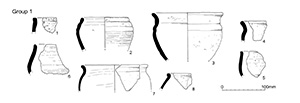 |
| 2 | MICW | Jar EF85 | |
| 3 | MICW | Jar EF83 | |
| 4 | MICW | Jar EF80 | |
| 5 | MICW | Jar EF77 | |
| 6 | GROG | Jar EF76 | |
| 7 | GROG | ?Pedestal jar | |
| 8 | GROG | Jar Cam 259 |
Cite this as: Biddulph, E., Compton, J. and Martin, T.S., 2015 The Late Iron Age and Roman Pottery, in M. Atkinson and S.J. Preston Heybridge: A Late Iron Age and Roman Settlement, Excavations at Elms Farm 1993-5, Internet Archaeology 40. http://dx.doi.org/10.11141/ia.40.1.biddulph1
The recording, analysis and reporting of the Late Iron Age and Roman pottery was undertaken by a number of people over an extended period of time. Initial recording and assessment was carried out by Colin Wallace. Recommendations for analytical work (see UPD in paper archive at Colchester and Ipswich Museum) were taken up and developed by Scott Martin (see UPD pottery addendum in paper archive). Recording by fabric and vessel form by context, and quantification of the assemblage, was subsequently carried out by the project's three pottery researchers, Edward Biddulph, Joyce Compton and Anne Thompson. Analysis and reporting was largely undertaken by Edward Biddulph and Joyce Compton, with Scott Martin contributing study of the latest Roman material. Additional study has been carried out on particular components of the assemblage by other specialists; their contributions are acknowledged where appropriate.
The Elms Farm excavations yielded more than 282,000 sherds of Late Iron Age and Roman pottery, weighing a total of 6.4 tonnes, from 4986 contexts. Of this, 269,070 sherds, weighing 5213kg, were stratified. This constitutes one of the largest single assemblages of Late Iron Age and Roman pottery to have been studied using modern quantification techniques in Essex and, indeed, in the region. The assemblage is comparable to the 5.7 tonnes of pottery used for detailed analysis at Colchester (Symonds and Wade 1999, 1) and far in excess of the 1.6 tonnes from Chelmsford (Going 1987, 1; 1992a, 93). Spanning the mid-1st century BC to late 4th century+, analysis of this assemblage has provided the opportunity to test critically and enhance current views of chronology and supply principally derived from studies of the pottery from Camulodunum/Colchester and Chelmsford.
The exceptional quality of the assemblage provided an opportunity to investigate a range of aspects for the pottery at Heybridge. Determining a ceramic sequence for the site and the pattern of pottery supply to the settlement were fundamental to the project aims. The analysis, however, was able to go beyond aspects of chronology and supply to explore issues of site development and daily life in the settlement. Pottery was an intermittent part of the local economy, with the presence of kilns confirming that the settlement produced, as well as received, ceramic vessels. Various studies have shown that pottery was used in diverse ways, functional in both ritual and mundane settings (see Vessel function and use). These studies have not been exhaustive and the recorded pottery data provide a comprehensive resource for further research.
The assemblage was recorded on an area-by-area basis (Areas D-R and W) using the divisions devised for excavation purposes. The stratified pottery was sorted into fabric groups and recorded by context to the basic level of sherd count and weight, in grams, following Study Group for Roman Pottery guidelines (1994). The information was recorded on pro forma sheets along with vessel class and form identifications, typological references, dating and other observations. Roman forms were classified using the Chelmsford type series (Going 1987, 13-54; Classes A-S), with the Camulodunum type series (Hawkes and Hull 1947, 215-75; updated by Bidwell and Croom 1999, 468-87) used principally for the Late Iron Age pottery. Roman forms not found in either were classified using regional typologies where possible, such as Monaghan's Upchurch/Thameside series (1987) and Young's Oxfordshire series (1977). Late Iron Age forms not present in the Camulodunum type series have been incorporated into a new site-specific typology published in this volume. Any forms not in the above can be found in the intrinsic pottery section. Unstratified pottery was recorded in less detail, with quantification in fabric groups by weight carried out for all of this material but with sherd counts and form identifications only partially undertaken.
Preliminary dating was undertaken at the time of basic recording and each group assigned to either single or multiple date ranges. The scheme, adopted purely for analytical purposes, comprised sixteen ceramic phases based upon the tripartite division of the centuries covered by the assemblage (i.e. mid-1st century BC to late 4th century+ AD). The detail of this ceramic phasing is held in the archive (x_code_ceramic_phases) and has been converted into a more robust scheme used throughout this report. The ceramic phasing scheme (CP) comprises eleven phases that follow the regional pattern as identified at Chelmsford (Going 1987, Ceramic Phases 1-8). Comparisons can also be made with the ceramic phasing scheme used at Colchester (Symonds and Wade 1999, Period Ending Groups 0-18). Context dating was refined by reference to the stratigraphic record.
| Elms Farm Site Period | Elms Farm CP | Chelmsford CP | Colchester PEG | Date Range |
|---|---|---|---|---|
| 1 | - | - | - | Palaeolithic-MIA |
| 2 | 1 | - | - | c. 50-15 BC |
| 2 | 2 | - | 0 | c. 15 BC-AD 20 |
| 2 | 3 | - | 3 | c. AD 20-55 |
| 3 | 4 | 1 | 4-5 | c. AD 55-80 |
| 3 | 5 | 2 | 5-8 | c. AD 80-125 |
| 3 | 6 | 3 | 9-10 | c. AD 125-170 |
| 4 | 7 | 4 | 9-10 | c. AD 170-210 |
| 4 | 8 | 5 | 10-12 | c. AD 210-260 |
| 5 | 9 | 6 | 13-14 | c. AD 260-310 |
| 5 | 10 | 7 | 14-16 | c. AD 310-360 |
| 6 | 11 | 8 | 16-18 | c. AD 360-400+ |
All well-dated, stratigraphically sound and relatively large groups were further quantified by Estimated Vessel Equivalence (EVE) using vessel rim measurements. The values for the percentage of extant rim, expressed as a proportion of a complete rim, and the rim diameter were entered onto a separate set of pro formas along with archive drawing numbers and details such as vessel decoration. A total of 314 fully quantified and described groups (representing 6% by context count or 22% by assemblage weight of the total assemblage) were thus selected. For the purposes of analysis, a further round of criteria subsequently identified a 'pool' of the 152 best groups, which were used to form the basic understanding of pottery supply to the settlement, and as a source of data in the study of the many aspects of pottery use. Forty of the most representative are published in detail, and illustrated, as Key Pottery Groups (KPG). Despite this selection, data drawn from the entire pottery assemblage continued to be used throughout the programme of analysis. That consistently good results were obtained is testament to the effectiveness of even a basic level of recording. To enable manipulation and interrogation of this very large assemblage, all collected data were entered onto FoxPro relational databases (see the archive).
The extensive archive includes the pottery, which has been ordered and boxed into type following the recording protocol. All sets of paper pro forma pottery record sheets are included, along with selected information used during recording and analysis. There are full dating evidence sections for each context/feature that contained pottery. A total of 1973 vessels were drawn as recording progressed.
This section presents a detailed list of the 100 fabrics and fabric groups recorded for the Late Iron Age and Roman pottery assemblage. Of these fabrics, at least thirty-seven were not included in the Chelmsford fabric series. Many would normally be found in contexts dated to the Late Iron Age and are, therefore, unlikely to have occurred at Chelmsford, which was not established until c. AD 60/5 (Going 1987; Drury 1988, 125-8). The Roman pottery volume for Colchester (Symonds and Wade 1999) provides a comprehensive list of the pottery from the colonia, but this too is inadequate in its description of Late Iron Age wares. The Fabrics section is presented in full below since it provides the most extensive list of Late Iron Age and Roman fabrics for the region. It supersedes the numeric system devised for Chelmsford (Going 1987, 3-11) and enhances the system used at Colchester (Symonds and Wade 1999, 2-5, 12). Each fabric is identified by a common name and a mnemonic code and use of this code is standard for all ECC Field Archaeology Unit projects. The scheme provides a high level of standardisation and facilitates easier comparison between sites.
Fabrics are listed in strict alphabetical order by fabric name, followed in brackets by the standard ECC Field Archaeology Unit mnemonic code. The corresponding Chelmsford fabric codes and the National Roman Fabric Reference Collection codes (Tomber and Dore 1998), the latter prefixed NRFRC, have then been appended where applicable. These provide the principal references for fabric descriptions. Fabrics have been described in full in the few instances where no description exists in either volume. A 'thumb-nail' biography for each fabric is provided, comprising a date range specific to Elms Farm, a list of forms present in that fabric, and a brief overview of its occurrence. Most fabrics were present in sufficient quantities to gain an overall date range. In the cases of fabrics where this is equivocal, for instance, where the appearance of a fabric is restricted to a few sherds, a generally accepted published date range, not specific to Elms Farm, is provided instead. Any differences between accepted chronologies and the date range of a fabric at Elms Farm are discussed, as are any notable aspects of form and fabric. The forms encountered in a given fabric are listed below the date. Roman forms were classified using the Chelmsford type series (Going 1987, 13-54), with the Camulodunum type series (Hawkes and Hull 1947) used principally for the Late Iron Age pottery. Roman forms not found in either were classified using regional typologies, where possible. Late Iron Age forms not present in the Camulodunum type series have been incorporated into a new site-specific typology published in this volume. These forms have the prefix EF, followed by the type number. Dragendorff (1895) form codes, which are used universally for samian vessels, have been simplified here. The common abbreviations (Drag. or Dr.) have not been used; Dragendorff forms are denoted solely by the prefix 'f'. Less common form codes, however, such as those delineated by Ludowici (1927) and Curle (1911), are given in full. Finally, a brief overview of the occurrence of a given fabric is provided, with its distribution noted where appropriate. Full distributions by site area for individual fabrics are contained in the archive.
Fabrics were identified and grouped on a macroscopic basis, aided by the use of x20 magnification where necessary. Most fabrics are based on pre-defined fabric divisions and are known by their common names or have direct equivalents published elsewhere. There are, however, some exceptions. Grog-tempered fabrics are not sufficiently represented at Chelmsford for the description offered by Going (1987, 10) to cover the full range of fabric variations. The fabric group has thus been given four subdivisions at Elms Farm in order to record fully these variations. Going's 'Romanizing wares', fabric codes 34 and 45, are now identified under the umbrella code for black-surfaced wares (BSW). During the recording stage for the purpose of analysis, mortaria were assigned specific fabric codes comprising the relevant fabric code and the suffix 'M'. Because mortaria are just one form within a product range, their fabric descriptions have been incorporated with the generic fabric group, where appropriate. This allows comment to be made on the full range of forms and the scale of production of individual industries. The descriptions for the amphora fabrics have been compiled with the assistance of Dr Paul Sealey, whose contribution is gratefully acknowledged. Condensed entries for these are given here, following the alphabetic system in Tomber and Dore (1998, 82-113); fuller descriptions for all of the amphora fabrics at Elms Farm are held in the archive. A limited programme of thin-sectioning was undertaken by Dr D.F. Williams of Southampton University. Summary results of this programme have been incorporated with the relevant fabric descriptions, where appropriate and the results for pottery from the kilns can be found in the relevant section. The full report by Dr Williams forms part of the research archive. The archive also contains a full list of the thin-sectioning results for selected vessels from pyre-debris pit 15417 (KPG5).
This section incorporates thirty-nine pottery groups spanning eleven ceramic phases, with one further group representing the immediate post-Roman period. These groups, encompassing seventy-eight contexts, were selected from an initial list of some 300 fully quantified contexts and are among the best in ceramic terms at Elms Farm. They have secure and narrow date-ranges, display low residuality (albeit increasing in the Late Roman phases), and are largely free of contamination. The groups are generally large, usually exceed a total weight of 2kg, and the pottery is in good condition. A further requirement for their inclusion here is that the pottery is illustrated, although Key Pottery Group 29 is the exception. A number of roles are served. An unrivalled collection of fully quantified groups is presented, and these form the basis for detailed comparison with the pottery from other sites. The uniform treatment accorded to both Late Iron Age and Roman groups has facilitated a consistent approach to subsequent analysis. Ordered chronologically, the groups provide 'snapshots' of shifting supply patterns and vessel use through time. Both typical and atypical groups within each ceramic phase are presented here. Typical groups are perhaps best described as conforming most closely to the 'average' for supply or assemblage composition in a given ceramic phase, as described in the next section. Conversely, atypical groups diverge from the average and are illustrated to highlight the diversity of pottery deposits.
Each of the Key Pottery Groups (KPG) has been assigned to a ceramic phase. Within each phase, the groups are ordered to reflect chronological progression. All of the groups follow a consistent format. A table accompanies each, in which the quantified data (sherd count, sherd weight, and EVE) is presented. This is followed by a summary of assemblage composition, dating evidence, and justification for selection. Comments on condition and fragmentation are based on recorded observations and average sherd weights. Most assemblages comprise the pottery from a single context; the remainder are composites of multiple fills within a feature. A summary is provided in Table 2 below. The prefix EF, used to designate Late Iron Age forms which are not attested at Camulodunum, refers to vessels catalogued in the Elms Farm typology. Full quantification of the Key Pottery Groups entailed measuring the extant section of the rim for all the vessels present. This measurement is normally known as Estimated Vessel Equivalence (EVE). The study at Elms Farm has used rim measurements only; bases are not included in the statistics.
The groups presented in this section provide some of the principal, but by no means all, data on which subsequent analysis was based. They have been of most use in drawing out trends in pottery supply and use, which form the basis of the Pottery Supply section. To ensure reliability when conducting this analysis, a pool of other fully quantified, well-dated groups was additionally used, expanding the dataset to 106 groups (183 contexts). These have been excluded from the pottery sequence because the selected KPGs adequately reflect pottery supply and use, or, more simply, because they are not illustrated. Full data for the wider pool can be found in the archive.
A feature of the Key Pottery Group is low residuality. The issue of residuality, itself a major component of the pottery analysis along with other aspects of context formation processes, cannot be dealt with satisfactorily by these groups alone. Studies of residuality, deposition and intra-site comparisons form part of the research archive.
| Ceramic phase | Chelm. CP | Colch. PEG | Key group | Feature | Contexts | Area | Date range |
|---|---|---|---|---|---|---|---|
| 1 | - | - | 1 | ditch 25094 | 19116, 19145 | P | c. 50-30 bc |
| 2 | ditch 25252 | 6875, 6907, 6957 | H | c. 50-25 bc | |||
| 3 | pit 8786 | 8785 | P | c. 30 bc | |||
| 4 | pit 11342 | 11329 | N | c. 25-10 bc | |||
| 2 | - | 0 | 5 | pit 15417 | 15416, 15418, 15420, 15490 | M | c. 10 bc-ad 5 |
| 6 | pit 11344 | 11343 | N | c. 5 bc-ad 10 | |||
| 7 | pit 9611 | 9585 , 9610 | D | c. AD 1-10 | |||
| 8 | pit 11316 | 11269, 11301 | N | c. AD 5-20 | |||
| 9 | pit 8282 | 8271 | E | c. AD 5-20 | |||
| 10 | pit 19104 | 19105, 19107, 19109, 19110, 19111 | P | c. AD 1-25 | |||
| 3 | - | 3 | 11 | pit 8026 | 8003 , 8014, 8018 | E | c. AD 20-40 |
| 12 | pit 9230 | 9231 | D | c. AD 20-45 | |||
| 13 | pit 7167 | 7168, 7178, 7179 | G | c. AD 25-45 | |||
| 14 | pit 11723 | 11720 | N | c. AD 45-55 | |||
| 4 | 1 | 4-5 | 15 | ditch 25018 | 9214 | D | c. AD 50/55-60 |
| 16 | pit 9218 | 9217, 9370 | D | c. AD 55-65 | |||
| 17 | pit 20008 | 20009 | L | c. AD 70 | |||
| 18 | pit 24013 | 24014 | M | c. AD 70-80 | |||
| 5 | 2 | 5-8 | 19 | pit 15773 | 24258 | M | c. AD 80-100 |
| 20 | pit 6201 | 6203 | H | c. AD 100-120 | |||
| 21 | pit 5147 | 5146 | J | c. AD 120/25 | |||
| 6 | 3 | 9-10 | 22 | ditch 25245 | 10182 | F | c. AD 120/5-150 |
| 23 | pit 7118 | 7119, 7116 | G | c. AD 155/60 | |||
| 24 | pit 9029 | 9028, 9064 | D | c. AD 140-160 | |||
| 7 | 4 | 9-10 | 25 | pit 7122 | 7123 | G | c. AD 170-200 |
| 26 | well 6280 | 16083 | H | c. AD 190-200 | |||
| 27 | stoke-hole 1589 | all deposits (20) | W | c. AD 190-210 | |||
| 8 | 5 | 10-12 | 28 | pit 6182 | 6178 | H | c. AD 200/10-230 |
| 29 | pit 16088 | 16073 | H | c. AD 210-250 | |||
| 30 | pit 10062 | 10061 | E | c. AD 250/60 | |||
| 9 | 6 | 13-14 | 31 | pit 11303 | 11302 | N | c. AD 250/70 |
| 32 | pit 6267 | 6268 | H | c. AD 260-300 | |||
| 33 | ditch 25270 | 12026, 12029 | R | c. AD 290-310 | |||
| 10 | 7 | 14-16 | 34 | pit 14125 | 4315 | K | c. AD 310-330 |
| 35 | pit 8745 | 8766 | P | c. AD 310-350 | |||
| 36 | pit 10067 | 10017 | E | c. AD 350-400 | |||
| 11 | 8 | 17-18 | 37 | pit 5209 | 5210 | J | c. AD 350-400 |
| 38 | gully 25079 | 15056 | M | c. AD 360/70-400 | |||
| 39 | well 5806 | 5763 | I | c. AD 370-400+ | |||
| post Roman | - | - | 40 | pit 14529 | 14528, 14558, 14613 | L | c. AD 400+ |
Thirteen groups, with a total weight of 51.5kg, and 21.51 EVE, have been assigned to this ceramic phase, of which four (21kg, 11.39 EVE) are presented below. Most assemblages comprise mainly coarse wares, with the occasional presence of Dressel 1 amphora and Central Gaulish imports. The majority of the groups assigned to the phase came from the southern zone of the settlement. Independent dating evidence occurs in the form of two coins, a Class I/II potin (SF5645) in ditch segment 16018, and a potin fragment (SF6841) in ditch segment 8208. Quantified groups of this date are few but comparisons may be drawn with the pottery types from the Airport Catering Site, Stansted (Going 2004) and Ditch 350 at Kelvedon (Rodwell 1988). Residuality in all groups is negligible, though earlier prehistoric pottery occurs in ditch segment 19144 in the form of three flint-tempered body sherds weighing 30g.
| Fabrics | Sherd no. | Weight (g) | Average sherd wt | % Weight | EVE | EVE % | Forms |
|---|---|---|---|---|---|---|---|
| ESH | 1 | 8 | 8 | <1% | 0.05 | 6% | Jar Cam 254 |
| GROG | 57 | 486 | 9 | 24% | 0.27 | 32% | Jars EF76 Cam 219 Cam 259 |
| GROGC | 31 | 784 | 25 | 39% | 0.03 | 4% | Jar Cam 255 |
| MICW | 37 | 744 | 21 | 37% | 0.49 | 58% | Jars EF77 EF80 EF83 EF85 |
| Total | 126 | 2020 | 0.84 |
This group is representative of the assemblages recovered from contexts dating to the transitional period between the middle and Late Iron Ages, although relatively few of these features were identified. A feasible date for this assemblage is c. 50-30 BC. This is the smallest Ceramic Phase 1 group and is composed entirely of jars, mainly handmade, of which sand-tempered coarse wares form a major component. Imports, including amphoras, are absent. The finer grog-tempered jars are fragmentary.
| Fabrics | Sherd no. | Weight (g) | Average sherd wt | % Weight | EVE | % EVE | Forms |
|---|---|---|---|---|---|---|---|
| AITAB | 1 | 314 | 314 | 7% | Dressel 1 | ||
| GROGRS | 4 | 16 | 4 | <1% | |||
| GROG | 124 | 1536 | 12 | 36% | 1.14 | 70% | Bowl EF41, jars EF79 EF104 EF106 Cam 229 G3 |
| GROGC | 111 | 2049 | 18 | 48% | 0.35 | 21% | Jar EF107 |
| MICW | 24 | 346 | 14 | 8% | 0.14 | 9% | Bowl EF31, jar EF98 |
| Total | 264 | 4261 | 1.63 |
Handmade jars again dominate this assemblage, although here the sand-tempered coarse wares form a much smaller proportion, giving way to grog-tempered fabrics. This is a trait that is common for the remainder of the ceramic phase. Dressel 1 amphora is present, but there are no other imports. The coin evidence suggests a date early in the ceramic phase, between perhaps 50 BC and 25 BC. Four small sherds (34g) of Roman grey ware present in the upper fills are clearly intrusive and have been excluded from the table.
| Fabrics | Sherd no. | Weight (g) | Average sherd wt | % Weight | EVE | % EVE | Forms |
|---|---|---|---|---|---|---|---|
| BUF | 1 | 6 | 6 | <1% | |||
| GROG | 292 | 4120 | 14 | 51% | 3.40 | 61% | Bowl Cam 231, jars EF81 EF82 EF86 EF89 EF110 EF138 EF139 |
| GROGC | 64 | 2170 | 34 | 27% | 0.13 | 2% | Jar Cam 270 |
| MICW | 78 | 1697 | 22 | 21% | 1.88 | 34% | Jars, handmade (MIA style) |
| NGWFS | 3 | 34 | 11 | <1% | 0.08 | 1% | Beaker Cam 113 |
| TNM | 1 | 30 | 30 | <1% | 0.12 | 2% | Platter Cam 1 |
| Total | 439 | 8057 | 5.61 |
This assemblage demonstrates a greater diversity of form and fabric. There are platters, bowls and beakers present alongside the jars. The latter are still mainly handmade, but now grog-tempered pottery forms the larger component. A small number of imports are present, accounting for just over 3% by EVE. The Central Gaulish Cam 1 platter is among the earliest imports to Britain, and the North Gaulish Cam 113 beaker is typologically early in form. The tiny sherd of buff ware may well be an import, possibly from an amphora. A date of c. 30 BC is proposed for the group. Substantial parts of several vessels are present, allowing for their reconstruction.
| Fabrics | Sherd no. | Weight (g) | Average sherd wt | % Weight | EVE | % EVE | Forms |
|---|---|---|---|---|---|---|---|
| AITAD | 2 | 84 | 42 | 1% | Dressel 1 | ||
| AMISC | 2 | 64 | 32 | 1% | |||
| CGFCS | 19 | 126 | 7 | 2% | 0.08 | 2% | Flagon Cam 165 |
| GROG | 180 | 3228 | 18 | 48% | 1.46 | 44% | Bowl Cam 211, jars Cam 220 Cam 249 Cam 256 Cam 264 G19 |
| GROGC | 100 | 2708 | 27 | 40% | 1.08 | 33% | Jars EF119 Cam 255 Cam 266 |
| GROGRS | 21 | 505 | 24 | 7% | 0.69 | 21% | Jar Cam 256, flagon handle |
| THORN | 1 | 8 | 8 | <1% | Beaker base | ||
| TRCG | 1 | 22 | 22 | <1% | Platter base | ||
| Total | 326 | 6745 | 3.31 |
Pottery Group 4 is typical of the later part of the Ceramic Phase 1 date range, perhaps 25-10 BC. It comprises a variety of grog-tempered forms, including the handle from a flagon, although jars still predominate. Sand-tempered coarse ware is no longer present in this particular group, and forms a very small proportion for the remainder of the phase in others. Imports are few, mainly Dressel 1 amphoras, while Central Gaulish vessels are more prevalent. The latter were imported into southern Britain from c. 25 BC (Rigby 1986b, 270). Increased diversity of form is apparent, typical of assemblages towards the final decades of the 1st century BC and later. The average sherd weight is generally high, but the flagon is fragmentary, demonstrating the fragile, thin-walled nature of these Central Gaulish vessels.
Fourteen groups, with a total weight of 155.8kg and 52.68 EVE, have been assigned to this ceramic phase. Six of these (101.5kg, 34.81 EVE) are presented below to illustrate the pottery which is characteristic of the phase, although the pottery from pit 15417 is, in many ways, atypical. Ceramic Phase 2 groups came mainly from the northern and southern settlement zones. Few assemblages of similar date have been quantified, but groups B50, C5 and C27 from Puckeridge-Braughing in Hertfordshire (Witherington and Trow 1988) provide comparable data. Assigned to this phase, though not presented here, is a cremation burial assemblage (8177) accompanied by fragments of an iron brooch-and-ring ensemble (SF7019) (see The brooches), which has been dated broadly late 1st century BC to early 1st century AD. In addition, two Colchester brooches (SF2393, SF378), dated c. AD 10-70 (see The brooches) occur in features assigned to this phase, one from pit 7415 and the other from pit 4026. Supporting dating evidence is provided by the presence of Arretine ware. Platter floor sherds from pit 9611 are dated to 15 BC-AD 20 and platter rim sherds from pits 7060 and 10288 are both dated to c. 15 BC-AD 10. Residuality is apparent in the later part of the phase, in particular the Dressel 1 amphora and sand-tempered pottery, and occasional earlier prehistoric sherds. The fragmentary nature of some of the grog-tempered pottery may also indicate residuality, although in this fabric this is harder to assess.
| Fabrics | Sherd no. | Weight (g) | Average sherd wt | % Weight | EVE | % EVE | Forms |
|---|---|---|---|---|---|---|---|
| AITAB | 139 | 10002 | 72 | 17% | Dressel 1 | ||
| AITAC | 152 | 11391M | 75 | 19% | 0.79 | 8% | Dressel 1 |
| AITAD | 528 | 20897 | 35 | 36% | 0.68 | 6% | Dressel 1 |
| CGFCS | 37 | 436 | 12 | 1% | 0.18 | 2% | Flagon Cam 165 |
| ESH | 50 | 930 | 19 | 2% | 0.76 | 7% | Jar Cam 255 |
| GROG | 356 | 11095 | 31 | 19% | 5.09 | 48% | Bowl Cam 253, jars Cam 204 Cam 218 Cam 220 Cam 221 Cam 259, beakers Cam 115 Cam 118, flagon EF196 |
| GROGC | 7 | 344 | 49 | 1% | |||
| IBUFM | 10 | 464 | 46 | 1% | 0.01 | <1% | Mortarium Cam 191-type (EF74) |
| PR | 25 | 630 | 25 | 1% | 0.48 | 5% | Platter EF23 |
| TNM | 2 | 128 | 64 | <1% | 0.28 | 3% | Platter Cam 1 |
| TR | 173 | 2026 | 12 | 4% | 1.93 | 18% | Platters Cam 2 Cam 5, beaker Cam 112 |
| MICW | 1 | 26 | 26 | <1% | |||
| NGWF | 4 | 100 | 25 | <1% | 0.30 | 3% | Beaker Cam 113 |
| Total | 1484 | 58469 | 10.50 |
This pottery, although almost certainly pyre debris, demonstrates the diversity of fabric and form associated with assemblages deposited at the beginning of Phase 2. This large collection of pottery can probably be dated to the very end of the 1st century BC or beginning of the 1st century AD. Grog-tempered pottery predominates at 48% by EVE, and there are substantial parts of three Dressel 1 amphoras present plus two other vessel types imported from Italy. These, a Pompeian-red ware platter and a wall-sided gritless mortarium, are both typologically early forms. There are also imports from Central Gaul, and Gallo-Belgic ware is now in evidence in the form of terra rubra. The sherd of sand-tempered coarse ware is residual in this feature. Although large and conjoining sherds from many of the vessels are present, the pottery has been burnt to varying degrees, resulting in distortion, discolouration and much splitting along heat-fractures.
| Fabrics | Sherd no. | Weight (g) | Average sherd wt | % Weight | EVE | % EVE | Forms |
|---|---|---|---|---|---|---|---|
| ARCAT | 1 | 449 | 449 | 5% | Pascual 1 | ||
| AWINE | 1 | 82 | 82 | 1% | |||
| CGFCS | 9 | 42 | 5 | <1% | Flagon handle | ||
| CGMIC | 36 | 242 | 7 | 3% | 0.47 | 11% | Beaker Cam 102 |
| GROG | 197 | 2710 | 14 | 29% | 2.26 | 51% | Platter Cam 21, dish EF26, jars G19 Cam 219 Cam 249, beaker Cam 115 |
| GROGC | 214 | 5501 | 26 | 58% | 1.29 | 29% | Jars EF116 Cam 255 Cam 271 G44 |
| IMIC | 1 | 14 | 14 | <1% | Balsamarium foot (Cam 196) | ||
| TN | 3 | 52 | 17 | 1% | |||
| TNM | 4 | 50 | 13 | 1% | 0.03 | 1% | Bowl Cam 51 |
| TR | 49 | 320 | 7 | 3% | 0.36 | 8% | Platter Cam 5, beaker Cam 112 |
| Total | 515 | 9462 | 4.41 |
This assemblage again exhibits characteristics that continue from Ceramic Phase 1, demonstrating the continuance of pottery types, such as Central Gaulish ware, into the first decades of the 1st century AD. Wine amphoras Pascual 1 and Dressel 2-4 have made an appearance and the wider range of Gallo-Belgic wares now includes terra nigra. Imports account for 13% of the assemblage by weight, but grog-tempered pottery predominates, as expected. The forms present include bowls and beakers along with the platters and jars. Many of these vessels are copies of imported forms. The finer vessels are fragmentary. The assemblage dates to the end of the 1st century BC into the first decade of the 1st century AD.
| Fabrics | Sherd no. | Weight (g) | Average sherd wt | % Weighth | EVE | % EVE | Forms |
|---|---|---|---|---|---|---|---|
| AITAL | 3 | 391 | 130 | 2% | Dressel 1 | ||
| AWINC | 4 | 120 | 30 | 1% | Dressel 2-4 | ||
| BSW | 4 | 132 | 33 | 1% | |||
| BUF | 1 | 8 | 8 | <1% | |||
| CGFCS | 36 | 895 | 25 | 6% | 0.54 | 7% | Flagon Cam 165 |
| CGMIC | 5 | 44 | 9 | <1% | 0.25 | 3% | Beaker Cam 102 |
| GROG | 256 | 3690 | 14 | 23% | 3.16 | 40% | Platters Cam 21 Cam 22, bowls Cam 230 Cam 214, jars EF103 EF153 EF154 Cam 249 Cam 229 G19 G20, lid |
| GROGC | 318 | 9763 | 31 | 61% | 2.23 | 28% | Jars Cam 218 Cam 219 Cam 255 Cam 259 G4, funnel N2 |
| GROGRF | 14 | 74 | 5 | <1% | |||
| GROGRS | 2 | 26 | 13 | <1% | 0.23 | 3% | Jar G19 |
| GRS | 2 | 10 | 5 | <1% | |||
| ITSW | 3 | 8 | 3 | <1% | Platter | ||
| NGWF | 4 | 16 | 4 | <1% | |||
| NGWFS | 5 | 31 | 6 | <1% | |||
| RED | 4 | 24 | 6 | <1% | |||
| STOR | 1 | 32 | 32 | <1% | |||
| TN | 3 | 44 | 15 | <1% | |||
| TNM | 5 | 374 | 75 | 2% | 0.57 | 7% | Platter Cam 1 |
| TR | 22 | 238 | 11 | 1% | 0.85 | 11% | Platters Cam 2 Cam 4, cup Cam 56, beakers Cam 82 Cam 112 |
| PREHIST | 1 | 20 | 20 | <1% | 0.02 | <1% | Small bucket urn |
| Total | 693 | 15940 | 7.85 |
This large assemblage falls in the middle of Ceramic Phase 2, perhaps spanning the first decade of the 1st century AD. Grog-tempered pottery again predominates at 85% by weight, and the range of imports has expanded to include North Gaulish fine white ware and Arretine. Central Gaulish vessels are still in evidence, and there is Dressel 2-4 amphora present along with the Dressel 1, although the latter must be residual by this time. This group contains a wide range of fabrics with a wider range of forms, including a specialised form, a funnel, in grog-tempered ware. Many grog-tempered forms are, again, copies of imports. The few Roman sherds present (fabrics BSW, GRS and STOR) are from the top fill and probably intrusive.
| Fabrics | Sherd no. | Weight (g) | Average sherd wt | % Weight | EVE | % EVE | Forms |
|---|---|---|---|---|---|---|---|
| AITAD | 3 | 114 | 38 | 1% | Dressel 1 | ||
| ARCAT | 2 | 227 | 114 | 3% | Pascual 1 | ||
| AWINC | 2 | 109 | 55 | 1% | Dressel 2-4 | ||
| CGFCS | 2 | 22 | 11 | <1% | 0.19 | 4% | Flagon Cam 165 |
| CGMIC | 31 | 274 | 9 | 4% | 0.57 | 12% | Beaker Cam 102 |
| GROG | 230 | 2847 | 12 | 37% | 1.75 | 38% | Bowl Cam 210, jars EF117 Cam 204 Cam 260, beakers EF189 Cam 85 Cam 115, flagon handle |
| GROGC | 160 | 3414 | 21 | 45% | 1.62 | 35% | Jars Cam 254 Cam 255 Cam 256 Cam 257 Cam 259 |
| GROGRS | 10 | 158 | 16 | 2% | 0.06 | 1% | Bowl Cam 43 |
| NGWF | 4 | 14 | 4 | <1% | |||
| PR | 1 | 30 | 30 | <1% | 0.06 | 1% | Platter Cam 17 |
| TN | 1 | 36 | 36 | <1% | 0.09 | 2% | Platter Cam 2 |
| TNM | 11 | 266 | 24 | 3% | 0.10 | 2% | Platters Cam 1 Cam 4, bowl Cam 51 |
| TR | 13 | 108 | 8 | 1% | 0.18 | 4% | Beaker Cam 82 |
| Total | 470 | 7619 | 4.62 |
This group illustrates the diversity of fabric and form typical of the mid- to later part of the ceramic phase (c. AD 5-20). Grog-tempered pottery continues to form the major component at 84% by weight. Platters appear in Gallo-Belgic fabrics only; grog-tempered copies are confined to beaker and bowl forms. The Cam 17 platter in Pompeian-red ware is a type more commonly imported from Italy from c. AD 40. The finer vessels are fragmentary, and the Dressel 1 amphora is residual.
| Fabrics | Sherd no. | Weight (g) | Average sherd wt | % Weight | EVE | % EVE | Forms |
|---|---|---|---|---|---|---|---|
| AITAL | 1 | 27 | 27 | <1% | 0.13 | 2% | Dressel 2-4 |
| AMISC | 1 | 18 | 18 | <1% | |||
| ASALA | 4 | 616 | 154 | 8% | Beltrán 1 | ||
| CGFCS | 1 | 32 | 32 | <1% | Flagon handle | ||
| CGMIC | 4 | 14 | 4 | <1% | |||
| GROG | 128 | 1914 | 15 | 24% | 4.12 | 63% | Platters EF6 Cam 21 Cam 31, jars Cam 218 Cam 221 Cam 232 Cam 264, strainer bowl M1 |
| GROGC | 77 | 5059 | 66> | 63% | 2.21 | 34% | Bowl EF28, jars EF133 Cam 255 Cam 259 Cam 270 |
| GROGRF | 4 | 10 | 3 | <1% | 0.01 | <1% | Beaker Cam 116 |
| NGWF | 12 | 136 | 11 | 2% | |||
| STOR | 2 | 138 | 69 | 2% | Jar Cam 270 | ||
| TR | 2 | 34 | 17 | <1% | 0.06 | 1% | Platter Cam 5 |
| Total | 236 | 7998 | 6.53 |
Although consisting mainly of grog-tempered ware (87% by weight), KPG9 is, again, characteristic of the mid- to later end of the date range. Several grog-tempered forms are types which continue into the mid-1st century AD. Salazon amphoras have made an appearance, although the range of imports is now less extensive. There is nothing obviously residual in the group.
| Fabrics | Sherd no. | Weight (g) | Average sherd wt | % Weight | EVE | % EVE | Forms |
|---|---|---|---|---|---|---|---|
| ABSAN | 1 | 12 | 12 | 1% | Dressel 2-4 | ||
| BUF | 3 | 30 | 10 | 1% | |||
| CGFCS | 5 | 87 | 17 | 4% | |||
| GROG | 79 | 1322 | 17 | 63% | 0.61 | 68% | Bowls EF46 Cam 211, jars EF135 Cam 218 Cam 249 Cam 256 |
| GROGC | 18 | 462 | 26 | 22% | 0.03 | 3% | Jar Cam 255 |
| MICW | 6 | 114 | 19 | 5% | 0.09 | 10% | Jar EF78 |
| NGWFS | 12 | 42 | 4 | 2% | Beaker EF195 | ||
| TNM | 1 | 8 | 8 | <1% | 0.02 | 2% | Platter Cam 1 |
| TR | 1 | 6 | 6 | <1% | 0.15 | 17% | Beaker Cam 112 |
| Total | 126 | 2083 | 0.90 |
Although relatively small, with a narrower range of fabrics, this assemblage is typical of Ceramic Phase 2, and is dated broadly to the first quarter of the 1st century AD. It is included here because the feature cuts ditch segment 19115 (Ceramic Phase 1). The assemblage, therefore, forms part of a ceramic sequence with the pottery from KPG1. The sand-tempered coarse ware (Figure 240, no. 8) is residual from this earlier feature.
Eleven groups, with a total weight of 60.3kg and 31.22 EVE, have been assigned to this ceramic phase, four of which (30.5kg, 14.76 EVE) are presented below. Phase 3 groups came mainly from the northern and southern zones. The phase is characterised by the gradual appearance of samian and various Roman fabrics, accompanied by a decline in other imported fine wares and amphoras. Two groups of pottery, Group 1 from ditch 1124 and Group 2 from slots 662/4, at Ivy Chimneys, Witham (Turner-Walker and Wallace 1999) provide broad comparisons. Independent dating evidence occurs in the form of a Langton Down brooch (SF7820) from pit 24181 and a coin of Cunobelin (SF2385) from pit 7167, both current in the first half of the 1st century AD. Additional dating is provided by the presence of Neronian samian in contexts assigned to the later part of the phase and the appearance of Verulamium region white ware and Central Gaulish glazed ware, both mid-1st century AD types. Grog-tempered pottery continues to form a major component, averaging 85%, of all assemblages assigned to this phase. Residuality is apparent in the presence of prehistoric pottery, handmade vessels and many of the Central Gaulish products.
| Fabrics | Sherd no. | Weight (g) | Average sherd wt | % Weight | EVE | % EVE | Forms |
|---|---|---|---|---|---|---|---|
| ABAET | 1 | 77 | 77 | 1% | Dressel 20 | ||
| AITAL | 1 | 11 | 11 | <1% | Dressel 2-4 | ||
| ASALA | 3 | 482 | 161 | 5% | |||
| CGFCS | 1 | 4 | 4 | <1% | |||
| CGMIC | 1 | 8 | 8 | <1% | |||
| ESH | 6 | 224 | 37 | 2% | 0.62 | 10% | Jar Cam 254 |
| GROG | 160 | 5712 | 36 | 58% | 3.31 | 55% | Platters EF16 Cam 32, bowls EF72 Cam 241/6, cup Cam 212, jars EF146 EF179 Cam 218 Cam 219 Cam 249 Cam 221, beakers Cam 116 Cam 118 Cam 119 |
| GROGC | 48 | 2931 | 61 | 30% | 1.41 | 24% | Jars Cam 259 Cam 258 Cam 271 G5 G44 |
| GROGRF | 3 | 132 | 44 | 1% | 0.12 | 2% | Bowl |
| GRS | 1 | 10 | 10 | <1% | 0.10 | 2% | Beaker H7 |
| NGWF | 2 | 76 | 38 | 1% | 0.08 | 1% | Beaker Cam 113 |
| SGSW | 2 | 2 | 1 | <1% | |||
| TN | 5 | 180 | 36 | 2% | 0.15 | 3% | Platter Cam 2 |
| TR | 4 | 24 | 6 | <1% | 0.18 | 3% | Beaker Cam 112 |
| Total | 238 | 9873 | 5.97 |
Pottery Group 11 is typical of the earliest part of Ceramic Phase 3, c. AD 20-40, and is dominated by grog-tempered pottery in a wide variety of forms. Imports are present in the form of Gallo-Belgic and Central Gaulish ware, although the latter is represented by small body sherds only. Salazon amphora sherds are present and Dressel 20 amphora has made an appearance, whereas Dressel 2-4 wine amphora is reduced to a single small body sherd. There are a few sherds in Roman fabrics, including a tiny sherd of south Gaulish samian, and Romanised forms in grog-tempered wares are increasingly evident. The average sherd weight is generally high, although the finer fabrics tend to be fragmentary.
| Fabrics | Sherd no. | Weight (g) | Average sherd wt | % Weight | EVE | % EVE | Forms |
|---|---|---|---|---|---|---|---|
| AITAL | 2 | 36 | 18 | 1% | Dressel 2-4 | ||
| BSW | 4 | 48 | 12 | 1% | |||
| GROG | 265 | 3306 | 12 | 66% | 1.73 | 73% | Bowls Cam 212 Cam 244, jars Cam 219 Cam 229 Cam 249, beaker Cam 115, lid K6 |
| GROGC | 44 | 1396 | 32 | 28% | |||
| GROGRS | 8 | 142 | 18 | 2% | 0.29 | 12% | Bowl EF73, flagon |
| GRS | 1 | 6 | 6 | <1% | |||
| RED | 1 | 4 | 4 | <1% | |||
| TR | 25 | 76 | 3 | 2% | 0.35 | 15% | Beaker Cam 112 |
| PREHIST | 3 | 18 | 6 | <1% | |||
| Total | 353 | 5032 | 2.37 |
Grog-tempered pottery in a variety of forms again predominates at 96% by weight. The group is dated broadly to c. AD 20-45. There is a narrow range of fabrics present; unusually, terra rubra is the sole imported fine ware type represented. Amphoras are again scarce and Roman fabrics are still very much in the minority. The pottery is fragmentary, but there is very little that is obviously residual, apart from three small flint-tempered body sherds of prehistoric date.
| Fabrics | Sherd no. | Weight (g) | Average sherd wt | % Weight | EVE | % EVE | Forms |
|---|---|---|---|---|---|---|---|
| ABAET | 4 | 108 | 27 | 1% | Dressel 20 | ||
| AITAL | 1 | 199 | 199 | 2% | Dressel 1 | ||
| AMISC | 1 | 22 | 22 | <1% | |||
| ASALA | 1 | 66 | 66 | 1% | |||
| BSW | 33 | 280 | 8 | 3% | |||
| BUF | 8 | 16 | 2 | <1% | |||
| CGFCS | 15 | 116 | 8 | 1% | |||
| GROG | 427 | 5850 | 14 | 59% | 2.78 | 82% | Platters Cam 21 Cam 33, bowls EF38 EF42 Cam 210 Cam 252, jars EF129 Cam 218 Cam 229 Cam 254 Cam 259 G17 G19, beakers EF188 H7 |
| GROGC | 39 | 1780 | 46 | 18% | 0.12 | 4% | Jar Cam 270 |
| GRS | 28 | 160 | 6 | 2% | |||
| MICW | 10 | 160 | 16 | 2% | 0.12 | 4% | Jar |
| NGWF | 4 | 24 | 6 | <1% | |||
| NGWFS | 2 | 6 | 3 | <1% | |||
| STOR | 26 | 1095 | 42 | 11% | |||
| TN | 1 | 22 | 22 | <1% | |||
| TNM | 5 | 34 | 7 | <1% | 0.06 | 2% | Platter EF20, beaker EF192 |
| TR | 8 | 48 | 6 | <1% | 0.30 | 9% | Platter Cam 8, cup Cam 56, beaker Cam 112 |
| Total | 613 | 9986 | 3.38 |
Dressel 20 and salazon amphoras are present in this assemblage, but the sherd of Dressel 1 wine amphora is residual. Although grog-tempered pottery continues to predominate, Roman fabrics are beginning to form an increased part of the assemblage. Imports are again represented mainly by body sherds, while the forms present in Gallo-Belgic ware are the latest types to be produced. The newly identified forms in micaceous terra nigra may reflect the continuance of this industry beyond the first two decades AD. The group is dated to c. AD 25-45. Besides the Dressel 1, only the handmade jars are likely to be residual.
| Fabrics | Sherd no. | Weight (g) | Average sherd wt | % Weight | EVE | % EVE | Forms |
|---|---|---|---|---|---|---|---|
| ABAET | 6 | 229 | 38 | 4% | Dressel 20 | ||
| AWINE | 1 | 30 | 30 | 1% | Dressel 2-4 | ||
| BSW | 24 | 228 | 10 | 4% | |||
| CGFCS | 1 | 4 | 4 | <1% | |||
| CGGLZ | 1 | 2 | 2 | <1% | |||
| CGMIC | 3 | 16 | 5 | <1% | 0.11 | 4% | Jar Cam 262 |
| COLB | 1 | 4 | 4 | <1% | |||
| GROG | 171 | 2361 | 14 | 42% | 2.06 | 68% | Platters Cam 21 A2, bowl Cam 212, jars Cam 249 Cam 258 G19 |
| GROGC | 82 | 2158 | 26 | 38% | 0.40 | 13% | Jar Cam 260 |
| GROGRF | 3 | 30 | 10 | 1% | 0.10 | 3% | Beaker Cam 116 |
| GROGRS | 3 | 76 | 25 | 1% | 0.08 | 3% | Bowl EF71 |
| GRS | 18 | 246 | 14 | 4% | 0.23 | 8% | Jar G23, lid |
| NGWF | 3 | 10 | 3 | <1% | |||
| NGWFS | 2 | 14 | 7 | <1% | Beaker Cam 113 | ||
| RED | 2 | 1 | 1 | <1% | |||
| SGSW | 4 | 36 | 9 | 1% | 0.06 | 2% | Platter f18R, bowl f29 |
| STOR | 6 | 168 | 28 | 3% | |||
| TNM | 2 | 30 | 15 | 1% | |||
| Total | 333 | 5643 | 3.04 |
This group is characteristic of pottery assemblages at the later end of Ceramic Phase 3. Most of the identifiable forms are mid-1st century types and the assemblage is dated to c. AD 45-55. Much of the imported fine ware is likely to be residual, except for the North Gaulish beakers and the samian. Roman fabrics are more in evidence, forming more than 12% of the assemblage by weight. Samian and Central Gaulish glazed wares are both present, but in general, the quantity of imports is in decline. There is Dressel 20 amphora, but wine amphoras are again represented by a single small sherd, and there is a smaller range of forms than previously in grog-tempered wares. The finer wares are again fragmentary. It should perhaps be noted that the small sherds of samian have been dated to AD 60-80.
Fifteen groups, mainly from the central and southern settlement zones, with a total weight of 118kg and vessel rim equivalence (EVE) of 86.5, have been assigned to Ceramic Phase 4. Four of these groups, totalling 40.5kg and 32 EVE, are presented below. Ceramic Phase 4 is a period of continuity and change: sand replaces grog as the predominant tempering agent by the end of the phase, but many of the forms are little altered from Phase 3. Chelmsford provides a number of comparable assemblages; namely groups 1-3 (Going 1987, table 3) and the pottery from ditch K205 (Going 1992a, 96).
| Fabrics | Sherd no. | Weight (g) | Average sherd wt | % Weight | EVE | % EVE | Forms |
|---|---|---|---|---|---|---|---|
| ASALA | 1 | 159 | 159 | 2% | Salazon | ||
| BSWM | 29 | 536 | 18 | 8% | 0.53 | 21% | Jar G20 |
| BUF | 1 | 2 | 2 | <1% | |||
| COLB | 9 | 44 | 5 | 1% | Flagon | ||
| ESH | 1 | 18 | 18 | <1% | |||
| GRF | 5 | 78 | 16 | 1% | 0.19 | 7% | Bowl EF57, jar G19 |
| GROG | 126 | 1680 | 13 | 26% | 0.92 | 36% | Platter A2, bowl C19, jars G19 G20 Cam 232 |
| GROGC | 30 | 1165 | 39 | 18% | 0.48 | 18% | Jars G45 Cam 259 |
| GRS | 10 | 182 | 18 | 3% | |||
| RED | 3 | 16 | 5 | <1% | |||
| STOR | 70 | 2650 | 38 | 41% | 0.46 | 18% | Jars EF126 EF178 G3 |
| Total | 285 | 6530 | 2.58 |
Pottery Group 15 is typical of the early part of Ceramic Phase 4. Measured by EVE, grog-tempered pottery predominates, though less so than in Phase 3; conversely, black-surfaced ware and storage jar fabrics form a larger proportion. A greater range of wheel-thrown sand-tempered pottery is also present in sandy and fine grey wares and buff ware, though still in relatively small proportions, while imports typical of the Late Iron Age are noticeably absent. A date of c. AD 50/55-60 is supported by the presence of the salazon amphora, as well as the remaining forms. The condition of the pottery is generally good, and the group is coherent with no obvious residual element.
| Fabrics | Sherd no. | Weight (g) | Average sherd wt | % Weight | EVE | % EVE | Forms |
|---|---|---|---|---|---|---|---|
| BSW | 73 | 858 | 12 | 5% | 0.90 | 7% | Jar G3, beaker H1 |
| BUF | 12 | 39 | 3 | <1% | |||
| COLB | 96 | 297 | 3 | 1% | 0.43 | 3% | Bowl, flagon |
| GRF | 72 | 274 | 4 | 1% | 1.40 | 10% | Bowl EF64, beaker H1 |
| GROG | 580 | 5430 | 9 | 26% | 6.15 | 44% | Platters Cam 21 A2, jars EF131 Cam 249 Cam 258 G3 G19 G20, beakers H1 H7, funnel N2 |
| GROGC | 240 | 5887 | 25 | 28% | 3.19 | 23% | Bowl C33, jars Cam 249 Cam 259 G45, lid K3 |
| GROGRS | 4 | 28 | 7 | <1% | 0.11 | 1% | Jar Cam 249 |
| GRS | 26 | 418 | 16 | 2% | 0.57 | 4% | Jar G20 |
| SGSW | 31 | 324 | 10 | 2% | 0.24 | 2% | Platter f15/17, bowls f29 f30, cups f27 Ritt.8 |
| STOR | 210 | 7470 | 36 | 35% | 0.73 | 5% | Jars Cam 270B Cam 271 G44 |
| TN | 2 | 15 | 8 | <1% | 0.06 | <1% | Platter Cam 13 |
| TR | 12 | 48 | 4 | <1% | 0.11 | 1% | Beaker Cam 112 |
| TRCG | 1 | 4 | 4 | <1% | |||
| Total | 1359 | 21092 | 13.89 |
Grog-tempered pottery continues to dominate, but wheel-thrown, sand-tempered forms and fabrics are now common. Gallo-Belgic imports are barely represented and the forms present are among the latest to be produced. South Gaulish samian ware is present, with the range of forms falling within a date band of AD 45-80. The assemblage as a whole can probably be dated more closely to AD 55-65 because of the presence of two Colchester B brooches (SF1553, SF3281). Jars, beakers and platters are still the most common vessel classes, but bowls, cups and flagons are also much in evidence. There is also a grog-tempered ware funnel. The pottery is fragmentary and the small Central Gaulish sherd is residual.
| Fabrics | Sherd no. | Weight (g) | Average sherd wt | % Weight | EVE | % EVE | Forms |
|---|---|---|---|---|---|---|---|
| BSW | 202 | 5200 | 26 | 49% | 6.66 | 53% | Platter A2, bowls C27 Cam 214, jars G17 G19 G20, beaker H1, lid K6 |
| COLB | 24 | 346 | 14 | 3% | 1.00 | 8% | Flagon J3 |
| GRF | 19 | 1590 | 84 | 15% | 3.11 | 25% | Bowl C12, jars G20 G40 |
| GROG | 36 | 432 | 12 | 4% | 0.33 | 3% | Platter A2, jar G, lid K3 |
| GROGC | 15 | 620 | 41 | 6% | 0.03 | <1% | Jar |
| GRS | 50 | 1925 | 39 | 18% | 1.15 | 9% | Jars G17 G23 |
| HGG | 1 | 8 | 8 | <1% | |||
| IMIC | 3 | 8 | 3 | <1% | Beaker H1 | ||
| NGWF | 1 | 20 | 20 | <1% | |||
| SGSW | 2 | 12 | 6 | <1% | 0.14 | 1% | Platter f18 |
| STOR | 6 | 525 | 88 | 5% | 0.06 | <1% | |
| Total | 359 | 10686 | 12.48 |
This assemblage, dating to c. AD 70, demonstrates both typical and atypical aspects of the later part of this ceramic phase. Typically, grog-tempered pottery now forms a minor component, while wheel-thrown, sand-tempered pottery predominates. The assemblage is atypical in that it comprises eleven complete or near-complete vessels, with some of the remaining pottery being sufficiently preserved to gain complete profiles of another three vessels. The very low quantity of sandy grey ware is also unusual, and perhaps reinforces the view that most or all of the assemblage was deposited under special conditions, and cannot be regarded as a mundane rubbish deposit. There were a number of sherds in this feature that joined sherds in contemporaneous pit 20010; the mica-dusted beaker sherd from this feature is included for illustration here (Figure 247, no. 15).
| Fabrics | Sherd no. | Weight (g) | Average sherd wt | % Weight | EVE | % EVE | Forms |
|---|---|---|---|---|---|---|---|
| ABAET | 1 | 12 | 12 | 1% | Dressel 20 | ||
| BSW | 55 | 556 | 10 | 25% | 0.34 | 11% | Platter A4, dish B8, jar, lid K3 |
| BUF | 6 | 12 | 2 | 1% | 0.11 | 4% | |
| BUFM | 2 | 60 | 30 | 3% | 0.03 | 1% | Mortarium D1 |
| COLB | 2 | 20 | 10 | 1% | |||
| GRF | 11 | 174 | 16 | 8% | 0.57 | 19% | Cup, jar G20 |
| GROG | 23 | 102 | 4 | 5% | 0.28 | 9% | Jar |
| GROGC | 5 | 148 | 30 | 7% | 0.03 | 1% | |
| GRS | 33 | 526 | 16 | 23% | 1.18 | 39% | Platter A2, jar G3, beaker H1, lid K6 |
| SGSW | 2 | 14 | 7 | 1% | 0.39 | 13% | Bowl f35 |
| STOR | 4 | 156 | 39 | 7% | |||
| VRWM | 2 | 394 | 197 | 18% | 0.08 | 3% | Mortarium D1 |
| Total | 146 | 2174 | 3.01 |
A large quantity of pottery was collected from pit 24013, and can be placed at the later end of Ceramic Phase 4. Grog-tempered pottery is present, but only in small quantities, while wheel-thrown, sand-tempered fabrics are predominant. The range of forms is wide. The Verulamium region white ware mortarium, with its deep and hooked flange, is one of the earliest products of that industry, dating to the pre-Flavian and early Flavian periods (Davies et al. 1994, 47). This, plus the samian bowl, which is dated no earlier than c. AD 70, provides an AD 70-80 date range for the deposition of the whole assemblage. As with KPG16, the condition of the group is poor, though fairly consistent. There is little that can easily be dismissed as residual, though the grog-tempered pottery could well be.
Seventeen groups from the central and southern zones, with a total weight of 864kg and vessel rim equivalence (EVE) of 55.19 have been assigned to Ceramic Phase 5. Three of these groups, totalling 200kg and 21 EVE, are presented below. Phase 5 covers a period of c. 45 years, but, despite this, there are few distinctions between individual pottery assemblages. Locally produced sand-tempered pottery predominates in all groups, and is accompanied by much smaller proportions of regional and imported wares. Groups 4 and 5 from Chelmsford provide comparable assemblages (Going 1987, table 3).
| Fabrics | Sherd no. | Weight (g) | Average sherd wt | % Weight | EVE | % EVE | Forms |
|---|---|---|---|---|---|---|---|
| BSW | 29 | 615 | 21 | 30% | 1.18 | 55% | Jars G16 G17 G19 G20 G23 |
| COLB | 5 | 98 | 20 | 5% | |||
| GRF | 6 | 72 | 12 | 3% | Beaker | ||
| GROG | 3 | 36 | 12 | 2% | |||
| GROGC | 5 | 146 | 29 | 7% | Jar | ||
| GRS | 18 | 515 | 29 | 25% | 0.63 | 30% | Platter A2, jars G17 G20 |
| RED | 3 | 88 | 29 | 4% | 0.27 | 13% | Flagon J3 |
| SGSW | 1 | 10 | 10 | <1% | Platter f15/17 or f18 | ||
| STOR | 5 | 240 | 48 | 12% | 0.05 | 2% | |
| VRW | 6 | 254 | 42 | 12% | Flagon | ||
| TotaL | 81 | 2074 | 2.13 |
This assemblage dates to the early part of this ceramic phase, probably no later than c. AD 100. As expected for a group of this date, black-surfaced ware predominates with sandy grey ware forming a significant contribution, while the quantities of grog-tempered wares are small. The range of forms, mainly comprising high-shouldered jars, is typical. There is seemingly little or no obvious difference in the coarse wares between this group and those assigned to the end of Phase 4. The samian platter, however, dating to the late 1st century AD, provides the strongest evidence for pushing the date of deposition beyond AD 80. A coin of Domitian (SF7934) from an overlying fill does not conflict with this date. The condition of the assemblage is generally good, with nothing apart from the grog-tempered pottery that is obviously residual.
| Fabrics | Sherd no. | Weight (g) | Average sherd wt | % Weight | EVE | % EVE | Forms |
|---|---|---|---|---|---|---|---|
| ASALA | 2 | 150 | 75 | 3% | Salazon | ||
| BSW | 130 | 1230 | 9 | 24% | 2.01 | 46% | Platter A2, jars G17 G20 G23, beaker H1 |
| BUF | 23 | 76 | 3 | 1% | |||
| CGSW | 1 | 58 | 58 | 1% | Platter f18/31 | ||
| GRF | 1 | 2 | 2 | <1% | |||
| GROGC | 1 | 22 | 22 | <1% | |||
| GRS | 90 | 2205 | 25 | 42% | 2.06 | 48% | Jars G8 G17 G23, lid K |
| NKG | 1 | 4 | 4 | <1% | |||
| RED | 3 | 16 | 5 | <1% | 0.15 | 3% | Bowl C |
| SGSW | 3 | 28 | 9 | <1% | Platter f15/17 | ||
| STOR | 28 | 1540 | 55 | 29% | 0.11 | 3% | Jar G44 |
| Total | 283 | 5331 | 4.33 |
This group is dated to the early 2nd century, probably no later than c. AD 120. Composition is similar to that from earlier dated Roman period assemblages. Once again the samian evidence is fundamental, with the Central Gaulish platter providing an AD 100-120 date. The condition of the group is somewhat variable. Fabrics such as buff ware, North Kent grey ware and black-surfaced ware comprise small sherds, while sandy grey ware has a noticeably higher average sherd weight. Obviously residual pottery includes the grog-tempered ware, the amphora and South Gaulish samian platter, all of which are dated no later than AD 70.
| Fabrics | Sherd no. | Weight (g) | Average sherd wt | % Weight | EVE | % EVE | Forms |
|---|---|---|---|---|---|---|---|
| BB2 | 1 | 12 | 12 | <1% | 0.05 | <1% | Dish B2 |
| BSW | 537 | 6825 | 13 | 54% | 8.77 | 61% | Platter A2, dishes B1 B7, bowls C1 C6 C12, jars G16 G19 G20 G23, beaker H1, lid K3 |
| BUF | 8 | 54 | 7 | <1% | |||
| BUFM | 5 | 580 | 116 | 5% | 0.09 | 1% | Mortarium D1 |
| CGSW | 7 | 84 | 12 | 1% | 0.29 | 2% | Dishes f18/31R f18/31 or f31, bowl f37, cup |
| COLB | 46 | 615 | 13 | 5% | Flagon handle | ||
| GRF | 19 | 256 | 13 | 2% | 0.72 | 5% | Platter A2, jar, beaker H1 |
| GROG | 4 | 40 | 10 | 0.08 | 1% | Jar | |
| GRS | 125 | 2780 | 22 | 22% | 3.54 | 25% | Dish B7, jars G20 G23 G24 |
| LOND | 3 | 16 | 5 | ||||
| NKG | 5 | 136 | 27 | 1% | 0.34 | 2% | Platter A4 |
| NKO | 1 | 20 | 20 | <1% | 0.11 | 1% | Bowl |
| SGSW | 13 | 220 | 17 | 2% | 0.37 | 3% | Platters f15/17 f18, dish f36, bowl f30, cup f27g |
| STOR | 8 | 860 | 108 | 7% | |||
| VRW | 1 | 70 | 70 | 1% | Flagon handle | ||
| Total | 783 | 12568 | 14.36 |
Pottery Group 21, dating to c. AD 120/25, is the latest within this ceramic phase. It retains elements that date to the early 2nd century or earlier - platters, high-shouldered jars and North Kent wares - and yet includes pottery types, specifically BB2 and Central Gaulish samian, that take the date to the beginning of Phase 6. The BB2 dish has lattice decoration and a rim that is triangular in profile. Dishes of this description (Cam 37A) are dated to the Trajanic/Hadrianic period (Bidwell and Croom 1999, 469). None of the Central Gaulish samian pre-dates AD 120. The condition of the assemblage is fairly uniform. As for KPG20, there is less sandy grey ware than black-surfaced ware but, considering its higher average sherd weight, the sandy grey ware seems to be better preserved. The grog-tempered pottery is residual, as is some or all of the south Gaulish samian. The context also included 4g of intrusive late Roman Oxford ware derived from overlying features. This has been excluded from the tables.
Twelve groups, mainly from the northern settlement zone and with a total weight of 65.8kg and vessel rim equivalence (EVE) of 50.4, were assigned to Ceramic Phase 6. Four of these, totalling 52kg and 39 EVE, are presented below. As in Phase 5, assemblages comprise locally produced pottery, with varying, but always much smaller, proportions of regional and imported wares. This remains very much the pattern until the end of the Roman period. The groups below are comparable to a number of assemblages from Chelmsford, namely groups 6-8 (Going 1987, table 3) and the pottery from pit K90.2 (Going 1992a, 99-104).
| Fabrics | Sherd no. | Weight (g) | Average sherd wt | % Weight | EVE | % EVE | Forms |
|---|---|---|---|---|---|---|---|
| BB2 | 30 | 509 | 17 | 2% | 1.16 | 6% | Dishes B2 B3 |
| BSW | 363 | 4267 | 12 | 20% | 7.57 | 38% | Platter A4, dishes B4 B7 B9, jars G16 G18 G23 G40, beaker H7, lid K3, miniature |
| BUF | 10 | 42 | 4 | <1% | |||
| CGSW | 16 | 148 | 9 | 1% | 0.60 | 3% | Dishes f31 f42, bowls f37 f78, cup f33 |
| COLC | 26 | 68 | 3 | <1% | 0.74 | 4% | Beaker H20 |
| GRF | 36 | 276 | 8 | 1% | 0.53 | 3% | Dish B10, jar G29, beakers H6 H34/H35 |
| GROG | 21 | 260 | 12 | 1% | Jar | ||
| GRS | 403 | 6185 | 15 | 30% | 7.52 | 37% | Dish B4, bowl C16, jars G20 G22 G23 G24 G29 G42, lid K3 |
| LESTA | 8 | 256 | 32 | 1% | 0.41 | 2% | Bowl C23 |
| NKG | 36 | 384 | 11 | 2% | 0.55 | 3% | Platter A4, beaker H6 |
| RED | 2 | 4 | 2 | ||||
| SGSW | 16 | 148 | 9 | 1% | 0.22 | 1% | Platter f15/17 or f18, dish f42, bowl f37 |
| STOR | 206 | 8530 | 41 | 40% | 0.53 | 3% | Jars G42 G44 G45 |
| VRW | 1 | 8 | 8 | <1% | |||
| VRWM | 1 | 212 | 212 | 1% | |||
| Total | 1175 | 21297 | 19.83 |
Ditch segment 10159 contained a large amount of pottery dating to c. AD 125-150. The assemblage includes a range of pottery typical of an early to mid-2nd century context, comprising bead-rimmed dishes, poppy-headed beakers, and flasks or narrow-necked jars. The presence of Colchester colour-coated ware, however, which was not widely distributed before AD 150/60, pushes the date of deposition towards the end of the offered date range. The folded H34/H35 beaker is unusual in this deposit; the type first appears in Chelmsford c. AD180 (Going 1987, 31). The condition of the assemblage is mixed, with a variable average sherd weight. The grog-tempered pottery and some of the South Gaulish samian, such as the f15/17 platter, are residual. The assemblage has been interpreted as a possible ritual deposit.
| Fabrics | Sherd no. | Weight (g) | Average sherd wt | % Weight | EVE | % EVE | Forms |
|---|---|---|---|---|---|---|---|
| ABAET | 5 | 644 | 129 | 10% | Dressel 20 | ||
| BB2 | 10 | 390 | 39 | 6% | 0.85 | 14% | Dishes B1B2 B4 |
| BSW | 68 | 1244 | 18 | 19% | 2.09 | 35% | Dish B4, jars G5 G9 G20 G29 G40 |
| CGSW | 18 | 184 | 10 | 3% | 0.66 | 11% | Dishes f18/31 f18/31R or 31R f31, bowl f37, cup f33 |
| COLB | 1 | 62 | 62 | 1% | Flagon neck | ||
| COLBM | 5 | 228 | 46 | 4% | 0.29 | 5% | Mortaria D1 D13 |
| COLC | 4 | 14 | 4 | <1% | 0.28 | 5% | Beaker H20 |
| COLSW | 6 | 44 | 7 | 1% | 0.18 | 3% | Dish f18/31 or f31 |
| GRF | 3 | 48 | 16 | 1% | |||
| GROGC | 1 | 54 | 54 | 1% | 0.06 | 1% | Jar |
| GRS | 34 | 706 | 21 | 11% | 0.73 | 12% | Dish B2/B4, jar G23, lid |
| HAWO | 2 | 34 | 17 | 1% | |||
| MWSRS | 1 | 6 | 6 | <1% | |||
| NKG | 9 | 56 | 6 | 1% | 0.19 | 3% | Beaker H6 |
| RED | 9 | 30 | 3 | <1% | 0.16 | 3% | Beaker ?H20 |
| STOR | 41 | 2720 | 66 | 41% | 0.46 | 8% | Jar G42 G45 |
| Total | 217 | 6464 | 5.95 |
Pit 7119 contained three fills, the pottery from two of which was quantified by EVE and has been amalgamated here. The assemblage provides a mid-2nd century date for filling, with the Central Gaulish samian recovered from the top fill, dating the final episode of deposition to around AD 155/60 or a little later. Mid-2nd century pottery groups at Elms Farm generally display a greater range of fabrics, particularly Colchester wares, than earlier dated contexts and KPG23 is no exception. While black-surfaced ware predominates, sandy grey ware forms a lower proportion measured by EVE than is usual. Conversely, BB2 forms a higher proportion. Some jar types, such as the high-shouldered G20, were residual at Chelmsford by the mid-2nd century, and are likely to be here also, as is the grog-tempered pottery.
| Fabrics | Sherd no. | Weight (g) | Average sherd wt | % Weight | EVE | % EVE | Forms |
|---|---|---|---|---|---|---|---|
| ABAET | 2 | 376 | 188 | 2% | Dressel 20 | ||
| BB1 | 1 | 6 | 6 | <1% | |||
| BB2 | 9 | 300 | 33 | 2% | 0.22 | 3% | Dish B4 |
| BSW | 145 | 1296 | 9 | 7% | 2.43 | 31% | Dish B4, jars G19 G23 G29 |
| BUF | 5 | 6 | 1 | <1% | |||
| CGSW | 13 | 112 | 9 | 1% | 0.50 | 6% | Cup f33, dishes f19/31R or f31R f31, bowl f37 |
| COLB | 4 | 76 | 19 | <1% | |||
| COLBM | 4 | 128 | 32 | 1% | |||
| COLC | 6 | 80 | 13 | <1% | 0.09 | 1% | Beaker H20 |
| COLSW | 5 | 36 | 7 | <1% | 0.22 | 3% | Cup f27 |
| EGSW | 1 | 64 | 64 | <1% | Dish f32 | ||
| GRF | 7 | 60 | 9 | <1% | Dish B2/B4 | ||
| GROG | 13 | 274 | 21 | 1% | 0.07 | 1% | Bowl |
| GRS | 190 | 2754 | 19 | 14% | 2.15 | 28% | Dishes B3 B7, bowl C1, jars G5 G19 G22 G23, beaker |
| GRSWSM | 1 | 132 | 132 | 1% | 0.08 | 1% | Mortarium D1 |
| MIC | 1 | 6 | 6 | <1% | |||
| NKG | 12 | 158 | 13 | 1% | 0.71 | 9% | Jar G40, beaker H5 |
| STOR | 151 | 13510 | 89 | 70% | 1.28 | 17% | Jars G36 G44 |
| Total | 570 | 19374 | 7.75 |
This assemblage, a composite of two fills from pit 9029, is dated c. AD 140 to c. AD 160. The date of deposition is likely to be at the later end of this range, or slightly beyond. The East Gaulish samian dish from the bottom fill is one of the latest pieces and dates from AD 160 onwards. The range of pottery present, such as bead-rimmed dishes and the roughcast colour-coated beaker, is very typical of this period. The large quantity of storage jar fabric is, however, unexpected. Assemblage condition is mixed. Fabrics such as black-surfaced ware and fine grey ware are represented by small sherds, and there is a quantity of clearly residual pottery (10% by EVE), notably the grog-tempered pottery and the high-shouldered G19 coarse ware jars.
Six groups recovered from across the settlement, with a total weight of 46kg and rim equivalence (EVE) of 31.32, were assigned to Ceramic Phase 7. Three of these, totalling 35kg and 22.5 EVE, are presented below. These groups are comparable to Great Dunmow Group 464/820 (Going and Ford 1988, 61-6) and groups 9-16 from Chelmsford (Going 1987, table 3).
| Fabrics | Sherd no. | Weight (g) | Average sherd wt | % Weight | EVE | % EVE | Forms |
|---|---|---|---|---|---|---|---|
| BSW | 105 | 2390 | 23 | 16% | 2.00 | 23% | Dish B1, jars G19 G23 |
| BUF | 2 | 60 | 30 | <1% | 0.09 | 1% | Bowl Cam 198 |
| CGSW | 2 | 20 | 10 | <1% | 0.06 | 1% | Dish f18/31 or 31, cup f33 |
| COLB | 2 | 6 | 3 | <1% | |||
| COLBM | 21 | 1845 | 88 | 12% | 1.11 | 13% | Mortaria D1 D2 D13 |
| COLC | 16 | 224 | 14 | 2% | 0.45 | 5% | Beaker H20 |
| COLSW | 1 | 4 | 4 | <1% | Bowl f37 | ||
| GROG | 4 | 56 | 14 | <1% | 0.13 | 2% | Jar G |
| GROGC | 1 | 52 | 52 | <1% | |||
| GRS | 286 | 8815 | 31 | 58% | 3.62 | 42% | Jars G5 G17 G22 G23 G24 G25, lid K6 |
| LOND | 1 | 10 | 10 | <1% | Bowl C | ||
| MIC | 1 | 20 | 20 | <1% | 0.12 | 2% | Bowl Cam 41 |
| MWSRS | 2 | 24 | 12 | <1% | 1.00 | 12% | Flagon J4 |
| STOR | 20 | 1775 | 89 | 12% | 0.07 | 1% | Jar G44 |
| Total | 464 | 15301 | 8.65 |
This group is dated to the late 2nd century AD. The offered date is supported by the presence of types produced at Heybridge during the late 2nd or early 3rd century, namely the D13 wall-sided mortarium, the G5 ledge-rimmed jar, and G25 jar (see Pottery production). Black-surfaced ware, always so dominant in previous groups, is relegated to second place after sandy grey ware, while, as expected, Colchester mortaria are present in greater quantity than in Ceramic Phase 6. The condition of the assemblage is generally good. Sherds are large, although there are perhaps fewer than expected rim sherds for a group of this size. The grog-tempered wares, London-type ware, and the mica-dusted bowl are all residual.
| Fabrics | Sherd no. | Weight (g) | Average sherd wt | % Weight | EVE | % EVE | Forms |
|---|---|---|---|---|---|---|---|
| BB2 | 9 | 412 | 46 | 8% | 0.83 | 17% | Dish B2 |
| BSW | 93 | 1552 | 17 | 32% | 2.21 | 45% | Dishes B2 B3, jars G9 G23 |
| CGSW | 13 | 745 | 57 | 15% | 1.04 | 22% | Dishes f31 f31R, bowl f37, cup f33 |
| COLC | 12 | 149 | 12 | 3% | 0.48 | 10% | Beakers H24 H35 |
| EGSW | 1 | 22 | 22 | <1% | Bowl f37 | ||
| GRF | 10 | 46 | 5 | 1% | 0.03 | 1% | Flagon J |
| GRS | 13 | 154 | 12 | 3% | 0.14 | 3% | Jar G |
| MIC | 2 | 5 | 3 | <1% | 0.05 | 1% | Beaker H |
| MWSRF | 3 | 42 | 14 | 1% | Flagon | ||
| STOR | 55 | 1801 | 33 | 37% | 0.03 | 1% | Jar G44 |
| VRW | 1 | 6 | 6 | <1% | |||
| Total | 212 | 4934 | 4.81 |
Pottery Group 26 is likely to have been deposited at the end of the 2nd century AD, possibly during the final decade. The bag-shaped H24 beaker, with barbotine decoration in the form of tendrils, is dated to after AD 190 at Chelmsford (Going 1987, 30); similar products from Colchester were first produced a little earlier (Bidwell and Croom 1999, 486). The assemblage includes six complete or near-complete vessels and so differs from similarly dated groups in this respect. This has resulted in several atypical elements immediately noticeable here. The proportion of sandy grey ware is far lower than usual, and there is, conversely, a higher proportion of fine wares. Composition, too, is unusual, with dishes and beakers, rather than jars, predominating. The condition of the pottery, apart from the complete vessels, is poor, with fabrics such as fine grey ware, mica-dusted ware and Verulamium region white ware represented by small sherds. These may have been deposited in a separate episode to the complete or near-complete vessels: a samian dish was one such vessel, which is not the sort of vessel typically used to lift water from a well. It is possible that this vessel, and others like it, formed part of a structured deposit.
| Fabrics | Sherd no. | Weight (g) | Average sherd wt | % Weight | EVE | % EVE | Forms |
|---|---|---|---|---|---|---|---|
| BSW | 40 | 343 | 9 | 2% | 1.16 | 13% | Jars G3 G5, flagon |
| BUF | 55 | 259 | 5 | 2% | 0.08 | 1% | Jar G26 |
| BUFM | 178 | 5579 | 31 | 37% | 2.59 | 29% | Mortaria D3 D11 |
| COLC | 2 | 10 | 5 | <1% | |||
| GRF | 142 | 737 | 5 | 5% | 0.35 | 4% | Dish B1, jar |
| GRM | 5 | 146 | 29 | 1% | 0.03 | <1% | Mortarium D11 |
| GROG | 13 | 130 | 10 | 1% | |||
| GROGC | 7 | 124 | 18 | 1% | |||
| GRS | 610 | 3710 | 6 | 24% | 3.51 | 39% | Dish B2/B4, jars G5 G25 |
| HAB | 6 | 48 | 8 | <1% | 0.09 | 1% | Dish B2/B4 |
| HAX | 1 | 28 | 28 | <1% | |||
| MWSRS | 5 | 20 | 4 | <1% | |||
| NVC | 1 | 6 | 6 | <1% | |||
| RED | 1 | 4 | 4 | <1% | |||
| STOR | 3 | 48 | 16 | <1% | |||
| UCC | 50 | 245 | 5 | 2% | 0.11 | 1% | Beaker |
| UPOT | 667 | 3725 | 6 | 25% | 1.13 | 13% | Dish B2/B4, beaker, flagon |
| Total | 1786 | 15162 | 9.05 |
Stoke-hole 1589 was serving kilns 1223 and 1618 during the late 2nd and early 3rd centuries AD. The group is an amalgam of the twenty contexts that comprised deposits within the stoke-hole. The pottery recovered was very likely deposited during the early 3rd century, and is therefore placed at the very end of Ceramic Phase 7. Buff ware mortaria and grey wares, being the principal fabrics of products fired in these kilns, predictably form the largest proportions within the assemblage. Black-surfaced ware also makes a significant contribution. Fine wares are present in small quantities. The condition of the group is generally poor. Much of the assemblage is burnt or very abraded and individual fabrics sometimes cannot be identified. The group is fragmented overall, although there is little besides the black-surfaced ware G3 jar and the grog-tempered pottery that must be residual.
Recovered from the northern, southern and central zones of the settlement, five groups with a total weight of 28kg and rim equivalence (EVE) of 20 were assigned to Ceramic Phase 8. Three of these, totalling 13kg and 11 EVE, are presented below.
| Fabrics | Sherd no. | Weight (g) | Average sherd wt | % Weight | EVE | % EVE | Forms |
|---|---|---|---|---|---|---|---|
| BSW | 32 | 420 | 13 | 18% | 0.60 | 21% | Dish B4, jar G5, beaker H34 |
| BUF | 1 | 24 | 24 | 1% | 0.08 | 3% | |
| CGRHN | 7 | 30 | 4 | 1% | 0.14 | 5% | Beaker |
| CGSW | 4 | 102 | 26 | 4% | 0.14 | 5% | Platter f79 or Ludowici Tg, dish f18/31 or f31, bowl f37 |
| COLC | 1 | 2 | 2 | <1% | |||
| EGRHN | 1 | 1 | 1 | <1% | Beaker | ||
| GRF | 16 | 184 | 12 | 8% | 0.06 | 2% | Dish B4, beaker |
| GRS | 146 | 1303 | 9 | 55% | 1.66 | 58% | Dish B3, jars G5 Cam 218, beaker |
| MWSRS | 1 | 4 | 4 | <1% | |||
| NVC | 1 | 2 | 2 | <1% | |||
| SGSW | 1 | 2 | 2 | <1% | 0.01 | <1% | Platter f15/17 |
| STOR | 6 | 310 | 52 | 13% | 0.19 | 7% | Jar G44 |
| Total | 217 | 2384 | 2.88 |
This assemblage, dated to the early 3rd century AD is, in terms of the range of forms and general proportions of fabrics, similar in character to Ceramic Phase 7. The principal difference between them lies in the fine wares. There is a greater range here with the presence, albeit in small quantities, of Rhenish wares and Nene Valley and Colchester colour-coated wares. The condition of the assemblage is mixed, though generally poor. There is little that need be residual, except the 1st-early 2nd century Cam 218 jar and South Gaulish samian.
| Fabrics | Sherd no. | Weight (g) | Average sherd wt | % Weight | EVE | % EVE | Forms |
|---|---|---|---|---|---|---|---|
| ABAET | 2 | 95 | 48 | 1% | Dressel 20 | ||
| AGAUL | 1 | 80 | 80 | 1% | Gauloise 4 | ||
| BSW | 86 | 1770 | 21 | 22% | 1.12 | 16% | Dish B2/B4, jars G5 G24 |
| BUF | 5 | 84 | 17 | 1% | Face-pot | ||
| BUFM | 2 | 286 | 143 | 3% | 0.23 | 3% | Mortarium D11 |
| CGSW | 20 | 206 | 10 | 2% | 0.73 | 11% | Platter f18/31, dishes f31 f31R, bowls f36 f37, cups f33 f46 |
| EGSW | 1 | 14 | 14 | <1% | |||
| GRF | 30 | 540 | 18 | 6% | 1.06 | 15% | Dishes B2 B3 B4, jar G9 |
| GROG | 12 | 228 | 19 | 3% | 0.24 | 3% | Lid |
| GROGC | 4 | 114 | 29 | 1% | |||
| GRS | 101 | 1681 | 17 | 21% | 2.38 | 35% | Dish B2/B4, bowl-jar E5, jars G5 G24 G25, beakers H24 H34 |
| HAWO | 1 | 32 | 32 | <1% | 1.00 | 15% | Flagon |
| HAXM | 3 | 30 | 10 | <1% | |||
| LESTA | 1 | 10 | 10 | <1% | 0.11 | 2% | Bowl |
| NVC | 3 | 16 | 5 | <1% | |||
| RED | 17 | 200 | 12 | 2% | |||
| STOR | 46 | 2960 | 64 | 35% | Jar | ||
| VRGR | 9 | 146 | 16 | 2% | |||
| Total | 344 | 8492 | 6.87 |
Pottery Group 29 is dated to the first half of the 3rd century AD. The sandy grey ware is particularly typical of the period - the vessels present in this fabric are types produced into the 3rd century at Heybridge. Residual grog-tempered pottery is present, as ever. The stamped London-Essex bowl and Verulamium grey ware vessel are also residual. Assemblage condition is generally good; sherd size is reasonably uniform. Three sherds of Saxon pottery are intrusive and have been discounted.
| Fabrics | Sherd no. | Weight (g) | Average sherd wt | % Weight | EVE | % EVE | Forms |
|---|---|---|---|---|---|---|---|
| AITAL | 2 | 824 | 412 | 32% | Dressel 1 | ||
| AMISC | 1 | 33 | 33 | 1% | |||
| BSW | 21 | 662 | 32 | 26% | 0.87 | 76% | Dishes B1 B3 B4 B5, beaker H34, lid K2 |
| EAM | 1 | 68 | 68 | 3% | |||
| EGSW | 1 | 18 | 18 | 1% | Dish or bowl | ||
| GROG | 1 | 2 | 2 | <1% | |||
| GRS | 20 | 442 | 22 | 17% | 0.20 | 18% | Jars G22 G25 G45 |
| HAX | 2 | 18 | 9 | 1% | |||
| NVC | 2 | 18 | 9 | 1% | Beaker H32 | ||
| NVM | 1 | 12 | 12 | <1% | 0.07 | 6% | Mortarium |
| RED | 1 | 38 | 38 | 1% | Bowl | ||
| STOR | 3 | 442 | 147 | 17% | |||
| Total | 56 | 2577 | 1.14 |
This small group is dated to the mid-3rd century AD. The presence of bead-rimmed dishes (B4) in association with incipient bead-and-flanged dishes (B5) and Nene Valley mortaria is typical of contexts dated to c. AD 260. Black-surfaced and sandy grey wares remain predominant. Fine wares are also present, but typically there is less diversity of fabric here compared to an early 3rd century group. For example, there are no imported fine wares, other than samian, or Colchester products. Despite the low number of rims, the condition of the pottery in this context is good. Sherd size is generally large, while some of the dish profiles can be reconstructed. Residual pottery is restricted to a single grog-tempered ware sherd.
Recovered from across the whole of the settlement area, ten groups with a total weight of 49kg and rim equivalence (EVE) of 38 were assigned to Ceramic Phase 9. Four of these, totalling 27kg and 23 EVE and characteristic of the phase, are presented below.
| Fabrics | Sherd no. | Weight (g) | Average sherd wt | % Weight | EVE | % EVE | Forms |
|---|---|---|---|---|---|---|---|
| ABAET | 2 | 242 | 121 | 2% | Dressel 20 | ||
| AWINC | 2 | 42 | 21 | <1% | Dressel 2-4 | ||
| BB1 | 4 | 80 | 20 | 1% | 0.07 | 1% | Dish B6 |
| BB2 | 7 | 186 | 27 | 1% | 0.50 | 5% | Dish B3 |
| BSW | 383 | 2568 | 7 | 20% | 2.25 | 24% | Dishes B3 B4, bowl, bowl-jars E2 E5, jars G5 G24, beaker H34 |
| BUFM | 10 | 43 | 4 43 | 3% | 0.11 | 1% | Mortaria D3 D11 |
| CGFCS | 1 | 6 | 6 | <1% | |||
| CGSW | 13 | 112 | 9 | 1% | 0.13 | 2% | Platter f79R, dish f18/31 or 31, mortarium f45, cup f33, beaker f72 |
| EGSW | 13 | 260 | 20 | 2% | 0.11 | 1% | Dish f31R, bowls f30 f37 |
| GRF | 401 | 3197 | 8 | 25% | 1.54 | 16% | Dishes B2/B4 B3, jars G5 G24, beaker |
| GROGC | 16 | 390 | 24 | 3% | Jar | ||
| GRS | 185 | 2660 | 14 | 21% | 3.05 | 32% | Bowl-jar E2, jars G5 G24 G25 G42, beaker |
| HAB | 4 | 98 | 25 | 1% | 0.33 | 3% | Dish B3 |
| HAR | 27 | 435 | 16 | 3% | 0.88 | 9% | Dishes B2 B3, jar, beaker |
| HAWO | 3 | 42 | 14 | <1% | Jar | ||
| MWSRS | 4 | 26 | 7 | <1% | 0.31 | 3% | Flagon J3 |
| NKG | 1 | 6 | 6 | <1% | 0.06 | 1% | Jar |
| NVC | 3 | 18 | 6 | <1% | Lid K7 | ||
| NVM | 2 | 122 | 61 | 1% | 0.12 | 2% | Mortarium D14 |
| RED | 13 | 44 | 3 | <1% | |||
| RET | 2 | 10 | 5 | <1% | |||
| STOR | 51 | 1793 | 35 | 14% | 0.03 | <1% | Jar G44 |
| Total | 1147 | 12771 | 9.49 |
This large group is dated to the early part of Ceramic Phase 9, probably extending only a little beyond AD 260. The assemblage retains characteristics associated with early to mid-3rd century contexts: buff ware mortaria, bead-rimmed dishes, and ledge-rimmed jars. Other elements, such as the Nene Valley mortarium, Rettendon ware and BB1, undoubtedly push the date of deposition into the later 3rd century. As ever, black-surfaced and sandy grey wares dominate the assemblage. Of the remaining fabrics, only fine grey ware makes a significant contribution. The condition of the group is generally good, but fragmentary, and there is a relatively large proportion of residual pottery (around 8% by weight), including the grog-tempered ware, Central Gaulish samian, North Kent grey ware, and the white-slipped ring-necked flagon (J3). The group also contains an abraded sherd of later 4th century Alice Holt grey ware (excluded from the table), which must be intrusive.
| Fabrics | Sherd no. | Weight (g) | Average sherd wt | % Weight | EVE | % EVE | Forms |
|---|---|---|---|---|---|---|---|
| ABAET | 1 | 78 | 78 | 1% | Dressel 20 | ||
| BSW | 32 | 855 | 27 | 11% | 1.15 | 26% | Dishes B1 B2/B4 B6, jar G5, beaker |
| BUF | 4 | 66 | 17 | 1% | |||
| BUFM | 7 | 553 | 79 | 7% | 0.42 | 10% | Mortaria D3 D11 |
| CGSW | 6 | 78 | 13 | 1% | 0.24 | 5% | Dishes f18/31R or f31R f31, cup f33 |
| COLBM | 3 | 480 | 160 | 2% | 0.24 | 5% | Mortarium D11 |
| COLC | 3 | 26 | 9 | <1% | Beaker | ||
| GRF | 21 | 378 | 18 | 5% | 0.49 | 11% | Dish B2/B4, beaker H33 |
| GRS | 69 | 1245 | 18 | 16% | 1.48 | 34% | Dish B3, bowl-jar E2, jars G5 G9 G24 G42, beaker H34 |
| NVC | 3 | 36 | 12 | <1% | Beaker | ||
| NVM | 1 | 48 | 48 | 1% | |||
| OXWM | 1 | 124 | 124 | 2% | 0.09 | 2% | Mortarium D5 |
| RED | 6 | 114 | 19 | 1% | 0.08 | 2% | Jar G26 |
| RET | 2 | 32 | 16 | <1% | 0.11 | 3% | Jar G24 |
| STOR | 40 | 3490 | 87 | 46% | 0.09 | 2% | Jar G44 |
| Total | 199 | 7603 | 4.39 |
The pottery from fill of pit 6267 is dated to the late 3rd century. Although this group and KPG31 are broadly similar in terms of assemblage composition, KPG32 is likely to have been deposited later. This assertion is made on the basis of the bead-rimmed dishes. Here, they are represented by small abraded sherds and are probably residual. Other residual pottery includes the Central Gaulish samian, the Colchester colour-coated beaker, and probably the buff ware mortaria. The assemblage comprises relatively large sherds, and overall condition is good.
| Fabrics | Sherd no. | Weight (g) | Average sherd wt | % Weight | EVE | % EVE | Forms |
|---|---|---|---|---|---|---|---|
| BB1 | 14 | 575 | 41 | 9% | 0.40 | 5% | Dishes B1 B6 |
| BB2 | 1 | 50 | 50 | 1% | 0.07 | 1% | Dish B4 |
| BSW | 188 | 2316 | 12 | 35% | 2.81 | 34% | Jar G23 |
| CGSW | 3 | 52 | 17 | 1% | Dish f31R, bowl Curle 21 | ||
| COLC | 2 | 8 | 4 | <1% | Beaker | ||
| EGRHN | 1 | 6 | 6 | <1% | Beaker | ||
| EGSW | 1 | 6 | 6 | <1% | Bowl f37 | ||
| GRF | 8 | 208 | 26 | 3% | 0.13 | 2% | Dish B6, jar G24, beaker H32/H33 |
| GRS | 200 | 2474 | 12 | 37% | 2 | 38% | Dishes B1 B2 B5, jars G5 G9 G23, beaker H39 |
| HAB | 32 | 132 | 4 | 2% | 0.08 | 1% | Flask/beaker |
| NVC | 38 | 474 | 12 | 7% | 1.39 | 17% | Beakers H28 H41 |
| RET | 14 | 332 | 24 | 5% | 0.26 | 3% | Jar G24 |
| Total | 502 | 6633 | 8.36 |
This group incorporates two fills from a ditch segment and is dated to the late 3rd or very early 4th century AD. There are no marked differences between KPG33 and previous groups. A later date, however, is suggested by the presence of the folded beaker (H39) in sandy grey ware and the Nene Valley colour-coated H41 beaker. The former is dated exclusively to the 4th century at Chelmsford (Going 1987, 31). In addition, the Hadham black-surfaced ware beaker (Figure 264, no.18) is a copy of a 4th-century Rhenish form. The condition of the pottery is mixed, although the smallest sherds belong to residual pottery, such as the East Gaulish Rhenish and Colchester colour-coated wares. Intrusive pottery, namely a sherd of Oxfordshire red colour-coated ware, has been omitted.
Seven groups, mainly from the southern settlement zone and with a total weight of 45kg and vessel rim equivalence (EVE) of 37, were assigned to Ceramic Phase 10. Three of these, totalling 13kg and 14 EVE and characteristic of the phase, are presented below. The Pit 10067 assemblage is comparable to a pit group from Chigborough Farm (Horsley and Wallace 1998, table 7), and the others to assemblages from Chelmsford, namely groups 17-18 (Going 1987, table 3).
| Fabrics | Sherd no. | Weight (g) | Average sherd wt | % Weight | EVE | % EVE | Forms |
|---|---|---|---|---|---|---|---|
| ABAET | 2 | 391 | 196 | 14% | Dressel 20 | ||
| BB1 | 4 | 42 | 11 | 1% | 0.09 | 4% | Jar G9 |
| BSW | 18 | 370 | 21 | 12% | 0.45 | 19% | Dish B6, jar |
| COLBM | 1 | 120 | 120 | 4% | |||
| GRF | 8 | 188 | 24 | 6% | 0.41 | 18% | Dishes B1 B2/B4, bowl-jar E5, beaker |
| GROG | 7 | 112 | 16 | 4% | 0.15 | 7% | Platter Cam 21, jar |
| GROGC | 1 | 10 | 10 | <1% | 0.04 | 2% | Jar Cam 259 |
| GRS | 32 | 410 | 13 | 14% | 0.58 | 25% | Jars G5 G9 |
| HAB | 9 | 162 | 18 | 5% | 0.32 | 14% | Dish B1, bowl-jar E1, jar |
| STOR | 12 | 1220 | 102 | 40% | 0.25 | 11% | Jar G42 |
| TN | 1 | 8 | 8 | <1% | Platter | ||
| Total | 95 | 3033 | 2.29 |
This group is dated to the early 4th century AD. Groups of this date and those dated to the late 3rd century are not readily distinguishable from each other. The E1 bowl-jar, an early to mid-4th century form at Chelmsford (Going 1987, 21), and the absence of pottery dated exclusively to the mid-4th century or later, provide the strongest case for the assemblage being deposited during the early part of Phase 10. Locally produced reduced coarse wares remain dominant, though the bead-rimmed dish in fine grey ware suggests that some of this may well be residual. Notably, Hadham black-surfaced ware is also strongly represented. There is a clear residual element to this assemblage. It includes the grog-tempered wares and terra nigra, as well as the Colchester mortarium fabric and the amphora. The condition of the group is generally good.
| Fabrics | Sherd no. | Weight (g) | Average sherd wt | % Weight | EVE | % EVE | Forms |
|---|---|---|---|---|---|---|---|
| ABAET | 2 | 292 | 146 | 10% | Dressel 20 | ||
| BB1 | 4 | 174 | 44 | 6% | 0.30 | 9% | Dish B6, jar G9 |
| BSW | 28 | 527 | 19 | 18% | 0.78 | 25% | Dishes B1 B2/B4 B6, bowl-jar, jar G12 |
| EGSW | 1 | 6 | 6 | <1% | 0.03 | 1% | Mortarium f45 |
| GRF | 12 | 250 | 21 | 8% | 0.70 | 23% | Dish B6, bowl-jars E1E5 |
| GROG | 3 | 116 | 39 | 4% | |||
| GROGC | 2 | 110 | 55 | 4% | |||
| GRS | 76 | 1230 | 16 | 42% | 1.24 | 39% | Dish B4, jars G21 G35, beaker H24 |
| HAR | 3 | 46 | 15 | 2% | 0.11 | 3% | Bowl C8 |
| HAWO | 1 | 6 | 6 | <1% | |||
| HAX | 1 | 22 | 22 | 1% | |||
| MSR | 1 | 32 | 32 | <1% | |||
| MWSRS | 1 | 2 | 2 | <1% | |||
| NVC | 3 | 28 | 9 | <1% | |||
| RET | 1 | 12 | 12 | <1% | |||
| STOR | 4 | 102 | 26 | <1% | |||
| Total | 143 | 2955 | 3.16 |
Pottery Group 35 dates to the first half of the 4th century AD. Fine grey ware, as appears to be the case in the majority of groups in Ceramic Phases 9 and 10, contributes significantly to the assemblage, and is present in almost equal proportions to black-surfaced and sandy grey wares. There is a greater variety of Hadham wares here, but, as usual, these fabrics make little impact in terms of overall quantities. Dishes are more prolific than jars, although some of them, specifically the bead-rimmed examples, are residual. Other residual pottery includes the ubiquitous grog-tempered pottery, the samian and the amphora. The pottery is in relatively good condition, and most sherds are fairly large and unabraded.
| Fabrics | Sherd no. | Weight (g) | Average sherd wt | % Weight | EVE | % EVE | Forms |
|---|---|---|---|---|---|---|---|
| ABAET | 2 | 174 | 87 | 2% | Dressel 20 | ||
| BB1 | 3 | 36 | 12 | 1% | 0.09 | 1% | Dishes B1 B6 |
| BB2 | 2 | 50 | 25 | 1% | 0.24 | 3% | Dishes B1 B4 |
| BSW | 171 | 1660 | 10 | 23% | 1.57 | 18% | Dishes B1 B3 B4 B6, bowl-jar E2, jars G9 G26 G37 |
| BUFM | 2 | 52 | 26 | 1% | 0.11 | 1% | Mortaria D11 D13 |
| CGRHN | 1 | 1 | 1 | <1% | |||
| CGSW | 17 | 90 | 5 | 1% | 0.20 | 2% | Dishes f18/31R f31 f79, bowls f30 or 37 Curle 15 or 23, cup f33 |
| COLB | 3 | 14 | 5 | <1% | |||
| COLBM | 6 | 208 | 35 | 3% | 0.15 | 2% | Mortaria D11 D13 Cam 195 |
| COLC | 2 | 6 | 3 | <1% | 0.06 | 1% | Beaker H |
| EGSW | 3 | 48 | 16 | 1% | Dish f31R, mortarium f45 | ||
| GRF | 11 | 80 | 7 | 1% | 0.14 | 2% | Jar G9, beaker H |
| GROG | 1 | 1 | 1 | <1% | |||
| GRS | 513 | 3610 | 7 | 51% | 5.54 | 62% | Dishes B1 B2/B4, jars G5 G18 G21 G24 G25 G31 G36 G40, beaker H35 |
| HAWO | 2 | 20 | 10 | <1% | |||
| HAX | 11 | 68 | 6 | 1% | 0.11 | 1% | Bowl C8 |
| LSH | 2 | 16 | 8 | <1% | 0.07 | 1% | Jar G27 |
| NVC | 24 | 111 | 5 | 2% | 0.48 | 6% | Beakers H28 H32 H39 H41, lid K7 |
| NVP | 2 | 2 | 1 | <1% | |||
| OXRC | 3 | 6 | 2 | <1% | Bowl C8 | ||
| RED | 6 | 39 | 7 | 1% | |||
| RET | 6 | 86 | 14 | 1% | |||
| STOR | 16 | 715 | 45 | 10% | Jar G44 | ||
| VRW | 1 | 2 | 2 | <1% | |||
| Total | 810 | 7095 | 8.76 |
The pottery, such as the small amount of late shell-tempered ware, Oxfordshire red colour-coated ware and Hadham oxidised ware, provides a mid-4th century date for deposition. Locally made reduced coarse wares continue to predominate at more than 80% by weight. Aside from these, there is a wide range of fabrics, although these are never present in great amounts. Nene Valley colour-coated ware forms the largest group. KPG36 provides evidence for the initial appearance of late shell-tempered ware at Elms Farm. Dishes and jars remain prolific, though beakers are well represented in Nene Valley colour-coated ware. Much of the pottery is noticeably fragmentary. There is a high level of residuality, including the Colchester products, Verulamium white ware, grog-tempered pottery, samian ware, Central Gaulish Rhenish ware and Dressel 20 amphora.
Twelve groups, with a total weight of 56kg and vessel rim equivalence (EVE) of 48.21, were assigned to Ceramic Phase 11. Three of these, from the central and southern settlement zones and totalling 12.5kg and 13.08 EVE, are presented below. These groups comprise the most securely dated accumulations of pottery assigned to this final ceramic phase and thus provide the most dependable evidence for understanding pottery supply and use in this period. The pottery from these three key groups is broadly comparable with assemblages from Chelmsford (Going 1987), Great Dunmow (Going and Ford 1988; Wallace 1997), Great Holts Farm, Boreham (Martin 2003) and Great Sampford (Martin 1998). Independent dating evidence in the form of late Roman coins comes from several CP11 key contexts, KPG37 in particular.
| Fabrics | Sherd no. | Weight (g) | Average sherd wt | % Weight | EVE | % EVE | Forms |
|---|---|---|---|---|---|---|---|
| ALH | 2 | 44 | 22 | 1% | |||
| BB1 | 1 | 6 | 6 | <1% | |||
| BSW | 63 | 1075 | 17 | 15% | 1.44 | 20% | Dishes B1 B3 B4 B5 B6, jar G |
| BUF | 5 | 70 | 14 | 1% | 0.08 | 1% | Dish B6 |
| CGSW | 2 | 16 | 8 | <1% | 0.08 | 1% | Cup f27 |
| COLC | 1 | 2 | 2 | <1% | |||
| EGSW | 2 | 90 | 45 | 1% | Dish f31R | ||
| GRF | 53 | 852 | 16 | 12% | 1.36 | 19% | Dishes B1 B2 B4 B3 B6, jar G, beaker ?H |
| GRS | 140 | 1653 | 12 | 22% | 1.83 | 25% | Dishes B1 B6, jar G24 |
| HAR | 2 | 30 | 15 | <1% | |||
| HAX | 18 | 144 | 8 | 2% | 0.11 | 2% | Bowl C, bowl-jar E |
| LSH | 20 | 220 | 11 | 3% | 0.41 | 6% | Jar G27 |
| NVC | 28 | 530 | 19 | 7% | 0.86 | 12% | Dish B1, jar G, beaker H-folded, lid K7 |
| NVM | 15 | 420 | 28 | 6% | 0.41 | 6% | Mortarium D14 |
| OXRC | 27 | 218 | 8 | 3% | 0.25 | 3% | Bowls C8 C (1977, forms C48, C55) |
| OXRCM | 1 | 6 | 6 | <1% | |||
| OXSWM | 3 | 20 | 7 | <1% | |||
| OXWM | 10 | 306 | 31 | 4% | 0.20 | 3% | Mortarium D (1977, form M22) |
| RED | 5 | 44 | 9 | 1% | Beaker H-folded | ||
| RET | 25 | 382 | 15 | 5% | 0.17 | 2% | Jar G24 |
| STOR | 17 | 1265 | 74 | 17% | 0.12 | 2% | Jar G44 |
| VRW | 1 | 12 | 12 | <1% | |||
| Total | 441 | 7405 |
This group produced a wide range of forms and fabrics, many of which are attributable to the period c. AD 360/70 onwards. 'Latest' Roman material, however, comprises a relatively small portion of the pottery, with Oxfordshire red colour-coated and late shell-tempered wares forming just 6% of the assemblage by weight. A small amount of Alice Holt grey ware is also present. Fine and sandy grey wares represent 34% of the assemblage by weight, while flint-tempered Rettendon wares account for a further 5%. When measured by weight, however, fabrics that are necessarily residual account for just over 2% of the total assemblage and are confined to BB1, Colchester colour-coated ware, Verulamium region white ware, and Central and East Gaulish samian. Several bead-rimmed dishes are present, which suggests that the level of residuality is higher than in the other late groups. Overall, the condition of the group seems to be quite good with few really abraded sherds. Seventeen 4th-century coins were also present, including one of Valentinian II (SF1882, 388-392) and a second which is Theodosian (SF1881, 388-408).
| Fabrics | Sherd no. | Weight (g) | Average sherd wt | % Weight | EVE | % EVE | Forms |
|---|---|---|---|---|---|---|---|
| BB1 | 1 | 2 | 2 | <1% | |||
| BSW | 28 | 160 | 6 | 6% | 0.47 | 16% | Dishes B1 B6, jar G |
| BUF | 1 | 1 | 1 | <1% | |||
| GRF | 41 | 442 | 11 | 16% | 0.76 | 26% | Dishes B1 B6, bowl-jar E5.4, beaker H |
| GRS | 60 | 588 | 10 | 21% | 0.23 | 8% | Dishes B4 B6, jar G |
| HAR | 5 | 14 | 3 | <1% | |||
| HAX | 3 | 12 | 4 | <1% | 0.02 | 1% | Bowl-jar ?E |
| LSH | 19 | 170 | 9 | 6% | 0.27 | 9% | Jar G27.2 |
| NVC | 22 | 107 | 5 | 4% | 0.26 | 9% | Dish B, bowl ?C, beakers H42 H-funnel-neck |
| OXRC | 28 | 372 | 13 | 13% | 0.07 | 2% | Bowl C (1977, forms C40 C45 C75), beaker H |
| OXW | 2 | 190 | 95 | 7% | 0.75 | 26% | Flagon J(1977, form W25) |
| OXWM | 1 | 164 | 164 | 6% | |||
| RED | 1 | 1 | 1 | <1% | |||
| RET | 16 | 364 | 23 | 13% | 0.10 | 3% | Jar G24 |
| STOR | 2 | 238 | 119 | 8% | |||
| Total | 230 | 2825 | 2.93 |
This relatively small group produced a range of forms and fabrics, attributable to the period c. AD 360/70 onwards. Latest Roman material comprises a significant portion of the pottery, with Oxfordshire red colour-coated and late shell-tempered wares together forming important assemblage components (19% by weight). Fine and sandy grey wares represent 37% by weight of the assemblage, while flint-tempered Rettendon wares account for a further 13%. This group comprises a narrow range of fabrics, but very little is clearly residual. The sole residual vessel form identified is a sandy grey ware bead-rimmed dish. Much of the Oxfordshire red colour-coated ware is very abraded, implying that this fabric may have had a different depositional history compared to the rest of the pottery.
| Fabrics | Sherd no. | Weight(g) | Average sherd wt | % Weight | EVE | % EVE | Forms |
|---|---|---|---|---|---|---|---|
| BSW | 5 | 46 | 9 | 2% | 0.06 | 2% | Dish B2/B4 |
| BUF | 4 | 27 | 7 | 1% | |||
| GRF | 7 | 86 | 12 | 4% | 0.35 | 12% | Dish B6, jar G |
| GROG | 1 | 8 | 8 | ||||
| GRS | 10 | 166 | 17 | 7% | 0.16 | 6% | Dish B2/B4, jar G28 |
| HAB | 2 | 27 | 14 | 1% | 0.12 | 4% | Dish B1.3 |
| HAX | 18 | 112 | 6 | 5% | 0.06 | 2% | Jar G |
| LSH | 69 | 495 | 7 | 22% | 0.95 | 34% | Dish B1, jar G27 |
| NVC | 24 | 147 | 6 | 6% | 0.25 | 9% | Dish B1.2, bowl C |
| OXP | 1 | 43 | 43 | 2% | 0.07 | 2% | Bowl C (1977 form P17) |
| OXRC | 55 | 434 | 8 | 19% | 0.81 | 29% | Bowls C8 C25 C (1977, forms C69 C79), bowl-jars E4 E |
| OXRCM | 1 | 6 | 6 | Mortarium D12 | |||
| OXSW | 1 | 12 | 12 | ||||
| OXSWM | 4 | 94 | 24 | 4% | Mortarium D (1977, form WC7) | ||
| OXWM | 1 | 24 | 24 | 1% | |||
| STOR | 6 | 564 | 94 | 25% | |||
| Total | 209 | 2291 | 2.83 |
Pottery Group 39 is securely dated to the late 4th to early 5th centuries on grounds of both the pottery present and stratigraphy. While the high levels of late shell-tempered ware are closely paralleled in the 'late shrine' group at Great Dunmow (Going and Ford 1988, table 2), the level of Oxfordshire red colour-coated ware is exceptional. The range of Oxfordshire products is very wide, contrasting sharply with the paucity of grey ware forms. Fabrics dating exclusively to the later 4th century account for 47% of the total assemblage measured by weight. This all points strongly to a date well within this final Roman phase. Obviously residual pottery is barely represented in this group at less than 2% by weight, although the poor condition and low showing of the sandy grey wares imply higher levels of residuality. Much of the pottery is fragmentary. A coin of Valens (SF3310, 367-75) was recovered from the context.
In addition to the three groups described above, the fills within pit 14529 contained considerable amounts of Late Roman pottery. This material, however, is associated with substantial amounts of handmade Early Saxon pottery. Consequently, the group is probably post-Roman in date and is presented here as a means of investigating the relationship between the 'latest' Roman and Early Saxon material cultures. KPG40 is potentially of regional significance, as few groups of this type have been published supported by quantified data. The group may also be compared with other stratified groups of this nature from Essex. These comprise the pottery from a number of Early Saxon sunken-featured buildings (Drury and Wickenden 1982, 20-5) and the Early Saxon fill of pit 520 at Downhouse Farm, West Hanningfield (Tester and Martin Unpub.). The pottery from the Saxon settlement at West Stow, Suffolk, is also of use in this respect (Plouviez 1985). All of these groups provide important insights into the manner in which Roman pottery was deposited in contexts of 5th to 6th century date and the relationship with Early Saxon handmade wares of this period.
| Fabrics | Sherd no. | Weight (g) | Average sherd wt | % Weight | EVE | % EVE | Forms |
|---|---|---|---|---|---|---|---|
| SAXON | 115 | 2328 | 20 | 26% | 1.47 | 17% | |
| ALH | 7 | 272 | 39 | 3% | 0.28 | 3% | Dish B6, jar G |
| BB1 | 1 | 4 | 4 | <1% | |||
| BB2 | 1 | 14 | 14 | <1% | 0.08 | 1% | Dish B2/B4 |
| BSW | 98 | 890 | 9 | 10% | 1.02 | 12% | Dishes B1 B3 B2/B4 B6, jar G, beaker ?H14, strainer M |
| BUF | 4 | 46 | 12 | 1% | |||
| CGSW | 4 | 14 | 4 | <1% | 0.09 | 1% | |
| COLB | 3 | 78 | 26 | 1% | Flagon ?J4 | ||
| EGSW | 1 | 8 | 8 | <1% | 0.03 | <1% | |
| GRF | 42 | 462 | 11 | 5% | 0.59 | 7% | Dishes B1 B6 B, jar G, beaker H |
| GROG | 16 | 284 | 18 | 3% | 0.01 | <1% | Jar G |
| GRS | 119 | 1150 | 10 | 13% | 2.02 | 24% | Dishes B1 B6, bowl-jar E5.2, jars G5 G24 G42 G |
| HAB | 3 | 50 | 17 | 1% | 0.08 | 1% | Dish B2/B4 |
| HAR | 4 | 88 | 22 | 1% | 0.11 | 1% | Dish B6 |
| HAWO | 1 | 36 | 36 | <1% | Jar G | ||
| HAX | 10 | 254 | 25 | 3% | 0.06 | 1% | Dish B10 (1977, form C49), flagon ?J |
| LSH | 31 | 358 | 12 | 4% | 0.22 | 3% | Jar G27 |
| NVC | 19 | 283 | 15 | 3% | 0.52 | 6% | Dishes B1 B6, bowl C8, bowl-jar E6.1, beaker H |
| OXP | 1 | 7 | 10 | <1% | |||
| OXRC | 37 | 740 | 20 | 8% | 1.52 | 18% | Bowls C8.1 C (1977, forms C45 C52 C70 C75 C83 C100) |
| OXSWM | 4 | 116 | 29 | 1% | 0.11 | 1% | Mortarium D (1977, form WC7) |
| OXWM | 1 | 56 | 56 | 1% | 0.08 | 1% | Mortarium D (1977, form M17) |
| RED | 3 | 54 | 18 | 1% | |||
| RET | 7 | 290 | 41 | 3% | 0.14 | 2% | Jar G24 |
| SGSW | 2 | 6 | 3 | <1% | 0.06 | 1% | |
| STOR | 15 | 1037 | 69 | 12% | 0.12 | 1% | Jar G |
| Total | 545 | 8902 | 8.61 |
Deposition of this group is likely to have occurred well beyond the Roman period. The assemblage is characterised by a large amount of Early Saxon pottery, which accounts for 26% of the total assemblage. In addition, a 5th-century cruciform brooch (SF6238) was found in fill 14558. The wide range of Roman pottery types present (430 sherds, weighing 6.6kg) includes Late Roman pottery typical of Ceramic Phase 11 horizons. Measured by weight, Oxfordshire products account for 10% of the total assemblage, while late shell-tempered ware represents a further 4%. A notable presence is the B6-type dish in Alice Holt grey ware, which is probably one of the latest Roman ceramic types to appear in Essex. Unfortunately, the presence of such a large amount of Saxon material suggests that all of the Roman pottery in the group is residual.
| Number | Fabric Code | Form | Figure 229: Key Pottery Group 1 |
|---|---|---|---|
| 1 | ESH | Jar Cam 254 |  |
| 2 | MICW | Jar EF85 | |
| 3 | MICW | Jar EF83 | |
| 4 | MICW | Jar EF80 | |
| 5 | MICW | Jar EF77 | |
| 6 | GROG | Jar EF76 | |
| 7 | GROG | ?Pedestal jar | |
| 8 | GROG | Jar Cam 259 |
| Number | Fabric Code | Form | Figure 230: Key Pottery Group 2 |
|---|---|---|---|
| 1 | MICW | Bowl EF31 | 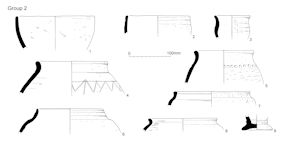 |
| 2 | GROG | Bowl EF41 | |
| 3 | GROG | Jar EF79 | |
| 4 | GROGC | Jar EF107 | |
| 5 | MICW | Jar EF98 | |
| 6 | GROG | Jar EF106 | |
| 7 | GROG | Jar EF104 | |
| 8 | GROG | Jar EF94 | |
| 9 | GROG | Pedestal base Cam 203 |
| Number | Fabric Code | Form | Figure 231: Key Pottery Group 3 |
|---|---|---|---|
| 1 | MICW | Pedestal-foot jar, MIA type | 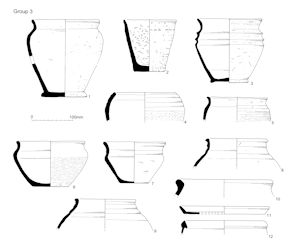 |
| 2 | MICW | Conical jar, MIA type | |
| 3 | GROG | Jar EF89 | |
| 4 | GROG | Jar EF86 | |
| 5 | GROG | Jar EF110 | |
| 6 | GROG | Jar EF81 | |
| 7 | GROG | Jar EF82 | |
| 8 | GROG | Jar EF138 | |
| 9 | GROG | Jar EF139 | |
| 10 | GROGC | Storage jar | |
| 11 | TNM | Platter Cam 1 | |
| 12 | NGWF | Butt beaker Cam 113 |
| Number | Fabric Code | Form | Figure 232: Key Pottery Group 4 |
|---|---|---|---|
| 1 | GROG | Bowl Cam 212 | 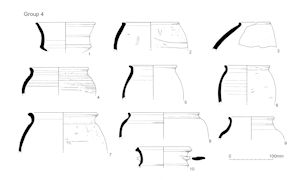 |
| 2 | GROGC | Jar Cam 255 | |
| 3 | GROG | Jar Cam 249 | |
| 4 | GROGC | Jar EF119 | |
| 5 | GROGRS | Jar Cam 256 | |
| 6 | GROGRS | Jar Cam 256 | |
| 7 | GROGC | Jar Cam 266 | |
| 8 | GROG | Jar EF104 | |
| 9 | GROG | Jar EF155 | |
| 10 | CGFCS | Flagon Cam 165 |
| Number | Fabric Code | Form | Figures 233/234/235: Key Pottery Group 5 |
|---|---|---|---|
| 1 | TNM | Platter Cam 1 |  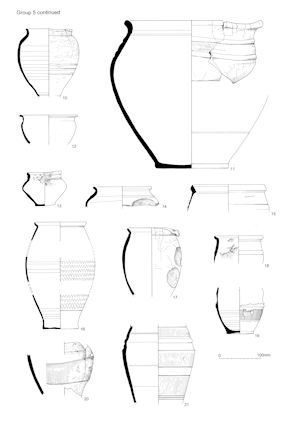 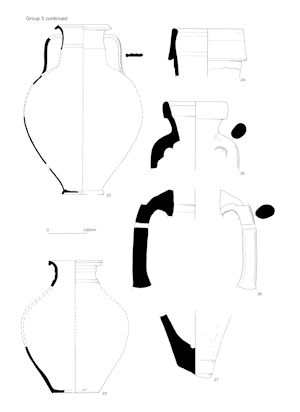 |
| 2 | TR | Platter Cam 2 | |
| 3 | TR | Platter Cam 5A | |
| 4 | TR | Platter Cam 5B | |
| 5 | PR | Platter EF23 | |
| 6 | GROG | Bowl Cam 253 | |
| 7 | IBUFM | Mortarium EF74 | |
| 8 | ESH | Jar Cam 255 | |
| 9 | GROG | Jar Cam 259 | |
| 10 | GROG | Jar Cam 204 | |
| 11 | GROG | Jar Cam 218 | |
| 12 | GROG | Jar Cam 221 | |
| 13 | GROG | Jar Cam 221B | |
| 14 | GROG | Jar Cam 220 | |
| 15 | NGWF | Butt beaker Cam 113 | |
| 16 | TR | Butt beaker Cam 112 | |
| 17 | GROG | Butt beaker Cam 118 | |
| 18 | GROG | ?Butt beaker Cam 115 | |
| 19 | GROG | Butt beaker Cam 115 base | |
| 20 | GROG | Butt beaker Cam 115 | |
| 21 | GROG | Butt beaker Cam 115 | |
| 22 | CGFCS | Flagon Cam 165 | |
| 23 | GROG | Flagon EF196 | |
| 24 | AITAD | Dressel 1 amphora | |
| 25 | AITAC | Dressel 1 amphora | |
| 26 | AITAB | Dressel 1 amphora | |
| 27 | AITAB | Dressel 1 amphora spike |
| Number | Fabric Code | Form | Figure 236: Key Pottery Group 6 |
|---|---|---|---|
| 1 | TR | Platter Cam 5 | 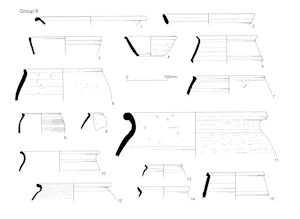
|
| 2 | GROG | Platter Cam 21 | |
| 3 | TNM | Bowl Cam 51 | |
| 4 | GROG | Dish EF26 | |
| 5 | GROG | Jar Cam 219 | |
| 6 | GROGC | Jar Cam 249 | |
| 7 | GROGC | Jar Cam 255 | |
| 8 | GROGC | Jar EF116 | |
| 9 | GROG | Jar Cam 249 | |
| 10 | GROG | Jar Cam 218 | |
| 11 | GROGC | Storage jar Cam 271 | |
| 12 | CGMIC | Beaker Cam 102 | |
| 13 | CGMIC | Beaker Cam 102 | |
| 14 | TR | Butt beaker Cam 112 | |
| 15 | GROG | Butt beaker Cam 115 |
| Number | Fabric Code | Form | Figure 237: Key Pottery Group 7 |
|---|---|---|---|
| 1 | TNM | Platter Cam 1 | 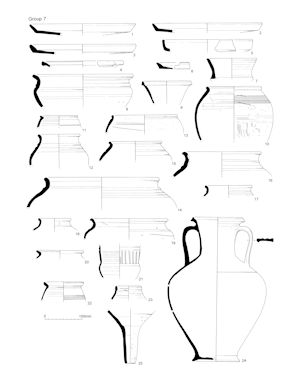
|
| 2 | TNM | Platter Cam 1 | |
| 3 | TNM | Platter Cam 1 | |
| 4 | TR | Platter Cam 4 | |
| 5 | GROG | Platter Cam 21 | |
| 6 | GROG | Platter Cam 22 | |
| 7 | GROG | Bowl Cam 214 | |
| 8 | GROG | Bowl Cam 230 | |
| 9 | TR | Cup Cam 56 | |
| 10 | GROGC | Jar Cam 249 | |
| 11 | GROGC | Jar G4 | |
| 12 | GROG | Jar Cam 229A | |
| 13 | GROG | Jar EF153 | |
| 14 | GROG | Jar EF154 | |
| 15 | GROGC | Jar Cam 219 | |
| 16 | GROGC | Jar Cam 218 | |
| 17 | GROGRS | Jar G19.1 | |
| 18 | GROG | Jar G19.1 | |
| 19 | GROG | Jar G20 | |
| 20 | CGMIC | Beaker Cam 102 | |
| 21 | TR | Girth beaker Cam 82 | |
| 22 | TR | Butt beaker Cam 112 | |
| 23 | GROG | Jar EF103 | |
| 24 | CGFCS | Flagon Cam 165 | |
| 25 | GROGC | Funnel N2.1 |
| Number | Fabric Code | Form | Figure 238: Key Pottery Group 8 |
|---|---|---|---|
| 1 | TNM | Platter Cam 1 with graffito | 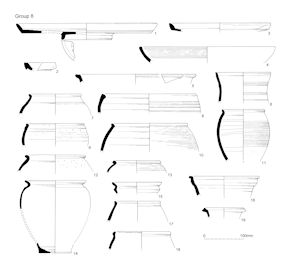 |
| 2 | TNM | Platter Cam 4 | |
| 3 | TN | Platter Cam 2 | |
| 4 | PR | Platter Cam 17 | |
| 5 | GROGRS | Bowl Cam 43 | |
| 6 | GROG | Bowl Cam 210 | |
| 7 | GROG | Jar Cam 204 | |
| 8 | GROGC | Jar Cam 254 | |
| 9 | GROGC | Jar Cam 255 | |
| 10 | GROGC | Jar Cam 257 | |
| 11 | GROG | Jar EF117 | |
| 12 | GROGC | Jar Cam 256 | |
| 13 | GROGC | Jar Cam 259 | |
| 14 | CGMIC | Beaker Cam 102 | |
| 15 | TR | Girth beaker Cam 82 | |
| 16 | GROG | Girth beaker Cam 85 | |
| 17 | GROG | Butt beaker Cam 115 | |
| 18 | GROG | Butt beaker EF189 | |
| 19 | CGFCS | Flagon Cam 165 |
| Number | Fabric Code | Form | Figure 239: Key Pottery Group 9 |
|---|---|---|---|
| 1 | GROG | Platter Cam 21 |  |
| 2 | GROG | Platter EF6 | |
| 3 | GROG | Platter Cam 21 | |
| 4 | GROGC | Bowl EF28 | |
| 5 | GROGC | Jar Cam 255 | |
| 6 | GROGC | Jar EF133 | |
| 7 | GROG | Jar Cam 229 | |
| 8 | GROG | Jar Cam 218/220 | |
| 9 | GROG | Jar Cam 221 |
| Number | Fabric Code | Form | Figure 240: Key Pottery Group 10 |
|---|---|---|---|
| 1 | GROG | Bowl Cam 211 | 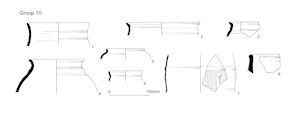
|
| 2 | GROG | Bowl EF46 | |
| 3 | GROG | Jar EF135 | |
| 4 | GROG | Jar Cam 218 | |
| 5 | GROG | Jar EF94 | |
| 6 | TR | Butt beaker Cam 112 | |
| 7 | NGWFS | Bossed butt beaker EF195 | |
| 8 | MICW | Jar EF78 (residual) |
| Number | Fabric Code | Form | Figure 241: Key Pottery Group 11 |
|---|---|---|---|
| 1 | GROG | Platter EF16 | 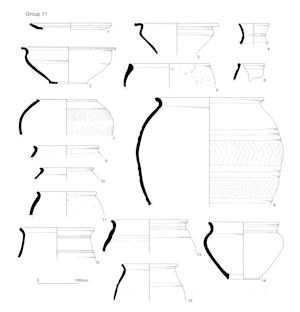 |
| 2 | GROGRF | Bowl EF72 | |
| 3 | GROG | Bowl Cam 241/246 | |
| 4 | GROG | Cup Cam 212 | |
| 5 | ESH | Jar Cam 254 | |
| 6 | GROG | Jar EF134 | |
| 7 | GROG | Jar EF146 | |
| 8 | GROG | Jar EF179 | |
| 9 | GROG | Jar Cam 259 | |
| 10 | GROGC | Jar Cam 256 | |
| 11 | GROGC | Jar Cam 259 | |
| 12 | GROG | Jar Cam 219 | |
| 13 | GROG | Jar Cam 218 | |
| 14 | GROG | Jar Cam 220 | |
| 15 | GROG | Butt beaker Cam 115 |
| Number | Fabric Code | Form | Figure 242: Key Pottery Group 12 |
|---|---|---|---|
| 1 | GROG | Bowl Cam 212 | 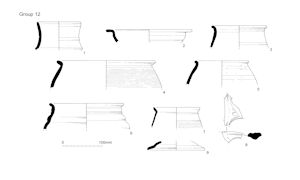 |
| 2 | GROGRS | Bowl EF73 | |
| 3 | GROG | Jar Cam 225 | |
| 4 | GROG | Jar Cam 256 | |
| 5 | GROG | Jar Cam 249 | |
| 6 | GROG | Jar Cam 229A | |
| 7 | TR | Butt beaker Cam 112 | |
| 8 | GROGRS | Flagon handle | |
| 9 | GROG | Lid K6 |
| Number | Fabric Code | Form | Figure 243: Key Pottery Group 13 |
|---|---|---|---|
| 1 | TNM | Platter EF20 | 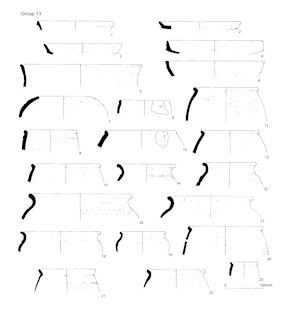 |
| 2 | GROG | Platter Cam 21 | |
| 3 | GROG | Platter Cam 21 | |
| 4 | GROG | Platter Cam 33 | |
| 5 | GROG | Bowl Cam 210 | |
| 6 | GROG | Bowl EF38 | |
| 7 | GROG | Bowl Cam 252 | |
| 8 | GROG | Bowl EF42 | |
| 9 | GROG | Jar EF129 | |
| 10 | GROG | Jar Cam 254 | |
| 11 | GROG | Jar Cam 259 | |
| 12 | GROG | Jar Cam 259 | |
| 13 | GROG | Jar Cam 259 | |
| 14 | GROG | Jar Cam 229 | |
| 15 | GROG | Jar G17 | |
| 16 | GROG | Jar Cam 218 | |
| 17 | GROG | Jar Cam 204 | |
| 18 | GROG | Jar G19 | |
| 19 | GROG | Jar G19 | |
| 20 | TNM | Butt beaker EF192 | |
| 21 | TR | Butt beaker Cam 112 | |
| 22 | GROG | Butt beaker H7 | |
| 23 | GROG | Beaker EF188 |
| Number | Fabric Code | Form | Figure 244: Key Pottery Group 14 |
|---|---|---|---|
| 1 | GROG | Platter Cam 21 | 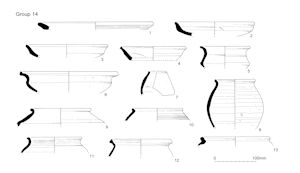 |
| 2 | GROG | Platter Cam 21 | |
| 3 | GROG | Platter Cam 21 | |
| 4 | GROG | Platter A2.4 | |
| 5 | GROG | Bowl Cam 212 | |
| 6 | GROGRS | Bowl EF71 | |
| 7 | GROG | Jar Cam 249 | |
| 8 | GROG | Jar Cam 256 | |
| 9 | GROG | Jar Cam 258 | |
| 10 | GROGC | Jar Cam 260 | |
| 11 | GROG | Jar G19 | |
| 12 | GROGRF | Butt beaker Cam 116 | |
| 13 | CGMIC | Jar Cam 262 (residual) |
| Number | Fabric Code | Form | Figure 245: Key Pottery Group 15 |
|---|---|---|---|
| 1 | GROG | Platter A2 | 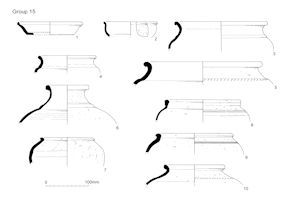 |
| 2 | GRF | Bowl EF57 | |
| 3 | BSW | Jar G19 | |
| 4 | BSW | Jar G20.1 | |
| 5 | GROGC | Storage jar G45 | |
| 6 | GROG | Jar Cam 232 | |
| 7 | GROGC | Jar Cam 259 | |
| 8 | STOR | Jar EF178 | |
| 9 | STOR | Jar EF126 | |
| 10 | STOR | Storage jar |
| Number | Fabric Code | Form | Figure 246: Key Pottery Group 16 |
|---|---|---|---|
| 1 | SGSW | Platter f15/17 | 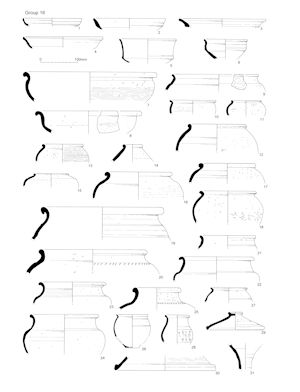 |
| 2 | GROG | Platter Cam 21 | |
| 3 | GROG | Platter Cam 21 | |
| 4 | GROG | Platter A2 | |
| 5 | COLB | Bowl (Bidwell and Croom 1999, Cam 327) | |
| 6 | GRF | Bowl EF64 | |
| 7 | STOR | Bowl C33 | |
| 8 | STOR | Bowl C33 | |
| 9 | GROGC | Jar EF135 | |
| 10 | BSW | Bowl EF57 | |
| 11 | GROG | Jar EF131 | |
| 12 | GROGC | Jar Cam 259 | |
| 13 | GROGC | Jar Cam 259 | |
| 14 | GROG | Jar Cam 249 | |
| 15 | GROG | Jar Cam 258 | |
| 16 | GROGC | Jar Cam 259 | |
| 17 | GROGC | Jar Cam 259 | |
| 18 | BSW | Jar G3 | |
| 19 | STOR | Storage jar Cam 270B | |
| 20 | STOR | Storage jar Cam 271 | |
| 21 | GROG | Jar G19.1 | |
| 22 | GROG | Jar G20 | |
| 23 | GROG | Jar G20 | |
| 24 | GRS | Jar G20 | |
| 25 | STOR | Storage jar | |
| 26 | GRF | Beaker H1 | |
| 27 | GROG | Beaker H1 | |
| 28 | TR | Butt beaker Cam 112 | |
| 29 | GROGC | Lid | |
| 30 | GROGC | Lid K3 | |
| 31 | GROG | Funnel N2 |
| Number | Fabric Code | Form | Figure 247: Key Pottery Group 17 |
|---|---|---|---|
| 1 | BSW | Platter A2 with piece removed from rim | 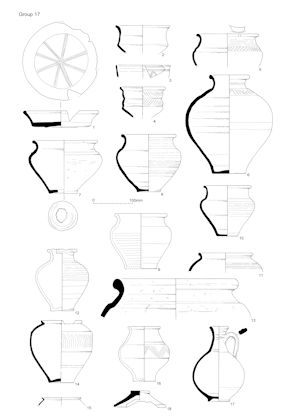 |
| 2 | BSW | Bowl Cam 214 | |
| 3 | GRF | Bowl C12 | |
| 4 | BSW | Bowl C27 | |
| 5 | BSW | Jar G17 with two notches on the rim | |
| 6 | GRS | Jar G17/Cam 232 | |
| 7 | BSW | Jar G19.4 with holes in base and walls | |
| 8 | BSW | Jar G20 | |
| 9 | GRF | Jar G20 | |
| 10 | BSW | Jar G20.1 | |
| 11 | GRS | Jar G23 | |
| 12 | GRF | Jar G40 with piece removed from rim | |
| 13 | STOR | Storage jar G44 | |
| 14 | BSW | Beaker Cam 108 with piece removed from rim | |
| 15 | IMIC | Beaker H1 | |
| 16 | GRF | Butt beaker H7.1 | |
| 17 | COLB | Flagon J | |
| 18 | BSW | Lid K6 with piece removed from rim |
| Number | Fabric Code | Form | Figure 248: Key Pottery Group 18 |
|---|---|---|---|
| 1 | GRS | Platter A2.2 | 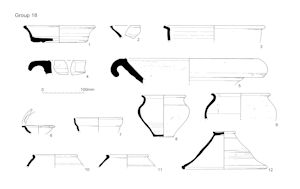 |
| 2 | BSW | Platter A4 | |
| 3 | BSW | Dish B8 | |
| 4 | BUFM | Mortarium D1 | |
| 5 | VRWM | Mortarium D1 | |
| 6 | SGSW | Cup f35 | |
| 7 | GRF | Cup samian f27 copy | |
| 8 | GRF | Jar G20 | |
| 9 | GRS | Jar G3 | |
| 10 | GRS | Jar G3 | |
| 11 | GRS | Beaker H1 | |
| 12 | GRS | Lid K6 |
| Number | Fabric Code | Form | Figure 249: Key Pottery Group 19 |
|---|---|---|---|
| 1 | GRS | Platter A2.3 |  |
| 2 | GRS | Jar G17 | |
| 3 | BSW | Jar G17 | |
| 4 | BSW | Jar G19 | |
| 5 | BSW | Jar G20.1 | |
| 6 | BSW | Jar G23 | |
| 7 | RED | Flagon J3.1 |
| Number | Fabric Code | Form | Figure 250: Key Pottery Group 20 |
|---|---|---|---|
| 1 | BSW | Platter A2 | 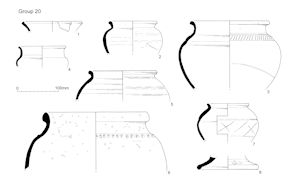 |
| 2 | GRS | Jar G8 | |
| 3 | GRS | Jar G17 | |
| 4 | BSW | Jar G20 | |
| 5 | GRS | Jar G23 | |
| 6 | STOR | Storage jar G44 | |
| 7 | BSW | Beaker H1 | |
| 8 | GRS | Lid |
| Number | Fabric Code | Form | Figures 251/252: Key Pottery Group 21 |
|---|---|---|---|
| 1 | SGSW | Platter f15/17 | 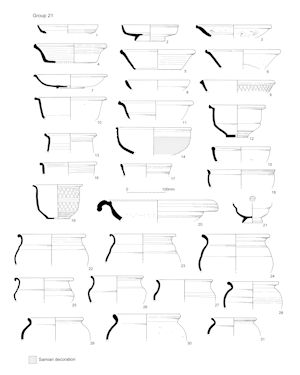 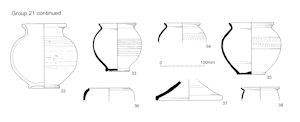 |
| 2 | SGSW | Platter f18 | |
| 3 | GRF | Platter A2 | |
| 4 | BSW | Platter A2 | |
| 5 | BSW | Platter A2 | |
| 6 | BSW | Platter A2 | |
| 7 | NKG | Platter A4 | |
| 8 | BSW | Dish B1 | |
| 9 | BB2 | Dish B2 | |
| 10 | GRS | Dish B7 | |
| 11 | GRS | Dish B7 | |
| 12 | BSW | Dish B7 | |
| 13 | BSW | Dish B7 | |
| 14 | CGSW | Bowl f37 | |
| 15 | BSW | Bowl with thickened bead rim | |
| 16 | BSW | Bowl C1 | |
| 17 | BSW | Bowl C12 | |
| 18 | NKO | Bowl (Monaghan 1987, type 4I) | |
| 19 | BSW | Bowl with everted rim and lattice decoration | |
| 20 | BUFM | Mortarium D1 | |
| 21 | SGSW | Cup f27 | |
| 22 | BSW | Jar G16 | |
| 23 | BSW | Jar G16 | |
| 24 | BSW | Jar G16 | |
| 25 | BSW | Jar G19 | |
| 26 | GRS | Jar G20 | |
| 27 | BSW | Jar G20 | |
| 28 | GRS | Jar G23 | |
| 29 | GRS | Jar G23 | |
| 30 | GRS | Jar G23 | |
| 31 | BSW | Jar G23 | |
| 32 | GRS | Necked jar with globular body | |
| 33 | GRF | Beaker H1 | |
| 34 | BSW | Beaker H1 | |
| 35 | BSW | Beaker H1 | |
| 36 | BSW | Beaker H4 | |
| 37 | BSW | Lid K3 | |
| 38 | BSW | Miniature |
| Number | Fabric Code | Form | Figures 253/254: Key Pottery Group 22 |
|---|---|---|---|
| 1 | NKG | Platter A4 | 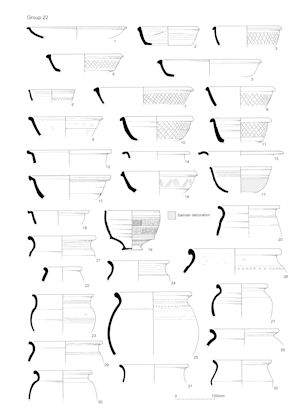 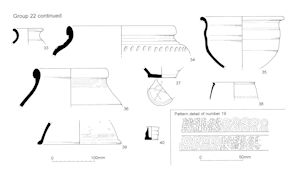 |
| 2 | BSW | Platter A4.5 | |
| 3 | BB2 | Dish B2.3 | |
| 4 | BB2 | Dish B2.3 | |
| 5 | BB2 | Dish B2 | |
| 6 | BB2 | Dish B | |
| 7 | BB2 | Dish B4 | |
| 8 | BB2 | Dish B4 | |
| 9 | BSW | Dish B4 | |
| 10 | GRS | Dish B4 | |
| 11 | GRS | Dish B4 | |
| 12 | BSW | Dish B7 | |
| 13 | BSW | Dish B7 | |
| 14 | BSW | Dish B9 | |
| 15 | GRF | Dish B10 | |
| 16 | BSW | Dish B2-type, decorated | |
| 17 | SGSW | Bowl f37 | |
| 18 | GRS | Bowl C16 | |
| 19 | LESTA | Bowl C2 | |
| 20 | GRS | Jar G16 | |
| 21 | BSW | Jar G17 | |
| 22 | BSW | Jar G3 | |
| 23 | GRS | Jar G20 | |
| 24 | GRS | Jar G20 | |
| 25 | GRS | Jar G22 | |
| 26 | GRS | Jar G22 | |
| 27 | BSW | Jar G23 | |
| 28 | BSW | Jar G23 | |
| 29 | GRS | Jar G23 | |
| 30 | GRS | Jar G23 | |
| 31 | GRF | Jar G29 | |
| 32 | GRS | Jar G29 | |
| 33 | BSW | Jar G40 | |
| 34 | STOR | Storage jar G45 | |
| 35 | GRS | Bowl-jar E6 variant | |
| 36 | GRS | Jar G42 | |
| 37 | BSW | Jar base with graffito | |
| 38 | COLC | Beaker H20 | |
| 39 | BSW | Lid K3 | |
| 40 | BSW | Miniature |
| Number | Fabric Code | Form | Figure 255: Key Pottery Group 23 |
|---|---|---|---|
| 1 | CGSW | Dish base with X graffito | 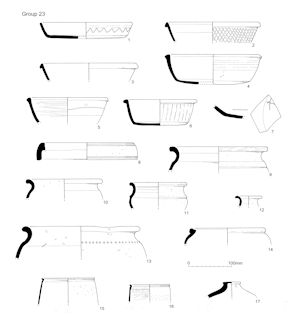 |
| 2 | BB2 | Dish B1 | |
| 3 | BB2 | Dish B2.4 | |
| 4 | GRS | Dish B2/B4 | |
| 5 | BSW | Dish B4.1 | |
| 6 | BSW | Dish B4.1 | |
| 7 | BB2 | Dish B4.2 | |
| 8 | COLBM | Mortarium D13.1 | |
| 9 | BSW | Jar G20 | |
| 10 | GRS | Jar G23 | |
| 11 | BSW | Jar G29.2 | |
| 12 | BSW | Jar G40 | |
| 13 | STOR | Storage jar G45 | |
| 14 | BSW | Jar G5.2 | |
| 15 | RED | Beaker H20 | |
| 16 | COLC | Beaker H20.2 | |
| 17 | GRS | Lid |
| Number | Fabric Code | Form | Figure 256: Key Pottery Group 24 |
|---|---|---|---|
| 1 | BSW | Dish B4 | 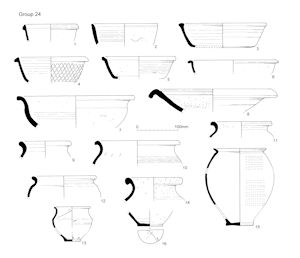 |
| 2 | GRS | Dish B3 | |
| 3 | BSW | Dish B4 | |
| 4 | BB2 | Dish B4.2 | |
| 5 | GRS | Dish B7 | |
| 6 | GRS | Bowl C1.1 | |
| 7 | GROG | Bowl C33 | |
| 8 | GRSWSM | Mortarium D1 | |
| 9 | GRS | Jar G19 | |
| 10 | GRS | Jar G20 | |
| 11 | GRS | Jar G23 | |
| 12 | BSW | Jar G23 | |
| 13 | BSW | Jar G29.1 | |
| 14 | STOR | Jar G36 | |
| 15 | NKG | Beaker (Monaghan 1987, type 2H1) | |
| 16 | BSW | Base with X graffito |
| Number | Fabric Code | Form | Figure 257: Key Pottery Group 25 |
|---|---|---|---|
| 1 | BSW | Dish B1 | 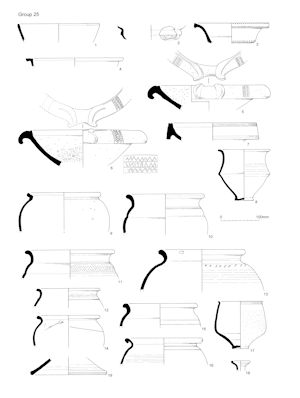 |
| 2 | LOND | Bowl C22 (Monaghan 1987, type 4H1) | |
| 3 | BUF | Tazza-bowl Cam 198 | |
| 4 | MIC | Bowl C16 | |
| 5 | COLBM | Mortarium D1.3 with herringbone stamp | |
| 6 | COLBM | Mortarium D1.3 with stamp of Martinus | |
| 7 | COLBM | Mortarium D13 | |
| 8 | BSW | Jar G29 (Monaghan 1987, type 2G2) | |
| 9 | GRS | Jar G5.5 | |
| 10 | GRS | Jar G17 | |
| 11 | GRS | Jar G17 | |
| 12 | BSW | Jar G19.5 | |
| 13 | GRS | Jar G22 | |
| 14 | BSW | Jar G23 | |
| 15 | GRS | Jar G24 | |
| 16 | GRS | Jar G25 | |
| 17 | COLC | Beaker H20.2 | |
| 18 | MWSRS | Flagon J4 | |
| 19 | GRS | Lid K6 |
| Number | Fabric Code | Form | Figure 258: Key Pottery Group 26 |
|---|---|---|---|
| 1 | CGSW | Dish f31R, riveted | 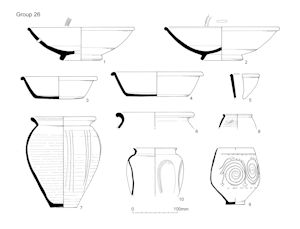 |
| 2 | CGSW | Dish f31R | |
| 3 | BSW | Dish B2 | |
| 4 | BB2 | Dish B2 | |
| 5 | BSW | Dish B3 | |
| 6 | BSW | Jar G23 | |
| 7 | BSW | Jar G9.3 | |
| 8 | MIC | Beaker H20 | |
| 9 | COLC | Beaker H24.1 | |
| 10 | COLC | Beaker H35 |
| Number | Fabric Code | Form | Figure 259: Key Pottery Group 27 |
|---|---|---|---|
| 1 | UPOT | Dish B2/B4 | 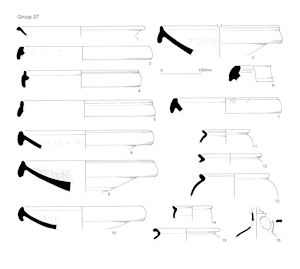 |
| 2 | BUFM | Mortarium D3 | |
| 3 | BUFM | Mortarium D3 | |
| 4 | BUFM | Mortarium D3 | |
| 5 | BUFM | Mortarium D3 | |
| 6 | BUFM | Mortarium D11 | |
| 7 | BUFM | Mortarium D11.1 | |
| 8 | BUFM | Mortarium D11.1 | |
| 9 | BUFM | Mortarium D11.1 | |
| 10 | BUFM | Mortarium D11.1 | |
| 11 | GRS | Jar G5.5 | |
| 12 | GRS | Jar G5.5 | |
| 13 | GRS | Jar G5.5 | |
| 14 | GRS | Jar G5 | |
| 15 | GRS | Jar G10.1 | |
| 16 | UPOT | Flagon J9 |
| Number | Fabric Code | Form | Figure 260: Key Pottery Group 28 |
|---|---|---|---|
| 1 | GRS | Dish B | 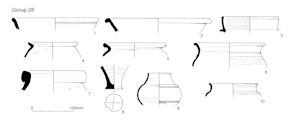 |
| 2 | BSW | Dish B4 | |
| 3 | EGSW | Bowl f38 | |
| 4 | BSW | Jar G5.5 | |
| 5 | GRS | Jar G5.5 | |
| 6 | GRS | Jar Cam 218 | |
| 7 | STOR | Storage jar G44.2 | |
| 8 | GRF | Beaker base with graffito | |
| 9 | CGRHN | Beaker (Symonds 1992, fig. 9, Gp 9) | |
| 10 | BSW | Beaker H34 |
| Number | Fabric Code | Form | Figure 261: Key Pottery Group 30 |
|---|---|---|---|
| 1 | BSW | Dish B1.3 |  |
| 2 | BSW | Dish B4.2 | |
| 3 | BSW | Dish B | |
| 4 | BSW | Dish B5.1 | |
| 5 | NVM | Mortarium (Perrin and Hartley 1996, fig. 116, M128) | |
| 6 | GRS | Jar G22 | |
| 7 | BSW | Lid K2 |
| Number | Fabric Code | Form | Figure 262: Key Pottery Group 31 |
|---|---|---|---|
| 1 | GRF | Dish B2 | 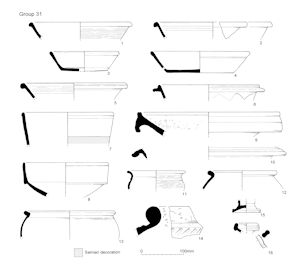 |
| 2 | BSW | Dish B2/B4 | |
| 3 | BB2 | Dish B3 | |
| 4 | HAR | Dish B | |
| 5 | BSW | Dish B4 | |
| 6 | BB1 | Dish B6.3 | |
| 7 | EGSW | Bowl f37 | |
| 8 | CGSW | Mortarium f45 | |
| 9 | BUFM | Mortarium D3.3 | |
| 10 | NVM | Mortarium D14 | |
| 11 | BSW | Bowl-jar E5 | |
| 12 | GRS | Jar G5 | |
| 13 | BSW | Jar G5.5 | |
| 14 | STOR | Storage jar G44 | |
| 15 | HAWO | Pedestal base Cam 296 | |
| 16 | MWSRS | Flagon Cam 365 |
| Number | Fabric Code | Form | Figure 263: Key Pottery Group 32 |
|---|---|---|---|
| 1 | BSW | Dish B1 | 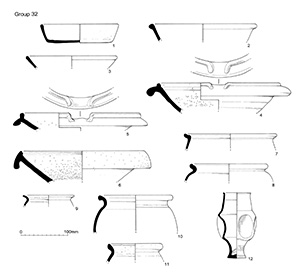 |
| 2 | BSW | Dish B2/B4 | |
| 3 | GRS | Dish B | |
| 4 | BUFM | Mortarium D3 | |
| 5 | OXWM | Mortarium D5 | |
| 6 | BUFM | Mortarium D11 | |
| 7 | GRS | Bowl-jar E2 | |
| 8 | BSW | Jar G5.5 | |
| 9 | GRS | Jar G9 | |
| 10 | GRS | Jar G24 | |
| 11 | RET | Jar G24.1 | |
| 12 | GRF | Beaker H33 |
| Number | Fabric Code | Form | Figure 264: Key Pottery Group 33 |
|---|---|---|---|
| 1 | BB1 | Dish B1.4 | 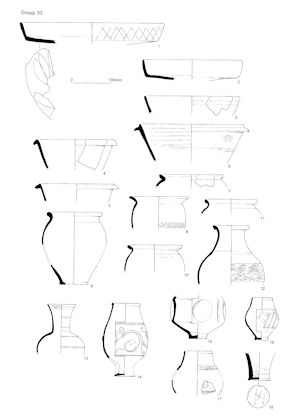 |
| 2 | BSW | Dish B1 | |
| 3 | GRS | Dish B1 | |
| 4 | BB2 | Dish B4 | |
| 5 | GRS | Dish B5.1 | |
| 6 | BB1 | Dish B6.3 | |
| 7 | GRS | Jar G5.5 | |
| 8 | GRS | Jar G9.3 | |
| 9 | RET | Jar G23 | |
| 10 | GRS | Jar G23 | |
| 11 | GRS | Jar G23 | |
| 12 | BSW | Jar G38 | |
| 13 | HAB | Beaker copying Symonds (1992) Gp 67 | |
| 14 | NVC | Beaker H28 | |
| 15 | GRS | Beaker H39 | |
| 16 | NVC | Beaker H41 | |
| 17 | NVC | Beaker H41 | |
| 18 | GRF | Beaker base with X graffito |
| Number | Fabric Code | Form | Figure 265: Key Pottery Group 34 |
|---|---|---|---|
| 1 | BSW | Dish B6.2 | 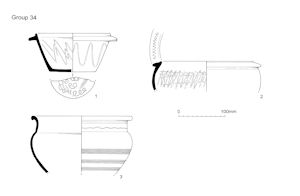 |
| 2 | HAB | Bowl-jar E1.1 | |
| 3 | GRF | Bowl-jar E5.4 |
| Number | Fabric Code | Form | Figure 266: Key Pottery Group 35 |
|---|---|---|---|
| 1 | BSW | Dish B1 | 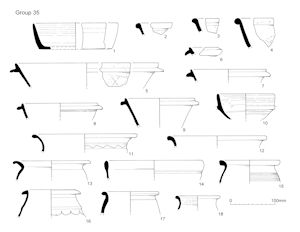 |
| 2 | BSW | Dish B2/B4 | |
| 3 | BSW | Dish B2/B4 | |
| 4 | GRS | Dish B4 | |
| 5 | BB1 | Dish B6.3 | |
| 6 | BB1 | Dish B6 | |
| 7 | GRF | Dish B6 | |
| 8 | BSW | Dish B6.2 | |
| 9 | BSW | Dish B6.2 | |
| 10 | HAR | Bowl C8 | |
| 11 | GRF | Bowl-jar E5.4 | |
| 12 | BSW | Bowl-jar E6 | |
| 13 | BB1 | Jar G9 | |
| 14 | BSW | Jar G12 | |
| 15 | GRS | Jar G21 | |
| 16 | GRF | Jar with flange-like rim and looped decoration | |
| 17 | GRS | Jar with rolled-over rim | |
| 18 | GRF | Beaker |
| Number | Fabric Code | Form | Figure 267: Key Pottery Group 36 |
|---|---|---|---|
| 1 | BB1 | Dish B6.3 | 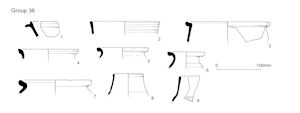 |
| 2 | HAX | Bowl C8 | |
| 3 | BSW | Bowl-jar E2.3 | |
| 4 | LSH | Jar G27 | |
| 5 | GRS | Jar G37 | |
| 6 | GRS | Jar G40 | |
| 7 | GRS | Jar G5.4 | |
| 8 | NVC | Beaker H32 | |
| 9 | NVC | Beaker H32 |
| Number | Fabric Code | Form | Figure 268: Key Pottery Group 37 |
|---|---|---|---|
| 1 | BSW | Dish B1 | 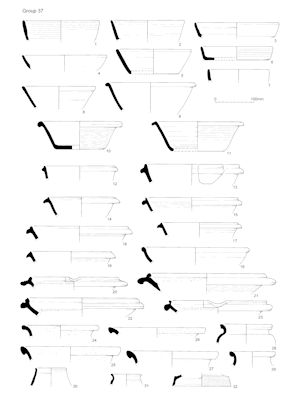 |
| 2 | BSW | Dish B1 | |
| 3 | BSW | Dish B1 | |
| 4 | BSW | Dish B1 | |
| 5 | GRF | Dish B1 | |
| 6 | GRF | Dish B1 | |
| 7 | NVC | Dish B1.2 | |
| 8 | BSW | Dish B | |
| 9 | BSW | Dish B4 | |
| 10 | GRF | Dish B4 | |
| 11 | BSW | Dish B5.1 | |
| 12 | BSW | Dish B6.1 | |
| 13 | BUF | Dish B6.1 | |
| 14 | BSW | Dish B6.2 | |
| 15 | GRS | Dish B6.2 | |
| 16 | GRS | Dish B6.2 | |
| 17 | GRF | Dish B6.2 | |
| 18 | GRF | Dish B6.2 | |
| 19 | OXRC | Bowl (1977, type C55) | |
| 20 | NVM | Mortarium D14 | |
| 21 | NVM | Mortarium (Hartley and Perrin 1999, fig. 77, M9) | |
| 22 | OXWM | Mortarium (Young 1977, type M22) with reeded flange | |
| 23 | OXWM | Mortarium (Young 1977, type M22) | |
| 24 | LSH | Jar G27.1 | |
| 25 | LSH | Jar G27.2 | |
| 26 | LSH | JarG27.2 | |
| 27 | LSH | Jar G27.2 | |
| 28 | NVC | Jar G28 (Howe et al. 1980, no. 70) | |
| 29 | NVC | Narrow-necked jar | |
| 30 | GRF | Funnel-necked beaker | |
| 31 | GRF | Everted-rimmed beaker | |
| 32 | NVC | Lid K7 |
| Number | Fabric Code | Form | Figure 269: Key Pottery Group 38 |
|---|---|---|---|
| 1 | BSW | Dish B1 | 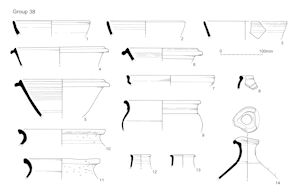 |
| 2 | BSW | Dish B1 | |
| 3 | GRF | Dish B1 | |
| 4 | BSW | Dish B6.2 | |
| 5 | GRF | Dish B6.2 | |
| 6 | GRS | Dish B6.2 | |
| 7 | OXRC | Bowl (1977, type C40) | |
| 8 | NVC | Bowl (Perrin 1999, fig. 64, nos 248-50) | |
| 9 | GRF | Bowl-jar E7 | |
| 10 | RET | Jar G24.2 | |
| 11 | LSH | Jar G27.2 | |
| 12 | NVC | Beaker H41 | |
| 13 | GRF | Beaker | |
| 14 | OXW | Flagon (1977, type W25) |
| Number | Fabric Code | Form | Figure 270: Key Pottery Group 39 |
|---|---|---|---|
| 1 | LSH | Dish B1 | 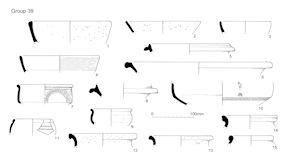 |
| 2 | LSH | Dish B1 | |
| 3 | NVC | Dish B1.2 | |
| 4 | HAB | Dish B1.3 | |
| 5 | GRF | Dish B6.2 | |
| 6 | OXP | Bowl (1977, type P17) | |
| 7 | OXRC | Bowl (1977, type C69) | |
| 8 | OXRC | Bowl C8 (1977, type C51) | |
| 9 | OXRC | Bowl-jar E4 (1977, type C75) | |
| 10 | OXRC | ?Bowl-jar (1977, ?type C73) | |
| 11 | NVC | Bowl, probably Howe et al. (1980), no. 82 | |
| 12 | LSH | Jar G27 | |
| 13 | LSH | Jar G27 | |
| 14 | GRS | Jar G28 | |
| 15 | GRF | Jar G42 |
| Number | Fabric Code | Form | Figure 271: Key Pottery Group 40 |
|---|---|---|---|
| 1 | NVC | Dish B1 | 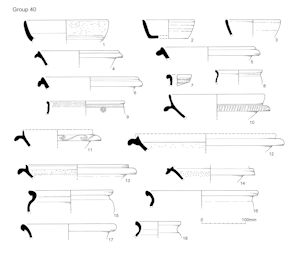 |
| 2 | GRF | Dish B1.3 | |
| 3 | BSW | Dish B1.2 | |
| 4 | HAR | Dish B6 | |
| 5 | ALH | Dish B6 | |
| 6 | GRF | Dish B6 | |
| 7 | OXRC | Bowl (Young 1977, type C77) | |
| 8 | OXRC | Bowl (Young 1977, type C74) | |
| 9 | OXRC | Bowl (Young 1977, type C70) | |
| 10 | OXRC | Bowl C8 (Young 1977, type C52) | |
| 11 | OXRC | Bowl C8 (Young 1977, type C52) | |
| 12 | OXRCM | Mortarium D6 (Young 1977, type C100) | |
| 13 | OXSWM | Mortarium D (Young 1977, type WC7) | |
| 14 | OXWM | Mortarium D (Young 1977, type M21) | |
| 15 | NVC | Bowl-jar E6.1 | |
| 16 | GRS | Jar G24.1 | |
| 17 | LSH | Jar G27.2 | |
| 18 | GRS | Jar G24 |
This section uses the data extracted from the Key Pottery Groups presented in the Pottery Sequence section, along with the expanded pool of securely dated groups listed in the archive. The trends in the pattern of pottery supply and assemblage composition are derived from the data and presented in Ceramic Phase order. Quantities depicted on the maps are based on the EVE total for each fabric present in a given ceramic phase, expressed as a percentage of the EVE total for all fabrics. Where fabrics are in amounts too small to be recorded by EVE, square symbols denote their presence. A discussion of supply patterns and changes through time follows the maps. Chelmsford and Colchester remain key points of reference, though other sites, mainly located within the region, are introduced for comparison. A discussion of assemblage composition for each ceramic phase follows. Again, changes through time are highlighted and comparisons are made between Heybridge and other sites. Quantified groups from any period in Essex are comparatively few and are mainly late Roman in date. The groups presented in this report add significantly to the overall number, together with those from the settlement at Great Holts Farm, Boreham (Martin 2003).
Context numbers given in the text usually refer to pottery groups from the expanded dataset; otherwise they can be found in the stratigraphic narrative (Section 2). It should be noted that assemblages comprising the expanded dataset were used up to and including Ceramic Phase 10. For CP11, and for the post-Roman phase, information has been extracted from the four relevant Key Pottery Groups only (KPGs 37-40). Versions of most form types mentioned are illustrated in the Pottery Sequence section. Otherwise, for the Roman period, forms can be found in the Chelmsford type series (Going 1987, 13-54), or the updated Camulodunum/Colchester series (Bidwell and Croom 1999, 468-87), which is also useful for the Late Iron Age. Occasional reference is made to regional typologies, such as Monaghan's Upchurch/Thameside (1987) and Young's Oxfordshire (1977) series. Attention is drawn to the typology of Late Iron Age forms, comprising types found at Heybridge but not attested at Camulodunum.
To avoid repetition, the word 'phase' is often used instead of 'ceramic phase'. These are one and the same. Naturally, the division of this section into ceramic phases results in a somewhat disjointed discussion. However, a more cohesive overview, drawing together the trends presented here and bringing in further interpretation, is taken up in the related synthetic monograph (Atkinson and Preston 2015).
Key for ceramic phase maps
Blocked-in sectors on the pie charts represent the %EVE for a given fabric
■ indicates fabric presence only, where EVE could not be measured
□ (open or white square) represents Heybridge
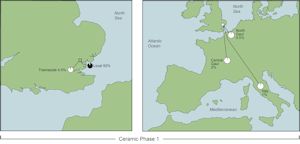
Assemblages assigned to the first part of Ceramic Phase 1 include a significant element of locally made, sand-tempered pottery, characteristic of the middle to Late Iron Age transition, although grog-tempered fabrics generally form the major component. Dressel 1 amphoras occur sporadically, their numbers increasing towards the end of the phase. Also late in the phase, other imports are apparent in the form of Central Gaulish micaceous flagons and platters. Ceramic Phase 1 heralds a change from local middle Iron Age traditions, marked by the introduction of grog-tempered pottery, closely followed by the establishment of wheel-throwing techniques and the increasing importation of amphoras. This pattern, which is in keeping with settlements elsewhere in south-eastern Britain, is amply demonstrated by Key Pottery Groups 1 to 4.
Drury's discussion of the early and middle Iron Age pottery from Little Waltham (1978, 51-63) forms the basis for the study of Iron Age pottery in central Essex. At Little Waltham, 14km to the west of Heybridge, assemblages are dominated throughout by early/middle Iron Age, coarse sand-tempered pottery (Drury's Fabric H). Grog-tempered pottery (Fabric E) did not appear until c. 50-25 BC, forming just 9% of the total overall (Drury 1978, table 10), whereas at Elms Farm this fabric comprises an average of 80% by weight in Ceramic Phase 1 assemblages. The reason for this may be largely one of chronology, as the settlement at Little Waltham was in decline in the later 1st century BC, in contrast to Heybridge. It is unlikely that new material was thus being introduced at Little Waltham at this time.
The pottery from Heybridge is more comparable with pottery found at Kelvedon (Rodwell 1988), 11km distant. There, three main fabrics were identified, a coarse sand-tempered fabric, equivalent to Drury's Fabric H, a second tempered with grog, and another intermediate between the two, but with the addition of occasional flint grits. The forms present in these fabrics ranged from handmade vessels in sand-tempered fabrics, through to grog-tempered, cordoned, wheel-thrown bowls and jars (Rodwell 1988, 102). A large group (22.7kg) from Ditch 350, representative of all of these forms and fabrics, was assigned a mid- to late 1st century BC date (c. 50-20 BC). Grog-tempered pottery forms 77% of this ditch assemblage. At Heybridge, the proportions of forms and fabrics are entirely consonant with those at Kelvedon.
A similar assemblage was excavated from Ditch AF1 at nearby Woodham Walter (Buckley et al. 1987), where the proportion of wheel-thrown grog-tempered and handmade sand-tempered wares appears to be roughly equal. Unfortunately, the pottery was not fully quantified. Rodwell proposed a date towards the middle of the 1st century BC for its deposition (1987a, 38).
The middle Iron Age pottery from Elms Farm has been discussed by Brown (2001, 64), but precise dating within the middle Iron Age is difficult in the absence of supporting scientific dating (e.g. dendrochronology). All pottery made in the middle Iron Age tradition found in Late Iron Age contexts was assigned a single fabric code, MICW, during recording. Most assemblages assigned to Ceramic Phase 1 contain this mainly sand-tempered fabric, in an amount averaging 11% of the total by weight. Only in one feature, ditch 25174, does sand-tempered coarse ware greatly exceed this figure, although the quantity of pottery recovered is small (1.19kg). The potentially early date for this group, perhaps c. 50 BC, is supported by the stratigraphy.
The similarity between the pottery assigned to the first part of Ceramic Phase 1 and that from Ditch 350 at Kelvedon indicates that a date of c. 50-20 BC can also be confidently assigned to these assemblages at Elms Farm. Independent dating evidence in the form of two coins lends weight to the assigned date. A Class I/II potin (SF5645) in the bottom fill of ditch segment 16018 (KPG2) supports a date in the 1st century BC, although most of the pottery present in this feature consists of handmade grog-tempered ware. The second coin, a Class II potin (SF6871), is associated with handmade grog-tempered pottery only and also supports a date of c. 50-20 BC.
Early shell-tempered ware appears in four Ceramic Phase 1 contexts, although the quantities are very low, amounting to an average of 3% by weight. This fabric is more common in the Thameside area of south Essex and north Kent, where it was probably produced, forming only a small component of central Essex assemblages. The pottery from Elms Farm conforms, with the fabric maintaining a low proportion in all ceramic phases.
The level of imports in Ceramic Phase 1 is low throughout, mostly appearing towards the end of the phase. Italian amphoras average 4% by weight. Imported fine wares, forming an average of 3% by weight, consist of Central Gaulish micaceous wares and North Gaulish white ware. Central Gaulish imports appeared in Britain slightly earlier than Gallo-Belgic, which were more common from c. 15 BC (Rigby 1989, 121). The evidence at Elms Farm confirms that importation of Central Gaulish micaceous wares occurred at least a decade before the more widespread Gallo-Belgic types. Central Gaulish ware forms a major component, compared with other imports, from the middle of this phase until the end of Ceramic Phase 2. North Gaulish white ware vessels were sporadic arrivals before the 1st century AD, but their presence in Ceramic Phase 1 groups confirms earlier importation at Heybridge.
Imported pottery on other sites in the vicinity is scarce, especially that dated early in the Late Iron Age. A possible Cam 165 flagon, probably from the New Cemetery, Heybridge, was donated to the Colchester and Essex museum in 1922 (Wickenden 1986, 55), but all other imports of this date found in the vicinity comprise amphoras (Wallace 1998, table 8). At Woodham Walter, a cream-slipped, two-handled flagon was found in Ditch CF101, dated mid-1st century AD, and described by Rodwell (1987a, 32; fig. 25.172) as a Gallo-Belgic copy. The vessel, pace Wallace (1998, 155), is probably not a Central Gaulish import; the form, as illustrated, and the fabric description indicate that the flagon is a later local copy of a Gallo-Belgic form.
The range of vessel forms in Ceramic Phase 1 is very restricted, mainly comprising jars and bowls in coarse fabrics. Vessels from both KPG1 and KPG2 are generally handmade with little difference in style between those in sand-tempered fabric and grog-tempered examples. Bowl types are largely indistinguishable from jars and together these predominate at 85% by vessel rim equivalence (EVE). Forms are simple with everted or bead rims and any decoration is confined to combing on the lower body or lines of stabbing along the shoulder. Wheel-thrown pottery seems to occur in slightly later groups, perhaps first appearing in the decade c. 40-30 BC, although this is difficult to date with precision. The range of forms is again restricted to jars and bowls, either plain or with rippled or cordoned shoulders. The few identifiable bowl types, at 6% by EVE, are mainly those with one or more cordons at the mid-body constriction (Cam 211), reminiscent of vessels made in wood or shale. The only identified vessel form in early shell-tempered ware is the club-rimmed jar Cam 254; all Ceramic Phase 1 vessels in this fabric are handmade.
Platters, cups, beakers and flagons appear towards the end of the ceramic phase, but are few in number and mostly imported. There are also two examples of the carinated and pedestalled tazza-bowl Cam 210. Platters form 2% of the assemblage by EVE and comprise the micaceous Cam 1, grog-tempered copies of these, Cam 21, and later in the phase, a single grog-tempered Cam 28. Cups are grog-tempered and restricted to three examples of the carinated Cam 212, which are smaller versions of the Cam 211 bowl. Flagons are rare and consist of two examples of the Central Gaulish Cam 165, plus a grog-tempered handle, which is probably from a flagon. Grog-tempered flagons are an uncommon form, with a total of twenty-two examples identified, mainly by their handles. Fifteen come from stratified contexts, ranging in date from late 1st century BC to late 1st century AD. Beakers are also uncommon, consisting of a single imported Cam 113 butt beaker and sherds from a 'thorn' beaker (Figure 295, no. 7), a rare British site find. The few grog-tempered beakers noted could just be small, 'hand-sized' examples of jars. There is one grog-tempered lid. At the end of Ceramic Phase 1 grog-tempered pottery is beginning to show the diversity of form that characterises Ceramic Phase 2. Amphoras form a small part of Phase 1 assemblages with examples in just four contexts, comprising neck and body sherds from Italian Dressel 1 wine amphoras only.
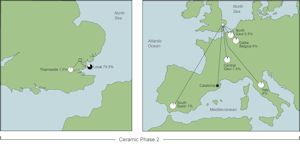
Grog-tempered pottery continues to dominate in Ceramic Phase 2, averaging 89% by weight. Sand-tempered coarse wares have virtually disappeared and are probably residual in most contexts assigned to this phase. Early shell-tempered ware also forms a minor component and is present in only three contexts. Assemblages display a greater diversity of fabric and form, as imports proliferated and the range of grog-tempered copies rapidly expanded. Amphoras have increased both in numbers and types present, with Catalan and salazon vessels from Spain making an appearance alongside Italian wine amphoras. Central Gaulish micaceous ware is present in many Ceramic Phase 2 contexts, showing a large increase on the quantities in Ceramic Phase 1. Gallo-Belgic and North Gaulish fine wares are present in smaller numbers. Assemblages assigned to this phase have begun to exhibit the results of increased trade with Gaul as the Augustan period progressed.
The earliest Key Pottery Group (KPG5) of this ceramic phase is typical in terms of the types of pottery present but atypical in terms of relative assemblage composition. The group differs in the proportion and quantity of imports present. The main deposit, 15416, is considered to be pyre-related debris. The pottery, therefore, is likely to have undergone selection both before, and after, destruction on the pyre. Nevertheless, it illustrates the range of imports available during Ceramic Phase 2. The imported wares include Central and North Gaulish wares as found in Phase 1, with the addition of Gallo-Belgic ware in the form of terra rubra. The assemblage is dominated by the presence of substantial parts of three Dressel 1 amphoras, accounting for 72% of the total by weight. Grog-tempered pottery forms just under 20%, although this figure increases to 71% if the disproportionate weight of the amphoras is removed from the totals. The proportion of grog-tempered pottery is lower than the average, because of the variety of imported fine wares which form 23% by weight (amphora weight excluded). Early shell-tempered pottery accounts for 2% of the total by weight (6% without the amphora) and is represented by a wheel-thrown, near-complete Cam 255 jar. The presence of this jar is notable, as other vessels in this fabric are handmade at this time. Wheel-thrown forms in early shell-tempered ware occur in higher numbers in contexts of the later 1st century AD for the rest of the Elms Farm assemblage.
Other than the amphoras in KPG5, Italian imports comprise a bead-rimmed Pompeian-red ware platter and a wall-sided, gritless, buff ware mortarium; both are typologically early in form. Italian Pompeian-red ware normally occurred in Britain during the mid- to late 1st century AD, but was present on continental sites, including Haltern and sites in the Aisne Valley (S. Willis pers. comm.), in the Augustan period. The mortarium form was also present at Haltern (Loeschcke 1909, 242, type 59), with much variation in detail; some vessels do not have a bead rim and most lack internal grooving. These two details are present on most British site finds (Hartley 1981, 196), but are absent on the mortarium from Elms Farm.
All other Key Pottery Groups assigned to Ceramic Phase 2 are more typical, although, in general, most Phase 2 assemblages are characterised by a higher level of continental imports than those in any other ceramic phase. In spite of these imports, grog-tempered pottery continues to dominate with amounts averaging 91% of the total by weight. The vessels in this fabric now exhibit much diversity of form and decoration, consistent with trends elsewhere in the Essex-Hertfordshire region, probably as a result of experimentation and greater familiarity with wheel-throwing techniques. Copies of imported vessel types abound. Other coarse wares form a negligible component, and of these, early shell-tempered ware accounts for less than 1% by weight.
The imported pottery types include amphoras, Central Gaulish micaceous ware, Gallo-Belgic ware and North Gaulish fine white wares, all present in some quantity and much variety. Other imports occur in much smaller numbers; these include Pompeian-red and Arretine wares, both never common in Britain. Pompeian-red ware, in particular, is rare in contexts dated earlier than c. AD 40, as its distribution is more commonly associated with the Roman military. Its earlier importation into Britain is implied by Peacock (1977a, 158), and there are early 1st century AD examples at Camulodunum (Hawkes and Hull 1947, 221). Arretine ware is present at Elms Farm in relatively higher numbers than is common at other regional sites with imported wares, but still forms less than 1% by weight in stratified contexts. Findspots of Arretine ware in Essex, outside of Camulodunum, are rare. Two of these are in the vicinity. A platter cut down to form the lid for a cremation urn came from the New Cemetery, Heybridge (Kenrick 1986, 53), and a platter sherd was found at Slough House Farm (Dannell 1998, 143). A further platter sherd, stamped, was found in Ditch 424 at Kelvedon, dated to the Tiberian period (Rodwell 1988, 123).
There is a wider range of Italian wine amphoras in this ceramic phase, augmented by Catalan and salazon vessels. Amphoras account for an average of 6% by weight, although those used for transporting wine comprise the largest share. This is normally the case for amphora assemblages of this period in Britain and also in Picardy (S. Willis pers. comm.). Central Gaulish micaceous ware is present in most assemblages and forms the largest component of the imported wares, after amphoras, at just over 2% by weight. The range of forms now includes tazza-bowls and ledge-rimmed beakers, along with platters and flagons. The red-slipped micaceous fabric variation no longer occurs. Gallo-Belgic imports are more numerous and the range has expanded to include forms in terra nigra. This, and terra rubra, accounts for a combined average of just over 1% of the assemblage by weight. North Gaulish fine white ware has marginally increased its presence to 1%, although the rouletted butt beaker Cam 113 is the main vessel type represented. This form is by far the most commonly found import from this source, and is widely distributed in Essex. North Gaulish white ware flagons are also present, identified mainly by their handles.
Small amounts of Gallo-Belgic wares have been found on sites in the vicinity, although none was recovered from the recent excavations in Heybridge, at either Crescent Road (Wickenden 1986) or Langford Road (Langton and Holbrook 1997). Terra nigra was found on two nearby sites in the Blackwater Estuary area, at Slough House Farm and Howell's Farm (Horsley and Wallace 1998, 143, 146). The base and lower body from a terra rubra butt beaker were found at Woodham Walter (Rodwell 1987a, 26, fig. 19.97), where joining sherds were found in three contexts dated to the mid-1st century AD. Finds of North Gaulish white ware in the area are more numerous, reflecting, perhaps, the continuing importation of this fabric into the later 1st century AD. White ware beakers occur at Colchester in contexts as late as Neronian to early Flavian (Bidwell and Croom 1999, 472). A sherd from a flagon was recovered at the Maldon Landfill site (Wallis 1991, 169), and several vessels, mainly Cam 161 two-handled flagons, were found at both Slough House Farm and Howell's Farm (Horsley and Wallace 1998, 143,146). A single Cam 113 butt beaker was also found at Slough House Farm.
Although there is more vessel diversity in Ceramic Phase 2 than previously, jars still dominate at 56% by vessel rim equivalence (EVE). Plain bead-rimmed jars remain much in evidence, but vessels with rippled and cordoned shoulders are more prevalent. Pedestal vessels, such as Cam 204, are also more common. Early shell-tempered jars are few in number, mostly the handmade Cam 254, although there is an example of Cam 255 in Key Pottery Group 5. This is not a common form, and at Camulodunum the Cam 255 is rarer than the ubiquitous shell-tempered Cam 254, where 33 occurrences were recorded against a figure of 238 for Cam 254 (Hawkes and Hull 1947, 268). Storage jars are represented mainly by the Cam 270 and Cam 271 in coarse fabric. These are the most common storage jar forms until gradually superseded by harder-fired storage jar types, such as G44, during Ceramic Phase 4.
Beakers form 17% of the assemblage by EVE, with Gallo-Belgic butt beakers and their grog-tempered copies accounting for the larger share. There is one example of the terra rubra girth beaker, Cam 82. Girth beakers are rare at Elms Farm, and are not commonly-found imports in Britain. The reason for this is largely chronological; Cam 82 girth beakers had a short production span, which ended during the Tiberian period (Rigby 1989, 132). Only eight occurrences of Cam 82 were recorded at Camulodunum, where the type was quickly superseded by Cam 84. Also present at Heybridge, in small numbers, is the ledge-rimmed beaker, Cam 102, in mica-coated Central Gaulish micaceous ware. Later in the phase examples of the Cam 114 beaker appear. These white ware vessels are decorated with herringbone-pattern barbotine, have mica-coating on the rim and are occasionally also red-painted. Their source has not been properly identified, but is likely to be Gallia Belgica (Rigby 1989, 134), and the vessels found in Britain are usually in contexts dated c. AD 10-40.
Open vessel forms, platters and bowls, have increased both in number and variety, accounting for 19% of the total by EVE. The range of bowls, at over 5% by EVE, comprises the carinated Cam 211, tazza-bowl Cam 210, various hemispherical types, and the bobbin-shaped Cam 51 in micaceous terra nigra. Of all vessel classes, platters perhaps display the most diversity in this ceramic phase. They are present in some numbers, in contrast to the previous phase, and this indicates a change in eating habits, or rather, a change in food presentation. This change may also be inferred from the increase in importance of beakers in this ceramic phase. The earliest examples of platters are those in Central Gaulish micaceous ware (mostly Cam 1), and Arretine, although the latter are few in number and largely represented by the shallow Conspectus form 12 (Ettlinger et al. 1990). The later terra rubra and terra nigra vessels are the most numerous of the imported types. Of these, Cam 2 and Cam 5 platters are the most frequent. Later in the phase, the Cam 17 platter in Pompeian-red ware has made an appearance; this is the classic Italian platter in this fabric, probably used for baking. Grog-tempered platters are also numerous, and the number in this fabric is approximately double the number of imported vessels. Many are copies of these imported forms, such as Cam 21 (copying Cam 2), but the quality of manufacture and finish of copied platters is highly variable and consequently there is less standardisation of form.
Other vessel types are few in number; flagons, lids and cups account for 4% of the total by EVE. Flagons are mainly represented by the cream-slipped, micaceous Cam 165, but there is an example of Cam 161 in North Gaulish white ware. There are also two local copies; one is grog-tempered, a copy of Cam 165, the other is in white-slipped grey fabric, probably imitating double-handled North Gaulish flagons Cam 161 or 163. There are three cups; two examples of the grog-tempered, cordoned Cam 212, plus one Cam 56 in terra rubra, and there are just two lids in grog-tempered fabric. Pottery cups and lids appear to be rare at Heybridge in all phases.
Amphoras account for 4% of the total by EVE, although normally their presence is marked by an abundance of body sherds. The range of forms has expanded to include Italian Dressel 2-4 wine vessels, which fully superseded Dressel 1 by the end of the ceramic phase. Amphora types from southern Spain include Pascual 1 wine amphoras, plus salazon vessels used for transporting fish products such as garum. At the end of the phase, the Dressel 20 olive oil amphora has appeared, again marked only by the presence of body sherds. The significance of this wide range is taken up elsewhere.
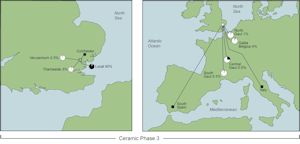
This ceramic phase is characterised by a steady decline in the types of imported wares, an increase in the standardisation of pottery types and a gradual rise in the number of so-called fully-Romanised forms and fabrics. Grog-tempered pottery continues to dominate, but black-surfaced wares, sandy greywares and storage jar fabrics have made an appearance. Imported fabrics such as samian and Central Gaulish glazed ware have superseded Gallo-Belgic, Arretine and micaceous Central Gaulish wares, although the prominence of imports is lower than in the previous ceramic phase. There is a marginally smaller and more uniform range of forms than previously. Amphoras have also declined in quantity; wine amphoras are few, though Dressel 20 and salazon vessels have increased their share.
The proportion of grog-tempered pottery remains steady, averaging 88% of the total by weight. Early shell-tempered ware has increased slightly to 3%, returning to the level that occurred in Ceramic Phase 1. Known production sites include Gun Hill (Drury and Rodwell 1973) and Mucking (Jones and Rodwell 1973) in Essex and the Black Shore area at Cliffe (Monaghan 1987, 33) in Kent. Production of wheel-thrown early shell-tempered ware at these sites occurred towards the mid-1st century AD, but vessels found at Elms Farm remained handmade until beyond the end of Ceramic Phase 3. Sandier coarse wares, in the form of black-surfaced wares, sandy grey wares and storage jar fabrics, account for 7% of the total by weight; their numbers steadily increased through the phase from less than 1% by weight at the beginning to 19% by the end (see Pottery sequence). The presence of these wares can be shown to be intrusive at the beginning of CP3, at less than 1% by weight. Sandy coarse wares only became apparent following the introduction of kiln-firing in Britain. Grog-tempered and other local Late Iron Age pottery is thought to have been traditionally made using 'clamps', which leave no trace in the archaeological record. Exactly when kiln-fired pottery was first introduced is difficult to determine, but, at Heybridge, this is likely to have occurred in the decade AD 35-45, probably in line with settlements elsewhere in the region, such as Colchester and Verulamium. At Heybridge, sandy coarse wares formed a small part of assemblages at the end of Phase 3, but were fully dominant by the beginning of Phase 5. This point is taken up in the Ceramic Phase 5 discussion.
Storage jar fabric occurred in three groups, only very gradually superseding coarse grog-tempered ware. Black-surfaced wares, at 4% by weight, and sandy grey wares, at 2%, are regularly represented throughout, although only in appreciable amounts towards the end of the phase. Colchester buff ware first appears in negligible quantities also at the end of the phase. Verulamium region white ware appears in later groups, in the form of mortarium flange fragments, averaging just over 2% by weight. The end of Ceramic Phase 3 saw non-local Romano-British products showing a definite presence for the first time.
In contrast to Ceramic Phase 2, imports are less numerous. Central Gaulish ware accounts for less than 1% of the total by weight, and much of this is likely to be residual. Gallo-Belgic and North Gaulish ware quantities also remain low at less than 2% by weight. South Gaulish samian and Central Gaulish glazed ware are the only new imports, occurring in very small amounts at the end of the phase. Neither appeared in Britain in any quantity until the mid-1st century AD, although the lack of Tiberian samian at Heybridge is notable. Only a single example was recorded. Settlements receiving imported wares during the early 1st century AD, such as Camulodunum, normally also acquire Tiberian samian (see Hawkes and Hull 1947, 175). Amphoras form a low proportion of the assemblage, averaging 3% by weight. Italian wine vessels are present, but south Spanish Dressel 20 and salazones have the larger share, with the latter predominating at 2%.
Although the number of imports appears to decline markedly, compared with other sites in the vicinity the level and variety remains remarkable. A recent survey of sites that have imports of Late Iron Age date in the Heybridge area (Wallace 1998, 155, table 8) has indicated that such find-spots are sparse. Most of these occurrences are of amphoras. Gallo-Belgic and Gaulish wares appear as occasional examples amounting to only a handful of vessels.
Jars remain the dominant vessel category at 60% by vessel rim equivalence (EVE), and many of the forms are more standardised. Examples of these are the Cam 218 and Cam 220, which are antecedents of Going's G16/17 and G19/20 respectively. The latter continue as late as Ceramic Phase 6, but are recognised as Cam forms in the early part of Phase 3, and as G16-20 in the later part, as the shoulder cordons become less pronounced. Jars with shoulder cordons, plus plain bead-rimmed vessels, are the most common in this ceramic phase, and the club-rimmed Cam 254 is again the sole type identified in early shell-tempered ware.
Platters are much in evidence at 13% by EVE and, similarly, the number of bowls remains constant at 5% by EVE. The most common platter form remains Cam 21, but numbers of Cam 28 increased steadily through the phase. The latter continue into the Roman period, identified in black-surfaced ware as Going's form A2. A samian platter, f18, appeared in an assemblage placed at the end of the phase. Gallo-Belgic platters have declined in numbers, and are restricted to the Cam 2 in terra nigra. The range of bowl forms has expanded to include the incurved Cam 252 and hemispherical forms, as well as the carinated Cam 211. A specialised form is also present; a grog-tempered, spouted strainer-bowl (see .4.2). Towards the end of the phase, the samian bowl f29 occurred; the two examples present, plus the f18, see above, are dated to the Neronian period.
Beakers are somewhat in decline at 13% by EVE, consisting solely of butt beakers - Cam 112 in terra rubra, Cam 113 in North Gaulish white ware, and their respective grog-tempered copies. Cups and lids are still much in the minority, although lids have increased their presence to 3% by EVE. Cups continue to be represented by the grog-tempered Cam 212 and by the Cam 56 in terra rubra. The later Cam 58 is completely absent at Heybridge, although an example of this cup form was found at nearby Slough House Farm (Horsley and Wallace 1998, 143). Flagons have a much-reduced presence, dropping to less than 1% by EVE, and comprising the white ware Cam 161 and grog-tempered copies, one of which is a Hofheim type (J1). By the end of the phase, dishes are apparent, although just two types were identified; the B7 which has an out-turned rim, and the flanged B10, both in grog-tempered fabric. The latter has more in common with the North Kent form 5B2, which had continental prototypes (Monaghan 1987, 138). Mortaria form a very low proportion, accounting for less than 1% by EVE. This is consistent with the evidence from other non-military sites of this period. The form identified is the D1-type mortarium from the Verulamium industry. This was among the first industries to be established following the conquest, and it seems that the products from Verulamium reached Heybridge before those from nearby Colchester. This is in contrast to Chelmsford, where mortaria were almost always supplied by Colchester until well into the 3rd century (Going 1987, 108-12), and where mortaria are rare, in any fabric, until at least AD 160.
Amphoras maintain their presence, but occur in the key pottery groups as body sherds only. Dressel 20 olive oil containers are now slightly in the majority overall, but salazon and Dressel 2-4 vessels are still also present.
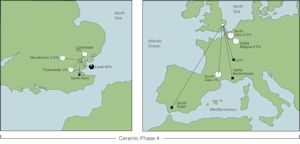
Local coarse wares continue to dominate assemblages, accounting for over 90% as measured by EVE. Sandy grey ware forms 12% of the combined Phase 4 assemblage, a substantial enough proportion to confirm increasing levels of production during the Neronian and early Flavian periods. Black-surfaced and grog-tempered wares contribute roughly equal amounts, forming 31% and 36% respectively. This would seem to be in sharp contrast to Chelmsford, where grog-tempered pottery was represented by a mere handful of body sherds. However, none of the groups assigned to Chelmsford Phase 1 (Going 1987, table 8) pre-dates AD 65. Viewed against these, assemblages at Elms Farm dated to the last decade of Phase 4 (for example KPG18, yielding comparatively low proportions of grog-tempered pottery) demonstrate few differences. The relatively minor appearance of grog-tempered pottery in later Phase 4 contexts and its virtual absence at Chelmsford suggest that the fabric ceased to be produced c. AD 65/70, but could have remained in circulation at Heybridge for a further decade. As at Chelmsford (Going 1992a, 96), much of the reduced coarse ware at Heybridge was manufactured locally. Some at least may have derived from the larger potteries at Ardleigh and Colchester.
Besides the major coarse wares, what little pottery there is came from a variety of sources, both regional and continental. The more prolific of these were Colchester and South Gaul, respectively. But even these two barely contribute a total of 6% EVE to the assemblage. Heybridge continued to receive buff ware from Colchester, and early Colchester colour-coated fine ware is also present. New supplies of this fine ware were unlikely much after AD 55; at Colchester the fabric was recovered from deposits dating up to AD 55 (Symonds and Wade 1999, 233). That production had ceased by this time is seemingly confirmed by the absence of the fabric at Chelmsford.
Of the remaining Romano-British regional suppliers, only the Verulamium region industry provided any competition to Colchester, but unsurprisingly, given their relative distances from Heybridge, the market always favoured Colchester. White ware continued to come from Verulamium, now in the form of flagons as well as mortaria. Fine buff ware ring-and-dot beakers were probably reaching Heybridge from Verulamium also, although contexts in which the fabric appears cannot be assigned to this phase with certainty. The fabric was nevertheless present at Chelmsford and Colchester at this time (Going 1987, table 9; Bidwell and Croom 1999, 471-2). Heybridge may have provided a very minor market for the Verulamium industry; its wares were recovered from Crescent Road in small quantities from unstratified contexts only (Wickenden 1986, table 4). Early shell-tempered ware from south Essex or north Kent continued to arrive at the settlement, although the amount declined from previous levels to just 1%. Almost 5% was recovered from Chelmsford (Going 1987, table 9). Fine grey ware from north Kent was also reaching Heybridge, albeit in negligible quantities.
Heybridge received a number of continental fine wares during this phase. South Gaulish samian ware amounts to 3% of the overall assemblage, up from Phase 3. Other continental imports include Lyon ware from Central Gaul, white ware from North Gaul, and mica-dusted ware, terra rubra and terra nigra from Gallia Belgica. Terra rubra died out early in the phase, but terra nigra can still be found in contexts dating to as late as AD 85 (Rigby 1989, 123). Measured by weight, none provided more than 1% of the assemblage; the supply from North Gaul and Gallia Belgica had all but dissipated, and there is little evidence from either Heybridge or Colchester to indicate supply beyond the late Neronian/early Flavian periods. Dressel 20 and salazon amphoras from southern Spain are still present. The former accounts for 1% of the assemblage by weight and is the commoner of the two amphora types.
Wide-mouthed eating and food serving/preparation vessels - platters, dishes, bowls and mortaria - account for 14% of the Phase 4 assemblage, measured by EVE. As at Chelmsford, platters are the best represented of these at 6%. Most platters (A2-A4) were produced locally in reduced coarse wares and based on Gallo-Belgic prototypes. There was a much smaller number of samian platters, either f15/17 or f18, and one example of the Gallo-Belgic platter (Cam 13) in terra nigra. Dishes account for just 1%. Platters and dishes may well have been serving the same functions, as there is little to choose between the two in terms of size and shape.
Mortaria are poorly represented. The form was imported from both Colchester and Verulamium. While this would seem to indicate that the inhabitants of Heybridge only cautiously embraced specific culinary habits, robust, wide-mouthed bowls (such as C28 and C33) may well have served mortaria-associated functions (for example mixing and pounding) quite adequately. Bowls were produced locally, though one form (C14) was based on samian f29 or f30.
There was a clear preference towards beakers, rather than cups. The latter are found nearly always in samian ware (f27 and f35). Beakers are confined to two types; the globular H1 beaker and the butt-beaker H7, both ultimately derived from Gallo-Belgic prototypes, one of which, the Cam 112 beaker, was also present in terra rubra. Flagons form 3% of the assemblage and are typically ring-necked.
Jars, present in a range of coarse ware fabrics, provided the largest single category of vessel class by far, accounting for 68% of the assemblage. The reasons for this are twofold. Jars served more functions; most obviously, cooking, transport and storage, and a greater number of jars would be required at any one time to fulfil all requirements. Secondly, these functions perhaps could not be carried out easily using vessels made of cheaper, but perishable materials, such as wood. There may be methodological reasons, too. Labels, such as 'jar' or 'beaker', are assigned to vessels largely on the basis of shape. There is always a risk that these labels, or classes, with their inherent functional assumptions, act like interpretative straitjackets and the possibility that vessels of the same types could serve different functions is ignored. In the case of jars, obvious functions (cooking, transportation and storage) may be over-emphasised.
Jars comprise mainly high-shouldered types (G3, G17-G20, G23), all continuing from Phase 3 and very much in keeping with Chelmsford, despite the difference in the types and proportions of coarse wares. Pit 20009 provided a complete example of a narrow-necked flask or bottle (G40). The form is unusual in this phase and unknown in earlier phases; it is commonly found in 2nd-century burials, but did not appear at Chelmsford or Witham until the 4th century (Going 1987, 27; Turner-Walker and Wallace 1999, table 20). The early shell-tempered Cam 254 jar is replaced by the previously absent shell-tempered Cam 258.
Lids form 4% of the assemblage, representing a slight increase from Phase 3. None could be matched with specific jars; indeed, it is possible that lids were made without reference to the specifications of any individual jar, but were instead general purpose and used simply as covers, rather than well-fitting jar lids.

Ceramic Phase 5 heralds significant change from Phase 4. Locally made wares (essentially black-surfaced ware, fine and sandy grey wares, grog-tempered ware and storage jar fabric) again dominate the assemblage, forming 92% measured by EVE, but the difference rests with the proportions of these fabrics. Most dramatically, grog-tempered pottery has declined from over 35% to just 2%. Conversely, sandy grey ware and black-surfaced ware have increased their proportions; the latter now accounts for 47%, while the former has increased its share to 29%. Although the proportion of fine grey ware remains reasonably steady, that of storage jar fabric has almost doubled from 25% by weight in Phase 4 to 42% in Phase 5. Grog-tempered pottery was no longer being supplied by this time; potters were now exclusively supplying sand-tempered products. As expected, grog-tempered pottery is absent from later 1st and early 2nd century contexts at Crescent Road, Heybridge (Wickenden 1986, table 4).
The pattern is only partially repeated across the region. That Chelmsford was receiving black-surfaced ware and sandy grey ware (with the former predominating), but no grog-tempered ware (Going 1987, table 9) is unsurprising. In sharp contrast, Chigborough Farm, only 2km to the east of Heybridge, produced grog-tempered pottery, albeit fragmented, along with storage jar fabric (Horsley and Wallace 1998, 146-8). At Ivy Chimneys, Witham, grog-tempered pottery continued to form the largest proportion of pottery until the end of the 1st century AD. Until then, the amount of sand-tempered reduced coarse wares present was negligible (Turner-Walker and Wallace 1999, 163).
Clearly, these settlements were not receiving pottery from a single large supplier and were not dependent on a major producer, such as Colchester. The mechanisms controlling the production and supply of coarse wares are not clearly understood and, given the differences in the coarse wares even at neighbouring places, namely Heybridge and Chigborough Farm, may be complex. Some possibilities may be suggested, however. Coarse wares were supplied at a very local level, perhaps via the 'village potter', whose products were solely confined to the settlement. Alternatively, pottery was supplied at a wider, but still restricted, level, with the region divided into a number of small, possibly overlapping, zones based around a number of small-scale concerns. Heybridge perhaps lay at the edge of one zone, with Chigborough Farm and Witham placed within another. This perhaps best fits a model that Hodder provides, based on the organisation of 13th-century rural potters (Hodder 1974, 355). In any case, the eventual widespread adoption of sand-tempering reflects the gradual displacement of potters familiar with the grog-tempering tradition. This accounts for the differing periods at which grog-tempered pottery was superseded by sand-tempered reduced wares. At Heybridge, sand-tempered wares fully replaced grog-tempered wares by c. AD 70/80. Evidently, this process occurred somewhat later at Witham and Chigborough Farm.
Other British coarse ware industries contributed a total of little more than 1%, measured by EVE. Verulamium and Colchester continued to supply pottery, with the latter enjoying a larger market, as is the case at Chelmsford (Going 1987, table 9). Verulamium also supplied a very small amount of fine ware, in the form of ring-and-dot beakers. Early shell-tempered pottery from south Essex or north Kent is also present, again in negligible quantities. The end of the phase marks the beginning of the supply of BB2.
Fine wares account for 13% of the assemblage by EVE. Almost half of this (6%) was locally produced, presumably made by the same workshops that produced coarse wares. A greater range of other fine wares was present here than in Ceramic Phase 4, reflecting the diversification of the pottery industries. North Kent potters increased the supply of grey ware, while introducing oxidised products. London potters were supplying reduced and mica-dusted ware products and Highgate potters supplied fine grey ware. In general terms, Heybridge and Chelmsford share a similar pattern of supply. There is a dearth of anything other than local reduced coarse wares at Ivy Chimneys and Chigborough Farm until the 2nd century.
Other sources of pottery include Hadham, forming less than 1% by weight, which supplied flagons in a white-slipped oxidised fabric. The early Hadham industry may have been responsible for oxidised stamped ware during this time (Rodwell 1978, 238-41), though the evidence for production of this ware at Hadham in the absence of wasters or even substantial sherds is unproven. Lead-glazed ware from south-eastern England was reaching Heybridge at this time.
La Graufesenque in southern Gaul continued to supply all the samian ware to Heybridge, amounting to 2% measured by EVE, to be replaced by the Central Gaulish industry at Les Martres-de-Veyre in the early 2nd century. This follows an established pattern across Britain (Tyers 1996, 112-13). Central Gaulish potters at Lezoux supplied colour-coated products into the late 1st century AD. Black eggshell ware from northern Gaul (Tomber and Dore 1998, 16) is also present in this phase, represented by two beakers. Amphoras, principally Dressel 20 from south Spain, but also including Gaulish amphoras, were imported and provide 1% of the assemblage by weight.
Platters and bowls form 18% of the assemblage, as measured by EVE, with platters accounting for 12%. A quarter of these are samian (f15/17, f18 and f18/31). Gallo-Belgic style platters (A2-A4), however, account for the majority of the class. New dish forms, namely the plain-rimmed B1 and the bead-rimmed B2, were introduced at the end of the phase. Along with the well-established B7 dish, the class forms 4% of the assemblage. Again, there is no significant difference in size between platters and dishes.
Along with platters and dishes, bowls increase their share from Ceramic Phase 4. There is a variety of bowls present, from the finely made C12, based on samian f30, to the large, squat, wide-mouthed vessels normally found in storage jar fabrics. One small bowl (Cam 41), which was possibly made in London (Davies et al. 1994, 136), is mica-dusted and undoubtedly designed to imitate metal prototypes. Mortaria continued to reach the settlement from Colchester and Verulamium in negligible quantities. Chelmsford experienced a slight increase in the volume of mortaria at this time (Going 1987, table 10), although the class is poorly represented even there.
The range of beaker and flagon types is little altered from Phase 4. Together, these account for 13% of the assemblage. The globular H1 beaker and the butt-beaker H7 remain the principal beaker forms. Poppy-headed beakers (H5-6) are largely absent, even at the end of Phase 5. The type was present at Chelmsford by this time, however (Going 1987, 28), and was produced at Ardleigh (Going 1999b, 149), in North Kent (Monaghan 1987, 218) and Highgate (Davies et al. 1994, 83). At these sites, the poppy-headed beaker had superseded both the H1 and H7 by the early 2nd century. The market at Heybridge favoured producers who continued to make the H1 and H7 beaker forms. Ardleigh may be ruled out as a supplier for this reason, certainly during the early 2nd century, although the production of the H1 beaker (Cam 108) continued at Colchester (Bidwell and Croom 1999, 472). Flagons are restricted to the ring-necked J3. Chelmsford experienced a decline in these classes around this time or slightly later (Going 1987, table 10). Flagons and beakers do not feature at Ivy Chimneys until the 2nd century (Turner-Walker and Wallace 1999, table 20), while flagons, at least, were always rare at Chigborough Farm and Ardleigh. The regional decline in beakers, or outright scarcity, may suggest that, by choice, people preferred to drink out of cups, small jars and vessels made from perishable materials. As in Phase 4, the samian industries almost exclusively supplied cups, namely f27 and f35.
Ceramic Phase 5 marks the early appearance of the bowl-jar. The class is restricted to the high-shouldered E6.2, produced in black-surfaced ware and present in a late 1st century context. Again, jars dominate the assemblage. The greater visibility of residual pottery in this phase probably accounts for the slight decrease of the class to 65%. Many of the jar forms prevalent in Phase 4 - G3, G8, G16, G17-G20, and G23 - remain so in Phase 5. The cordoned G17 and high-shouldered G23 are among the commonest jar types. It is interesting to note that although the G17 (Cam 218) and G23 (Cam 266) were manufactured at Ardleigh up to the mid-2nd century (Going 1999b, 149), other common Elms Farm jar types - the G19-20 among them - are missing from the Ardleigh repertoire. While Ardleigh is unlikely to have supplied much pottery to Heybridge, the presence of the G17 and G23 jar types at both sites demonstrates just how ubiquitous these forms were across the region.
At 2%, lids now take a smaller share of the assemblage than in Ceramic Phase 4. Clearly, purpose-made ceramic lids were exceptional, the norm perhaps being stone or ceramic caps, or covers and bungs made out of organic materials.
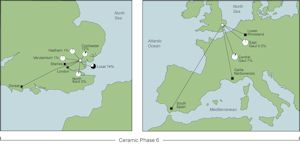
The proportions of traded wares expanded at the expense of locally produced wares. Collectively, black-surfaced ware, fine and sandy grey wares and storage jar fabric take a reduced 70% share of the market measured by EVE. Fine grey ware has fallen from 6% in Ceramic Phase 5 to 3% in Phase 6; black-surfaced ware has dropped to 34%. The proportions of sandy grey ware and storage jar fabric are virtually unchanged. At the same time, after its early appearance at the end of Ceramic Phase 5, BB2 now takes a larger (6%) share of the market. North Kent grey ware also increased its share from 1% to 5%, reflecting the growth in production at this time (Monaghan 1987, 219). It is tempting to link the rise of these fabrics to the decline of black-surfaced and fine grey wares; the first group replacing aspects of the second. Why this occurred is unclear, though aggressive marketing, such as flooding the market with cheaper and more desirable products, can be cited as a reasonable cause.
The lack of contemporaneous, fully quantified, pottery at other sites in the region makes comparison difficult. Trends that can be drawn out of published data are mixed. At Chelmsford, black-surfaced wares (Fabrics 34 and 45), fine grey ware (Fabric 39) and North Kent fine ware decreased at this time, while sandy grey ware (Fabric 47) and BB2 increased (Going 1987, table 9). Black-surfaced ware also declined at Crescent Road while fine grey ware remained steady and sandy grey ware and BB2 increased their shares. North Kent grey ware was absent from this assemblage (Wickenden 1986, table 4). The decline of black-surfaced ware was seemingly regional, but the cause of this may be in part local, due to consumer demand as much as successful marketing; coarse grey pottery generally increased in tandem with BB2, suggesting that local producers were not in decline, but merely refocusing their markets.
With the parallel increases of North Kent grey ware and BB2 at Elms Farm, it is worth considering the possibility that North Kent supplied both fabrics, at least up until Ceramic Phase 7. Crucially, Going noted that BB2 vessels recovered from a Hadrianic/early Antonine pit at Chelmsford should perhaps be given a Kentish origin on stylistic grounds (1992a, 102), and observed that BB2 was far more common in Kent than it is in central and southern Essex at this time (1987, 112). In the absence of petrological analysis of all sherds, the weight of probability tends to support Kent for the initial supply of BB2 (although a Colchester source is assumed for the purpose of the maps).
Even if it did not supply BB2, Colchester provided a range of other wares to Heybridge. As a whole, the industry took a market share of 6%, or 12% including BB2. As at Chelmsford (Going 1987, 110), the settlement continued to receive buff ware, almost exclusively mortaria. Colchester colour-coated and samian wares reached Heybridge for the first time, although the former was unlikely to have appeared in Heybridge much before c. AD 140, some fifteen years after production began (Symonds and Wade 1999, 264-6). The ware is virtually absent from large groups dated earlier than c. AD 140, but is strongly represented in assemblages dated later, such as KPGs 22 and 23. This would seem to be in keeping with Chelmsford, which received the ware after c. AD 160 (Going 1987, table 9).
Pottery continued to be imported from Verulamium in small quantities, as in Phase 5, taking a 1% share of the market. Pottery from Hadham is again present; that fine white-slipped Hadham products occur is to be expected (Going 1999a, 297). Less so is a red colour-coated flagon (J8), from the same source, recovered from pit 4152 in the central area. The presence of this ware is unusual at this time, as it was not exported in any quantity into the region until the later 3rd century (Going 1999a, 297). Its early appearance at Heybridge suggests limited exportation, and was, perhaps, even a one-off. London fine ware and South-east English glazed ware are present still in this phase, as is early shell-tempered ware, although given that production of this fabric had ceased by c. AD 110 (Monaghan 1987, 223), its presence, which is less than 1% of the assemblage, may be residual. BB1 from Dorset, represented by a single body sherd, makes its initial appearance in pit 9029 (KPG24), which was infilled after AD 160.
Samian supply more than doubled in this ceramic phase, with Central Gaulish samian, mainly from Lezoux, showing the largest increase to form 7%. As mentioned above, Colchester samian appears for the first time during this phase, as does East Gaulish samian, initially from La Madeleine, then from Rheinzabern. Each accounts for 1% of the assemblage overall. A decline in samian imports during the early part of the phase, or, indeed, during the early 2nd century (Rodwell 1988, 98), is a phenomenon observed at Chelmsford (Going 1987, 108), but not clearly visible at Heybridge. Other continental pottery is poorly represented compared with samian. Lower Rhineland colour-coated ware and Central and East Gaulish Rhenish wares were imported during this phase, but their presence amounts to a mere handful of sherds. Gaul and southern Spain continue to supply amphoras, the latter increasing its share to form 1% of the assemblage by weight.
A number of significant trends are evident in this phase. Platters decrease to form 2% of the assemblage measured by EVE. Bowls fall from 7% in Ceramic Phase 5 to 3% in Phase 6. Meanwhile, the proportion of dishes increases to 18%. Platters are now largely confined to samian f18/31, itself transitional between a platter and a dish, and the A4 bead-rimmed type from North Kent. There were three principal dish forms at this time: - the plain-rimmed B1, the shallow bead-rimmed B2 and the deeper, bowl-like, bead-rimmed B4, all available mainly in BB2 and black-surfaced ware. The average diameter of B2/B4 dishes in Phase 6 and that of platters and bowls in Phase 5 is almost identical. Either eating habits had radically altered during the mid-2nd century or, as is more likely given vessel sizes, dishes, mainly in BB2, were replacing and serving the same functions as black-surfaced ware platters and bowls. This trend is reflected at Chelmsford, where dishes very soon became the dominant open form after AD 125 (Going 1987, 110; 1992a, 103). The eventual disappearance at Chelmsford of all platters except samian was complete by c. AD 160, and by around AD 140 at Heybridge. Samian bowls f37 and f38 were imported from Central and East Gaul respectively, while the dish f31, also from Central Gaul, was present after AD 140.
The proportion of mortaria remains largely unaltered. Vessels were imported from Colchester, though a smaller number came from local or East Anglian sources and Verulamium. A D1 mortarium in a white-slipped sandy grey ware is present, though unusual in this fabric. Bowl-jars are also rare in this phase; the ledge-rimmed E2 type replaced the E6 of Ceramic Phase 5.
As expected, jars remain the most prolific vessel class, although their share is slightly reduced at 57%. Use of the G44 storage jar continued. There are fewer high-shouldered jars (G16-20) than in Phases 4 and 5, as represented by EVE. These were replaced by a narrower suite of vessels, namely the G22 with stabbed shoulder, the increasingly prevalent G23 jar, and the carinated G29 jar. Other jar forms were present, including the oval-bodied G24, which became more popular later in the Roman period. This pattern is repeated at Chelmsford (Going 1987, 110).
Beakers retain their share of the assemblage in Ceramic Phase 6. Poppy-headed H6 beakers, present in fine grey and North Kent wares, replaced H1 and H7 beakers as the commonest drinking form, a little later than at Chelmsford. Roughcast and colour-coated H20 beakers were imported from Colchester and the Lower Rhineland. Large, folded, grey ware beakers (H34/H35), typical of the late 2nd century onwards, appear towards the end of the phase. Cups increase their share to 4%. Typically, cups remain restricted to samian wares; f27, the commonest cup of the previous two phases, is superseded in Phase 6 by f33. Flagons, at 2%, continue to form a small proportion of the assemblage. The ring-necked J3 flagon is largely absent from this phase. Lids remain steady at 1%, and the K3 and K6 types present in Phase 5 are also present in Phase 6.
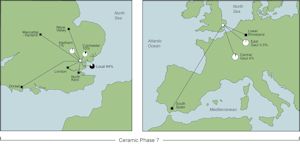
Locally made pottery regains its very dominant position within the assemblage, accounting for 84% measured by EVE. For the first time, sandy grey ware takes a larger market share than black-surfaced ware. The former provides 39% of the principal local wares (black-surfaced ware, fine and sandy grey ware, and storage jar fabrics), while the latter accounts for 26%. Fine grey ware takes a reduced 4% share. The decrease of the proportion of storage jar fabric is considerable - from almost 50% by weight in Ceramic Phase 6 to 13% in Phase 7. Storage requirements were presumably being fulfilled using alternative means, such as barrels.
The Hadham products reaching Heybridge increased and include oxidised ware, and grey and black-surfaced wares. These reduced fabrics were presumably made in competition to BB2. However, the industry was still a minor supplier at this time, taking a 1% share of the market by weight; only the black-surfaced fabric is sufficiently abundant to be represented by EVE (1%). This ceramic phase is devoid of Hadham white-slipped fine ware, although unsourced white-slipped fabrics are present.
The Colchester industry consolidated its market position, increasing its supply of buff and colour-coated wares to 7% by EVE. North Kent grey ware is virtually absent. Forming 3% of the assemblage, supply of BB2 from Essex or Kent continued, though perhaps at a slightly reduced volume from Ceramic Phase 6. London supplied fine reduced ware and possibly mica-dusted ware; both are represented by body sherds. Mica-dusted ware was present in assemblages at Colchester until c. AD 225 (Symonds and Wade 1999, 245), although normally considered to be residual by this time in central Essex (Going 1987, 5). Heybridge received negligible quantities of Nene Valley colour-coated ware at the end of the phase. This industry did not yet threaten Colchester as the main British supplier of fine ware. Mancetter-Hartshill mortaria and BB1 vessels are also present during this phase.
Central Gaulish samian forms the largest single group of continental fine wares in this phase. Rather than an overall decrease in the supply of new samian, reflecting the decline in output after AD 170 (Marsh 1981, 185), the Elms Farm figures are mixed, with Central Gaulish samian decreasing in terms of EVE, but increasing by weight. This must reflect the increased residual element to the samian assemblage - a reasonable expectation if samian vessels were valued items and thus had longer lives than other pottery. New vessels did not perhaps replace older ones, but rather added to them, enlarging the pool of vessels current and in use at a given time. East Gaulish samian, Central and East Gaulish Rhenish wares were also imported, but with no apparent change in quantity. By this time, Lower Rhineland colour-coated ware had all but ceased to be imported, its presence reduced to a few sherds. Dressel 20 amphoras were imported from southern Spain in greater numbers, forming 3% of the assemblage by weight.
Generally, the range of forms present in this ceramic phase is more restricted than in Phase 6. Notably, platters, as a class, have disappeared altogether, fitting a pattern identified at, for example, Great Dunmow (Going and Ford 1988, fig. 52) and Chelmsford (Going 1987, table 10). Bowls, comprising samian f37 and the mica-dusted Cam 41, are reduced in number, forming just 1% of the assemblage measured by EVE. Dishes, then, were virtually the sole type of ceramic eating vessel, produced in a range of reduced fabrics, from locally made black-surfaced and sandy grey wares to Hadham ware and BB2. The bead-rimmed B2 and B4 types are by far the most common of dishes, followed by samian f31 and then the plain-rimmed B1 and B3. Mortaria take a 5% share of the assemblage. This increase and the fact that local potters were inspired to produce mortaria at this time may well testify to an increasing popularity of specific cooking styles (that is, recipes requiring the mixing, grinding or pounding of ingredients). Cups take a reduced 1% share, never regaining former levels. The class is, again, restricted to samian; f33 had by this time totally replaced f27.
Jars again make up the largest class, forming 56% of the assemblage. Jar types typical in Phase 6 (G22-4) remain so in Phase 7. There is little evidence that the carinated G29 jar survived into the late 2nd century. By far the most common jar form, however, was the ledge-rimmed jar (G5). Local production of this form, along with the oval-bodied G24 and G25 jars, is attested. The G5 jar was undoubtedly commoner in kiln assemblages than the G24 or G25 types. There is no suggestion in these assemblages that ceramic lids were made to fit the G5 jar. Indeed, typological development of lids was stagnant; no new lid form had been introduced since Ceramic Phase 4, and just one type (K6) is represented. Beakers take 11% of the assemblage. The appearance of the poppy-headed beaker at Heybridge was relatively fleeting and had disappeared by the late 2nd century to be partly replaced by an increasing range of Colchester products, including the roughcast H20 beaker and barbotine-decorated H24 beaker. Folded grey ware beakers, introduced during Phase 6, became more common in Phase 7. The range of flagons is somewhat meagre, restricted to bead-rimmed or tall, narrow-necked types.

In contrast to earlier phases, the quantities of pottery, along with form diversity, are much reduced. This reflects the general economic trend during the 3rd century, which continues into the next phase. The similarities between the pattern of pottery supply to Heybridge (Wickenden 1986 and this report) and Chelmsford (Going 1987, 113) are more marked than any differences. Thus, in both settlements, locally produced pottery is, again, predominant, accounting for 85% of the overall Ceramic Phase 8 assemblage at Elms Farm measured by EVE. The proportions of black-surfaced and sandy grey ware remain relatively stable. Fine grey wares substantially increased their share to 17%, a surge that may have been in response to successful marketing of Hadham fine fabrics or a general increase in the use of dishes. After its decline in Phase 7, storage jar fabric in this phase returned to something resembling former levels.
The Colchester industry continued to supply colour-coated vessels. However, the supply of Colchester buff ware declined, despite the industry flourishing at this time (Bidwell 1999, 496). Heybridge continued to receive BB2. Nene Valley colour-coated ware is barely present, but in any case the industry may have preferred to concentrate on the export of white ware mortaria, which appeared at Heybridge at the end of this phase. BB1 sustained its tenuous grip on the market, its presence largely limited to body sherds.
The supply of samian to Heybridge reflects established regional patterns. East Gaul became the sole samian provider, though its products amount to less than 1% of the assemblage; most samian in this phase is residual Central Gaulish. Central and East Gaulish factories continued to supply Rhenish ware, however, but not beyond the early 3rd century. Amphoras from Gaul and southern Spain continued to be imported during this phase, but in reduced quantities.
The proportion of dishes has increased to 27%. The majority of dishes were made locally, with a smaller amount produced in BB2 fabric or imported from Hadham. The usual dish forms are represented, including the plain-rimmed B1 and B3 (the latter are more frequent), and the ubiquitous bead-rimmed B2 and B4 types. Two new forms were introduced by the mid-3rd century; the incipient bead-and-flanged B5 and the stubby bead-and-flanged B6.1. The East Gaulish samian f31 dish is also present.
The rise of dishes is offset against a decline in jars, with the range of different jar forms becoming restricted. The ledge-rimmed G5 remains one of the more common forms, along with the oval-bodied G24-5. The everted-rimmed G9 is also more common than in Ceramic Phase 7. Just one new jar form is introduced; the small G42 storage jar. By this time, non-samian bowls are entirely absent from the assemblage, although bowl functions were perhaps served by the E2 and E5 bowl-jars, which account for 2%. Mortaria, taking a reduced 2% of the assemblage, are restricted to the hammerhead-rimmed D11 type, and the reeded Nene Valley varieties. The range of beaker types present is broadly similar to that in Ceramic Phase 7. Colchester colour-coated roughcast beakers (H20) and grey ware folded beakers (H34/35) are the most common. Flagons are very poorly represented and few diagnostic forms could be identified. However, one example present is in Hadham white-slipped ware. A single lid type, the black-surfaced K2, occurs in this phase.
The range of forms present is more restricted than in Ceramic Phase 7. This narrowing of the range available for use seems to be a sustained phenomenon, but trends identified here are broadly reflected at other sites, too. The increasing dominance of dishes has already been discussed in respect of Group 464/820 at Great Dunmow (Going and Ford 1988, fig. 52). At Chelmsford, dishes increased in number, while jars declined during the 3rd century. Bowls and mortaria also decreased (Going 1987, table 10). B1, B2/B4 and B5 dish forms are present in the mid-3rd century kiln assemblages recovered from Orsett (Cheer 1998, 99). In none of these cases are dishes commoner than jars, although the growing importance of dishes is apparent. This is also the case at Heybridge.

Heybridge was receiving pottery from a wider range of regional sources in Ceramic Phase 9 than in Phase 8. As ever, locally produced pottery was predominant, taking an 81% share of the assemblage measured by EVE. The proportions of the major local wares (black-surfaced ware, fine and sandy grey ware) are largely unchanged from Phase 8; the proportion of storage jar fabric has fallen once again, and now forms 21%. Ceramic Phase 9 marks the initial appearance of Rettendon ware, the distinctive late Roman flint-tempered fabric. This accounts for 2% of the assemblage by EVE.
The supply of Colchester products declined during this phase and the colour-coated products are largely residual. The supply of BB2 from Essex or Kent also decreased. A reasonable cause for this decline was the increased importation of BB1, which forms 4% of the assemblage by EVE. A range of Hadham wares is represented. Reduced wares, particularly the grey fabric (HAR), remained the most common of these. The Nene Valley industry increased its supply of colour-coated ware, filling the gap left by the Colchester industry, and reflecting the regional expansion of the industry at this time (Going 1987, 114; Bidwell 1999, 496). Importation of Nene Valley white ware mortaria continued, although the Oxfordshire industry, which also exported white ware mortaria, provided competition. Continental imports are present in this phase, but all are residual.
Dishes account for 23% of the assemblage. As at Chelmsford (Going 1987, 114), straight-sided B1 and B3 dishes are now the most prolific types, vastly outnumbering bead-rimmed B2 and B4 types (not represented at Chelmsford at this time). Bead-rimmed dishes, however, remain more common than flanged B5 and B6 dishes, the latter both introduced towards the end of the 3rd century, and it is likely that bead-rimmed dishes were produced locally well into the second half of the 3rd century. Notably, the Hadham and BB1 factories were almost exclusively supplying straight-sided and flanged dishes at this time, suggesting that the continued production of bead-rimmed dishes was a phenomenon restricted to producers local to Heybridge. East Gaulish samian dishes (f31) are present, but residual in this phase.
Local or East Anglian mortaria production appears to have increased, perhaps in response to the importation of Nene Valley and Oxfordshire mortaria. Hammerhead-rimmed D11 and wall-sided D13 mortaria were the preferred shapes. Ledge-rimmed E2 bowl-jars and the bead-rimmed E5 types are again represented.
Jars account for 52% of the assemblage. The ledge-rimmed G5 jar is ubiquitous. Interestingly, the high-shouldered G23 jar, last seen in Ceramic Phase 7, makes a dramatic reappearance, becoming the second commonest jar form, while the oval-bodied G24 lies third. This should not overly concern us, as there is little typological difference between these two forms; both types were present at Chelmsford at this time (Going 1987, 114). The everted-rimmed G9 jar gained in popularity, appearing in BB1 as well as in local wares. New jar forms include the frill-rimmed G26 and large narrow-necked G38, both made locally. Beakers, forming 14% of the assemblage, were the sole class of drinking vessel, and restricted to locally made folded beakers (H33-H35) and barbotine-decorated beakers from the Nene Valley (H28, H32, and H41). Contemporaneous Colchester colour-coated beakers are entirely absent. Flagons are rare, while lids are non-existent.

Locally produced pottery is, as always, predominant, forming 88% of the assemblage measured by EVE. Both sandy grey ware and black-surfaced ware have increased their proportions by weight. The proportion of storage jar fabric has further declined to 7% by weight. The level of production of the fabric was minimal, if it continued at all. While the range of sources that supplied Heybridge increased from Ceramic Phase 9, the regional industries made very little impact upon the market. No industry increased its market share; at best, the more successful manufacturers merely retained their markets. As at Colchester (Going 1999a, 297), Hadham increased its supply of oxidised ware, though the overall share of Hadham fabrics remained the same as Phase 9 at 3%. Colchester buff mortaria (D1 and D11) and Essex/Kent BB2 bead-rimmed dishes (B2/B4) are present in Ceramic Phase 10, but both wares are likely to be residual by this time. Supply from the Nene Valley industry continued, colour-coated products being the chief imports, but painted ware and white ware mortaria were also reaching Heybridge.
The Rettendon ware producers failed to capitalise on their initial market successes. Rettendon ware took 2% of the market share by EVE at Heybridge, compared to 17% at Chelmsford (Going 1987, 115). This difference reveals an interesting picture of local trade patterns. Between 40% and 50% of the pottery at Chelmsford during the first half of the 4th century was from production sites within the town itself (Moulsham Street) and at Inworth (Going 1987, 89). These and other known Rettendon ware production sites - at Sandon and Rettendon itself - were located away from principal roads that lead to Heybridge. In terms of the distribution of this fabric, Heybridge, like Great Dunmow (Going and Ford 1988, 70), fell outside its catchment area. It is reasonable to suggest, then, that the low proportion taken by Rettendon ware should be expected given these factors; the distribution of Rettendon ware was restricted and essentially local. A mid-4th century group recovered from Chigborough Farm (Horsley and Wallace 1998, table 7) supports this suggestion. Rettendon ware makes up just 1.5% of this assemblage. As local production of a flint-tempered fabric during the early 4th century is attested, it is possible that some of the pottery labelled as Rettendon ware at Elms Farm is in fact of local origin.
Ceramic Phase 10 marks the probable initial appearance in the mid-4th century of late shell-tempered ware from Harrold in Bedfordshire or Lakenheath in Suffolk, though accounting for less than 1% by EVE, and Oxfordshire red colour-coated ware, though no rims survive. Heybridge was receiving no new pottery from continental sources. The appearance of East Gaulish and Central Gaulish samian in this phase is entirely residual.
Dishes account for 32%, measured by EVE. The straight-sided B1 dish is the most prolific type of its class, followed by the bead-and-flanged B6. This remains the case until the end of Ceramic Phase 11. These dish types were available in a range of fabrics, including local reduced wares, BB1 and Hadham wares. The proportion of grooved straight-sided B3 dishes declined dramatically, suggesting that production of the form had ceased. Notably, the type is absent from production waste assemblages, which date to the late 3rd or first half of the 4th century. Of the dish population, bead-rimmed B2/B4 dishes continue to form a substantial proportion. Given that these types are almost certainly residual, as they are also absent from production waste assemblages, this reflects their overwhelming presence in previous ceramic phases, and the length of time that some examples must have been in use. The flanged B5 dish is absent, having fully developed into the bead-and-flanged B6.
Bowls reappear in this phase after their temporary absence in Ceramic Phase 9. Forms include the hemispherical flanged C8 bowl, which originated from three sources, Hadham, Oxford and the Nene Valley. The presence of a 'Castor box' lid (K7), also from the Nene Valley, provides indirect evidence of the C18 bowl, which, together, form a set. Mortaria form a smaller proportion than Ceramic Phase 9, and are present in buff ware fabrics and Oxfordshire white ware (D5). Nene Valley white ware mortaria are largely absent from this phase. A broader range of bowl-jars is present. The common E2 and E5 vessels are represented (the latter produced at Heybridge), as is the grey ware E3 bowl-jar and the E1 and E6 bowl-jars from the Hadham region.
Most jar forms present in Ceramic Phase 9 are also present in Phase 10. The oval-bodied G24 is the commonest form during this phase. The ledge-rimmed G5 jar accounted for 10% of jars, but, like bead-rimmed dishes, its presence may well be residual. Significantly, the form was absent from the production waste assemblages. New jar types include the narrow-necked G37. The proportion of beakers is down from Phase 9. The class is restricted to Nene Valley products, namely barbotine-decorated H32 and folded H39 types. The absence of locally produced beakers, and the decline of the class overall, suggests that, by the 4th century, the inhabitants of Heybridge were drinking out of non-local vessels and, to a larger extent, vessels made from materials other than clay. Flagons are not present in any of the Key Pottery Groups.
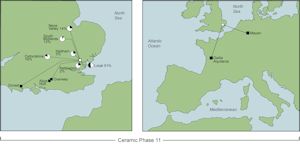
The final decades of the 4th century began to see a fall off in the amount of locally produced pottery and a further increase in the amounts of Romano-British regional traded wares. Locally made wares decline to 65%, while the traded wares rise to 35%. Within the locally made category, fine and sandy grey wares stand at 41% in contrast to the 62% found at Crescent Road (Wickenden 1986, table 11). Meanwhile black-surfaced wares stand at 19%, while Rettendon wares increase slightly to 3%. This is nothing like the 12% for Rettendon ware at Crescent Road.
Romano-British regional traded wares originated from a variety of sources and are strongly represented in all well-dated groups of this period. Fine wares, too, increased in volume and were derived from three sources, the Nene Valley, the Oxfordshire potteries and Hadham. Nene Valley colour-coated ware is the most important fine ware at 11% by EVE, followed by Oxfordshire red colour-coated ware at 3%. Hadham oxidised ware is the least important at just 1%. The range of Oxfordshire products is wider than in any previous period and now includes colour-coated, parchment, white and white-slipped wares. This seems to have been due, not to increased production, but to an expanded market area for the industry at this time. Oxfordshire products account for 12% by weight of the pottery in KPGs 37 and 38.
The only coarse regional traded ware in any quantity is late shell-tempered ware, which accounts for 7% by EVE. Other traded wares at Heybridge comprise Alice Holt grey ware and Portchester D ware, although the quantities are negligible and account for less than 1% by weight in any assemblage. At Crescent Road, Alice Holt grey wares also accounted for less than 1% of the assemblage by weight. The quantities of BB1 are minimal, and, where present, this fabric is clearly residual. There is no evidence for the export into Essex of the latest cooking pot types (cf. Holbrook and Bidwell 1991, fig. 29, type 21). This is in keeping with our overall understanding of BB1, which was not widely distributed subsequent to the loss of the northern markets in the third quarter of the 4th century (Gillam 1976, 59). BB1 is not present at Great Holts Farm, Boreham (Martin 2003).
The amount of imported pottery reaching Heybridge is negligible. Two sources, Aquitania (céramique à l'éponge) and the Rhineland (Mayen ware), are represented, neither of which appear in the selected key pottery groups. Although these fabrics seem to occur in slightly greater quantities compared to Chelmsford, the amounts involved are perhaps not commensurate with trade in ceramics per se. It is likely that the small numbers of vessels represented reached Heybridge as either chattels or as make-weights alongside other commodities. Moreover, neither of these fabrics is recorded at Crescent Road (Wickenden 1986, table 11). As in Ceramic Phase 10, supplies of amphora seem to have all but ceased and, where present, mainly comprise residual Dressel 20 or earlier types. Although not in a quantified group, a single Kapitän 2 'Hollow foot' amphora was recovered from Well 5806, in a fill (5768) dated to the second half of the 4th century.
During the early 5th century, as may be evidenced by KPG39, there was a major decline in the availability of locally made pottery and an upsurge in the amount of Romano-British traded wares. Imports are not evident. The amount of grey wares has fallen to 18% by EVE, while black-surfaced wares declined to just 2%. Rettendon wares have entirely vanished. It is notable that late shell-tempered ware now stands at 34%. This figure is greater than the 15% at Chelmsford (Going 1987, 116) but compares well with the 21% in the 'late shrine' group at Great Dunmow (Going and Ford 1988, table 2). Oxfordshire products account for 31%, the bulk of which comprises red colour-coated ware at 29% by EVE. This figure is far in excess of the 8% seen in the late shrine group at Great Dunmow (Going and Ford 1988, table 2) and the 3% at Chelmsford (Going 1987, table 9). The amount of Nene Valley colour-coated ware remains stable at 9%, while Hadham wares have risen to 6%. Presumably other fabrics like Alice Holt grey ware and Portchester D ware also continued to reach the settlement in small quantities, but it is impossible to say whether supply continued from across the Channel.
In the late 4th century, open and closed forms are present in roughly equal proportions. Open classes account for 48% of the assemblage with a distinct bias in favour of dishes (32%). Next in importance are bowls (8%) followed by mortaria (6%). Lids are exclusively Nene Valley colour-coated 'Castor-box' types (K7) and account for just 1% of the assemblage. Of the dish types, the plain-rimmed B1 predominates with eighteen examples, followed by the bead-and-flanged variety (B6) with sixteen. These forms occur in a variety of local grey and black-surfaced fabrics. The B1.2-type dish in Nene Valley colour-coated ware is the least common variant. A number of fragmentary bead-rimmed B2 and B4 types and the incipient-beaded flange-rimmed B5.1 form were also identified in grey and black-surfaced fabrics, but these are clearly residual. The bulk of the mortaria are derived from the Oxfordshire manufactory with the white ware form, Young's M22 (1977), occurring in reeded and unreeded versions. The other mortarium, a D14-type from the Nene Valley, is residual. Most of the bowl forms occur in Oxfordshire red colour-coated ware and include the form C8, imitating samian f38, and a number of vessels that can be referenced in Young (1977). The C8 also occurs in Hadham oxidised ware alongside several bowl-jars.
Closed forms account for 52% of the assemblage with jars comprising the largest class at 36%, a figure broadly comparable with the 38% seen in Ditch 21 at Great Sampford (Martin 1998, table 3). The forms recorded at Elms Farm comprise the late shell-tempered ware necked jar (G27) and the common late necked jar (G24), which is present in sandy grey ware and Rettendon ware. The G27-type jar is the main jar form in the group at 7%. Of the storage jar types only the high-shouldered G44 is evident and this is likely to be residual. There is thus little sign of the recovery in the incidence of storage jars as seen at Chelmsford (Going 1987, table 10). Indeed, the figures are very much in keeping with those from Crescent Road (Wickenden 1986, table 11). Beakers comprise 9% of the assemblage and consist of folded types in both fine and coarse fabrics. Flagons account for 7% of the assemblage, a figure much lower than the 12% seen at Chelmsford (Going 1987, table 10). The only flagon type present is in Oxfordshire white ware and corresponds to Young's W25 (1977), which is a rare form in Essex.
By the early 5th century, open forms account for 45% while closed forms stand at 55% of the assemblage with jars accounting for 44%. However, leaving aside the dominant late shell-tempered G27 jar, most of the rims are too fragmentary to identify type with any certainty. The only other type certainly identified is a bifid-rimmed vessel similar to the G28. A possible flagon is present in Oxfordshire white-slipped ware, and a sandy grey ware beaker rim of indeterminate form is the only other closed form represented in the group. Next in importance to the jar is the dish category (24%). The main type is the plain-rimmed B1 in Hadham black-surfaced ware (B1.3) and Nene Valley colour-coated ware (B1.2). Bead-and-flanged dishes were only recorded in fine grey ware. Bowls accounted for 18% of all vessels but are exclusively in the fine Nene Valley colour-coated, Oxfordshire red colour-coated and Oxfordshire parchment wares. In Nene Valley colour-coated ware, the range was restricted to the 'Castor-box' (C18) and the E4 bowl-jar. By comparison, the range of Oxfordshire red colour-coated forms recorded is less restricted. These include the ubiquitous C8 and C25 bowls and E4 bowl-jar, as well as Young's forms C69 and C79 (1977). The only identifiable form in Oxfordshire parchment ware was a P17-type bowl (1977). Mortaria account for just 2% of the assemblage and were supplied solely by the Oxfordshire potteries. Although there was considerable fabric diversity, the range of identifiable forms was confined to the wall-sided D12 in red colour-coated ware and the flanged white-slipped ware WC7 (1977, 122).
There is sufficient evidence from the Crescent Road and Elms Farm excavations to indicate settlement activity in the early Saxon period. Continuity of occupation has been argued (Drury and Wickenden 1982, 31-4) and, in order to test this hypothesis against the Elms Farm data, a search was made to identify substantial deposits of latest Roman pottery that also contained large quantities of Saxon sherds. Only one group was identified, the fills of pit 14529 (KPG40). This group was therefore studied to see whether any insights could be provided into the relationship between Romano-British and Anglo-Saxon material cultures.
Although probably residual, the Roman pottery is here discussed entirely from the standpoint of latest Roman supply/production. The aim was to identify any unusual fabrics and forms that were not represented in the three key pottery groups. Several observations are possible. Firstly, there are no unusual fabrics present. This confirms the picture provided by KPG39 in that there is no evidence for contemporary local Romano-British pottery production. Generally, the range of fabrics present is typical of Ceramic Phase 11 contexts and there is nothing to suggest that any of the pottery had been deliberately selected as at West Stow, Suffolk, where there seems to have been a particular liking for red pots (Plouviez 1985, 84).
Perhaps, the only notable feature of the group is the amount of Alice Holt grey ware, at 3% by EVE, and the presence of B6 bead-and-flanged dishes (Lyne and Jefferies 1979, Type 6C) in this fabric. These are exceptionally rare in Essex and are only otherwise known on sites close to the Thames as at Aveley (Martin 2002) and London as at Leyton (Greenwood 1979, fig. 13.76). There is very little dating evidence for these vessels, but what there is suggests that they could be among the latest Romano-British ceramics in Essex.
Even though rare late forms are present in the group it is highly likely that all of the Roman pottery is residual. That this is the case is suggested by the high incidence of grey wares. These account for 30% by EVE of the assemblage, while late fabrics are poorly represented. For instance, late shell-tempered ware stands at just 3%, a figure more typical of late Ceramic Phase 10 horizons. The research archive contains a study that further investigates the types of pottery deposited, and the condition of the sherds, in these and other selected groups. The results are interesting; one conclusion appears to confirm that low amounts of late Roman fabrics are, indeed, more likely to indicate a 5th-century assemblage.
Internet Archaeology is an open access journal based in the Department of Archaeology, University of York. Except where otherwise noted, content from this work may be used under the terms of the Creative Commons Attribution 3.0 (CC BY) Unported licence, which permits unrestricted use, distribution, and reproduction in any medium, provided that attribution to the author(s), the title of the work, the Internet Archaeology journal and the relevant URL/DOI are given.
Terms and Conditions | Legal Statements | Privacy Policy | Cookies Policy | Citing Internet Archaeology
Internet Archaeology content is preserved for the long term with the Archaeology Data Service. Help sustain and support open access publication by donating to our Open Access Archaeology Fund.